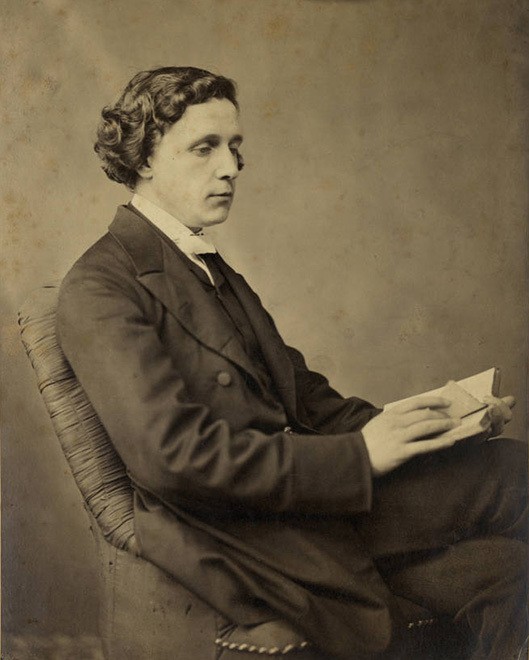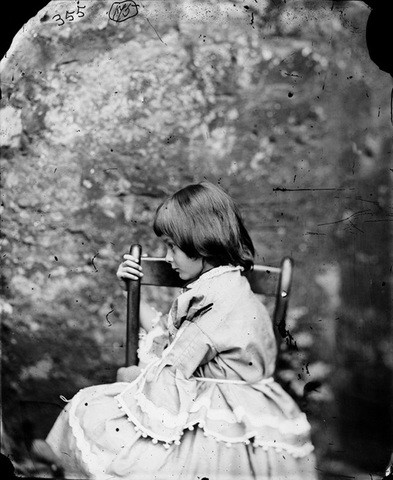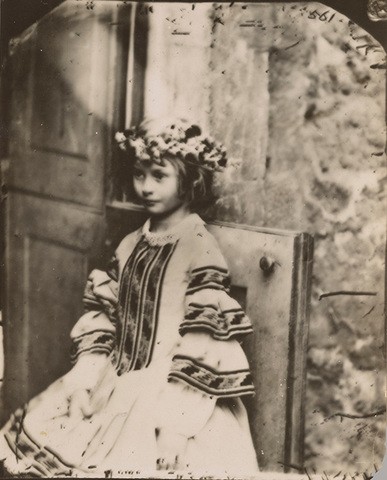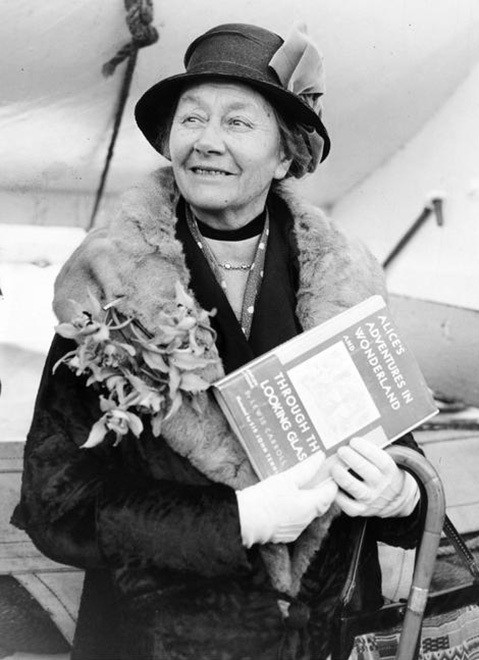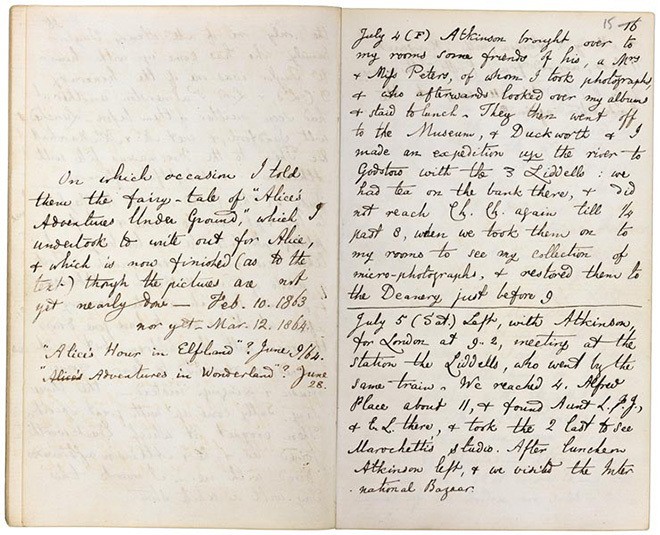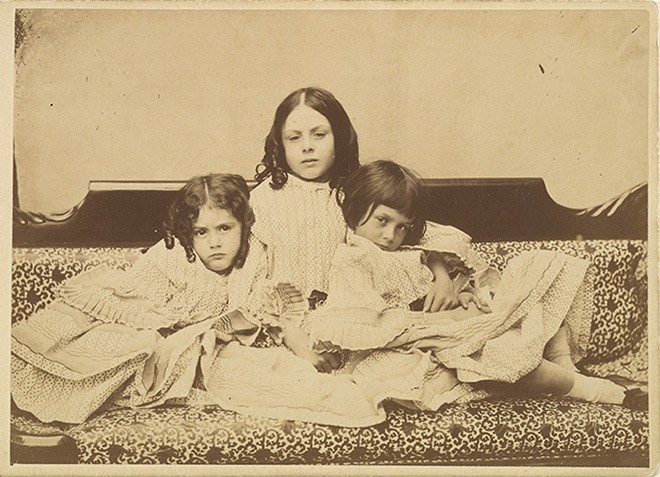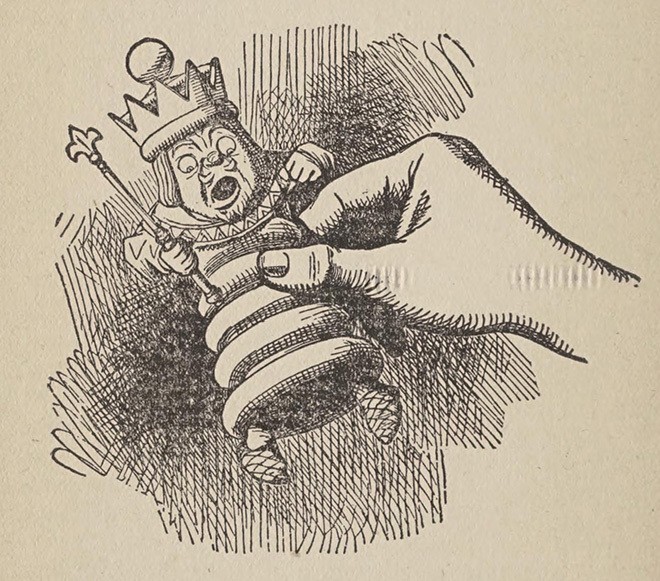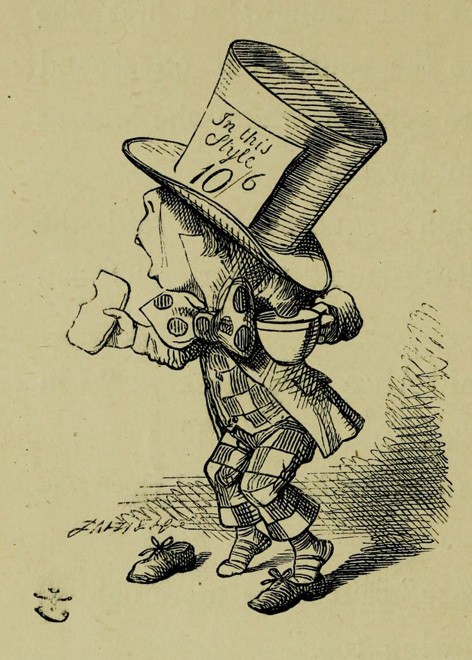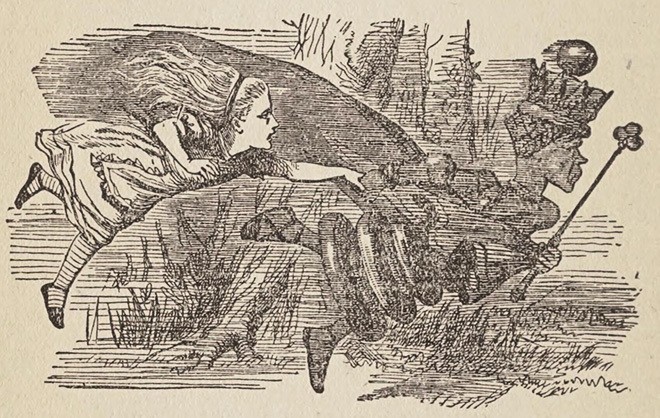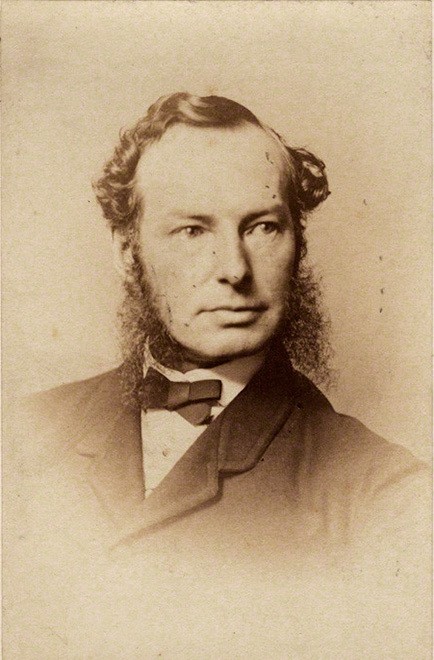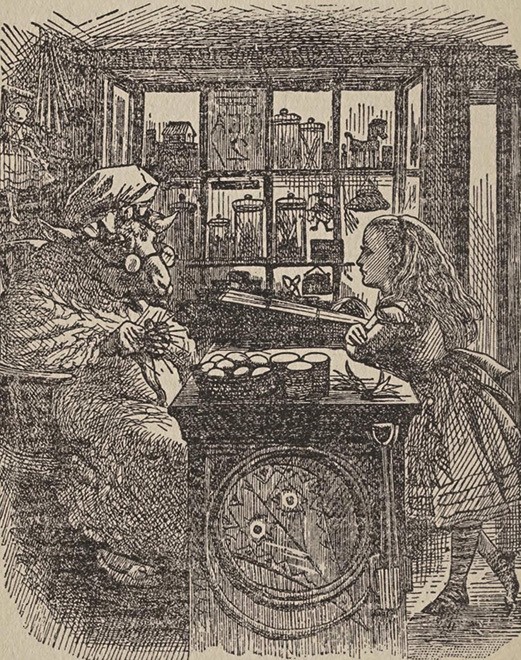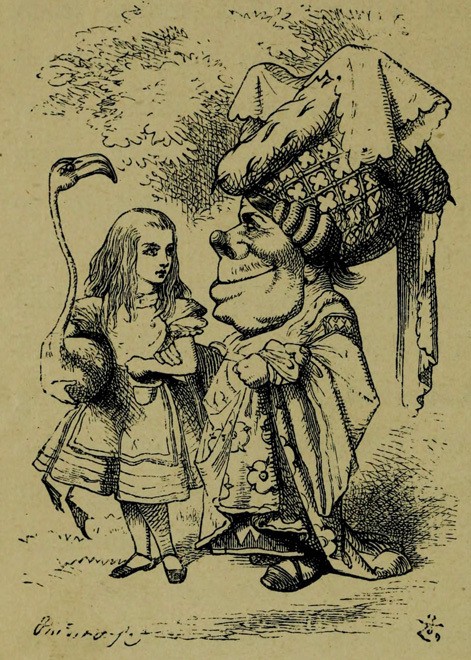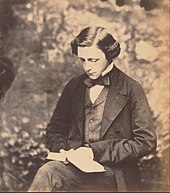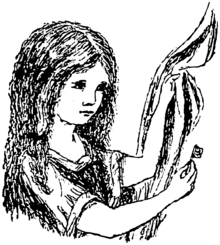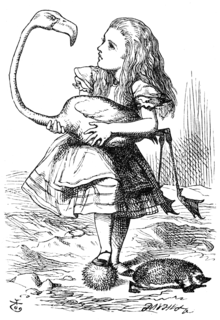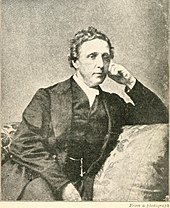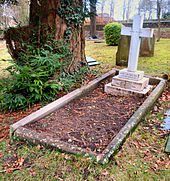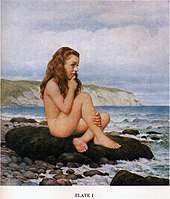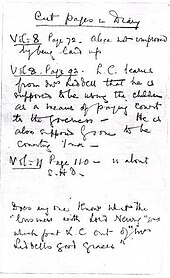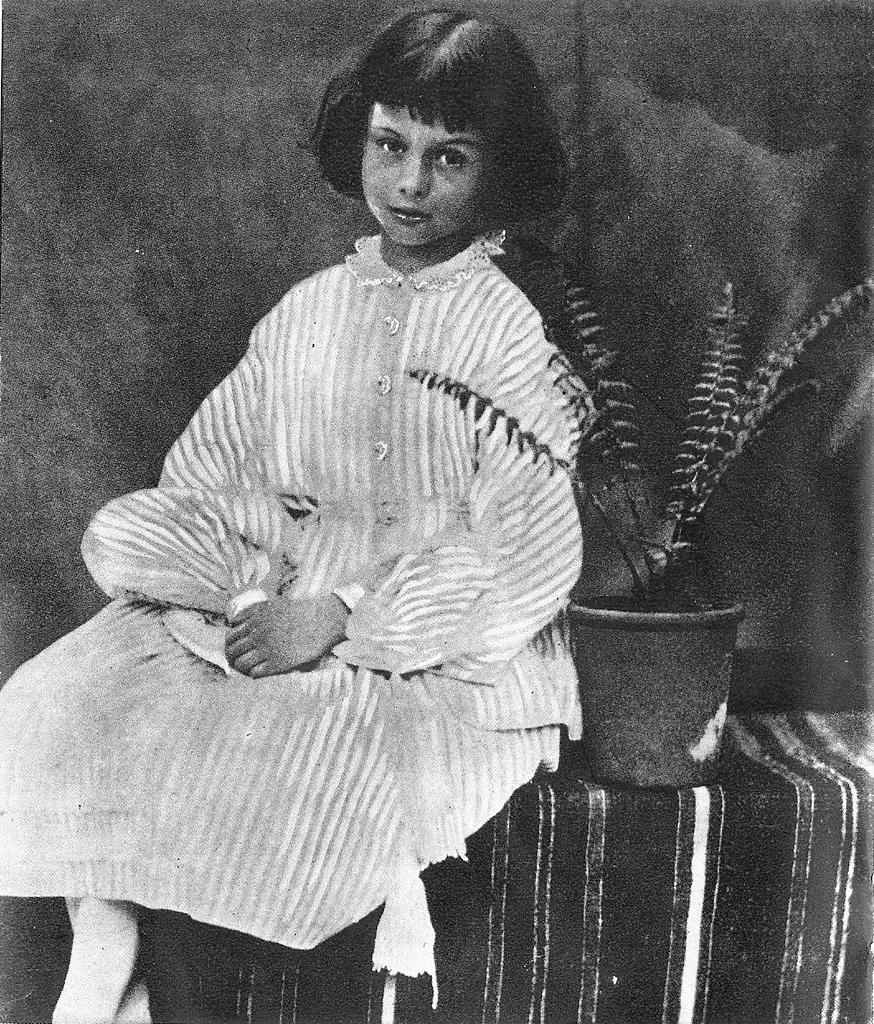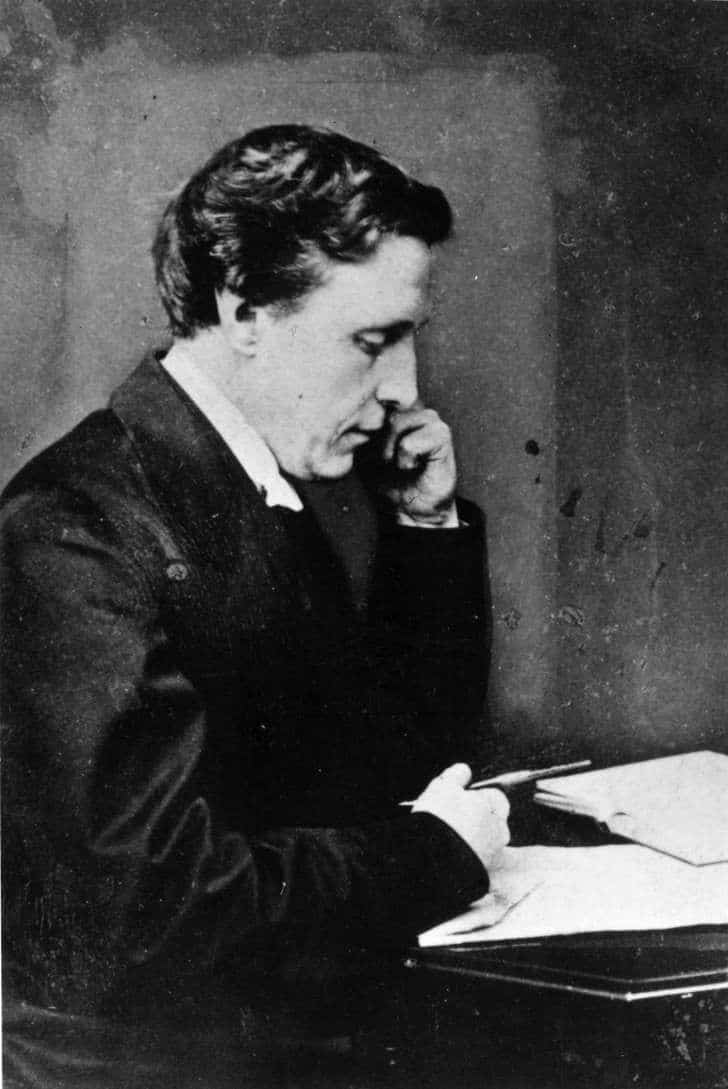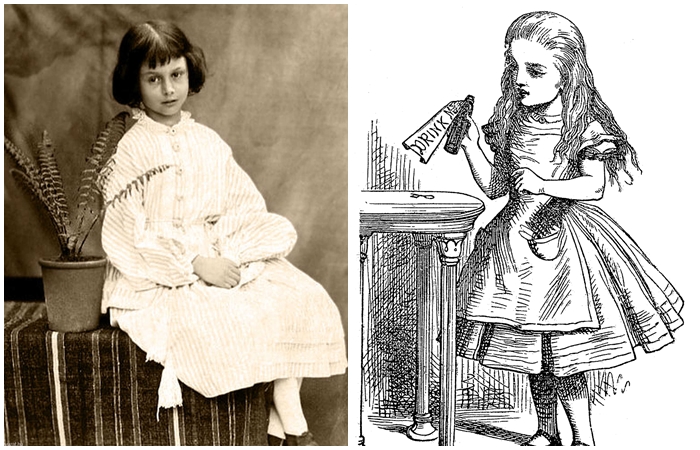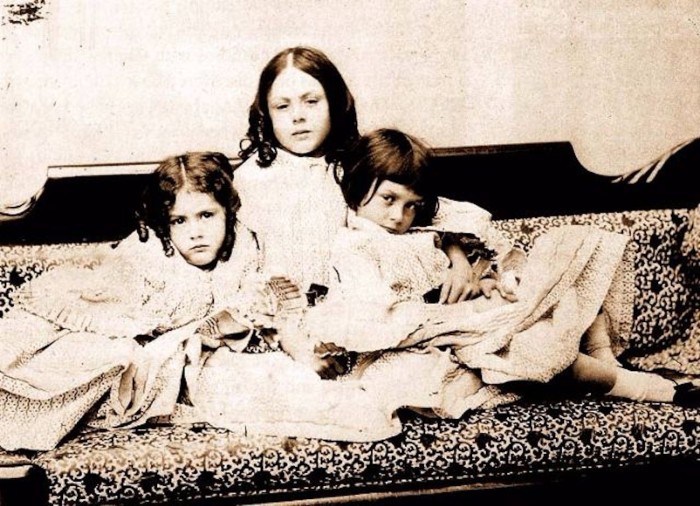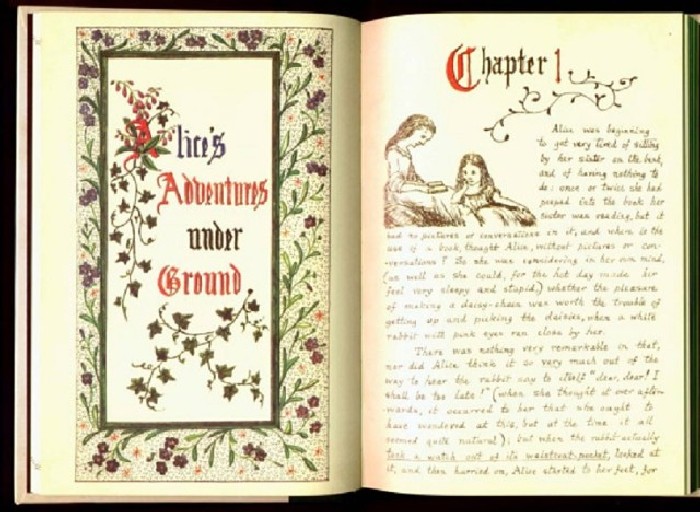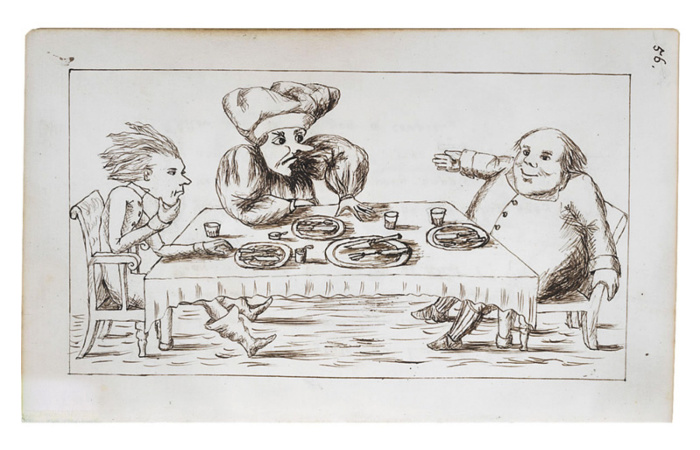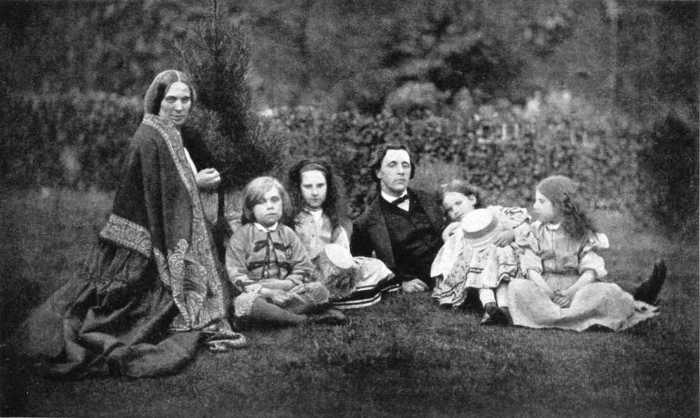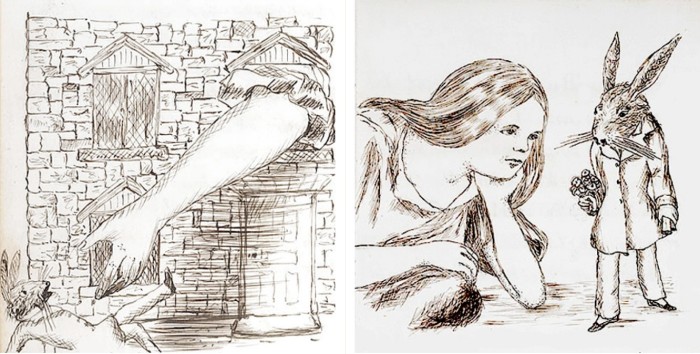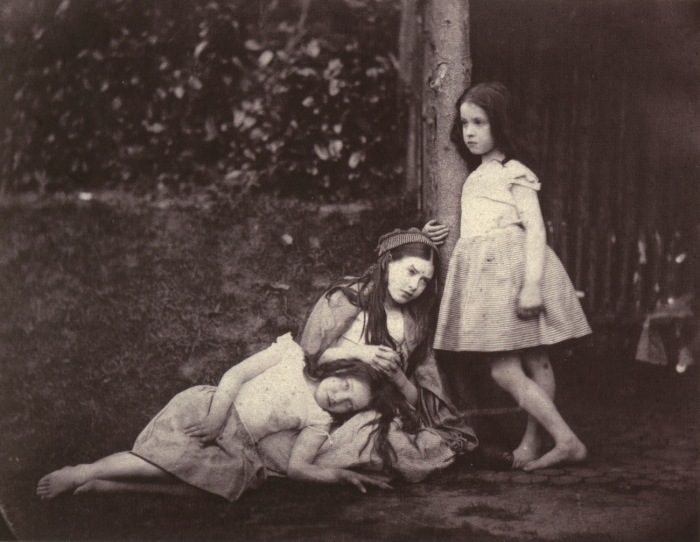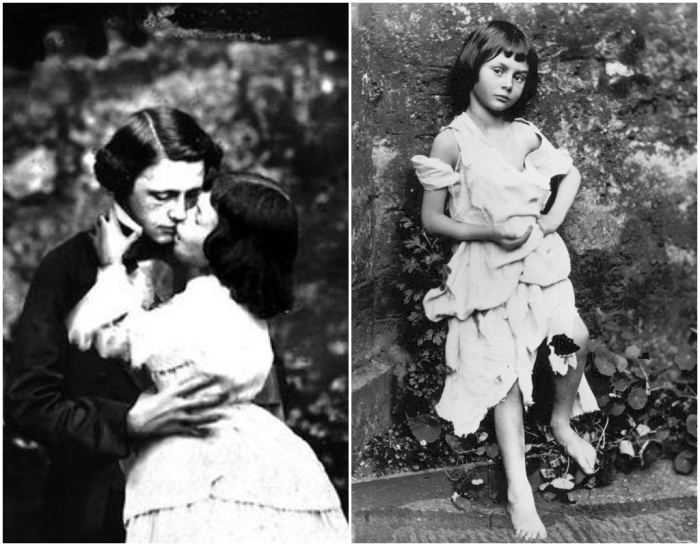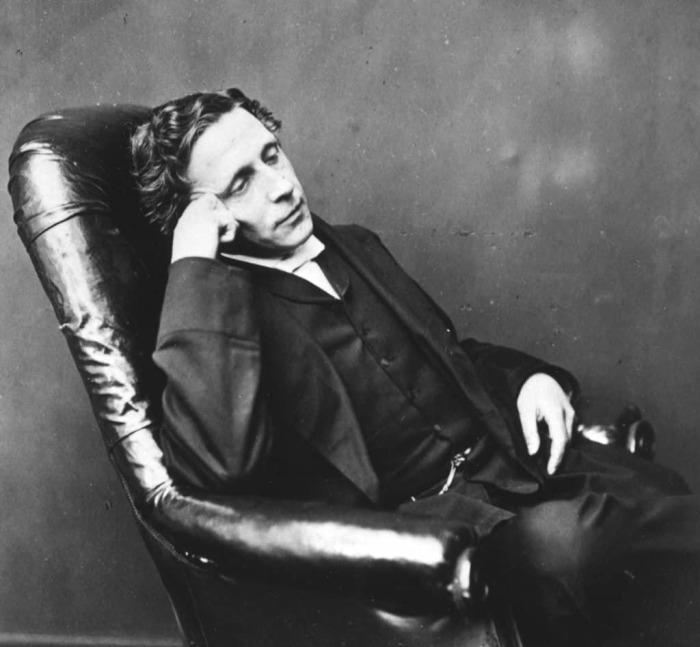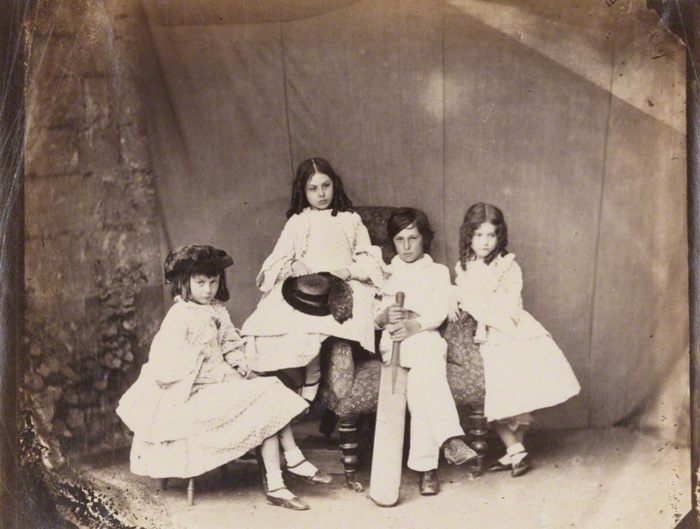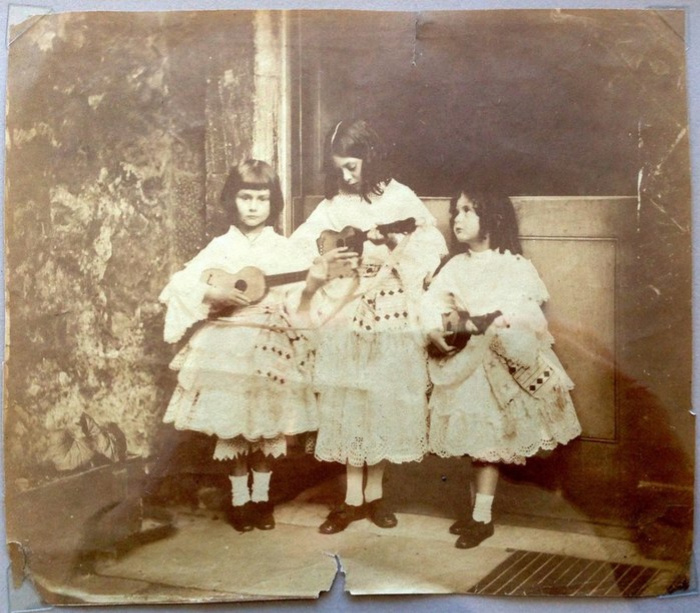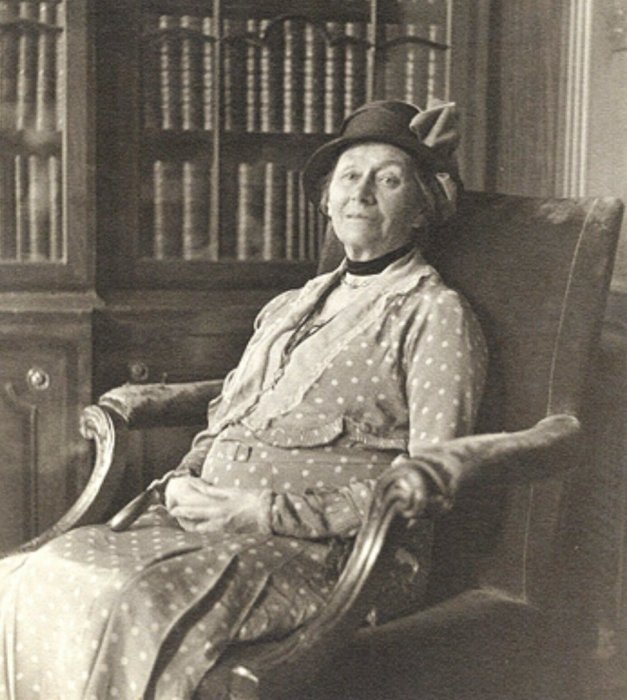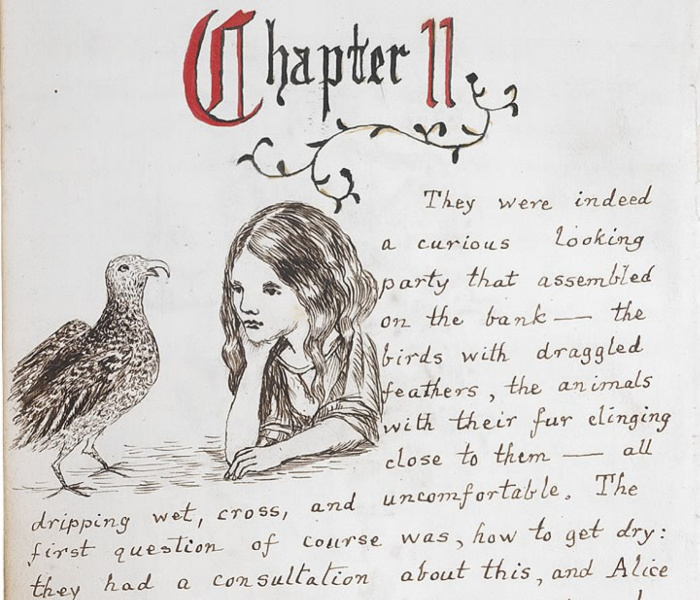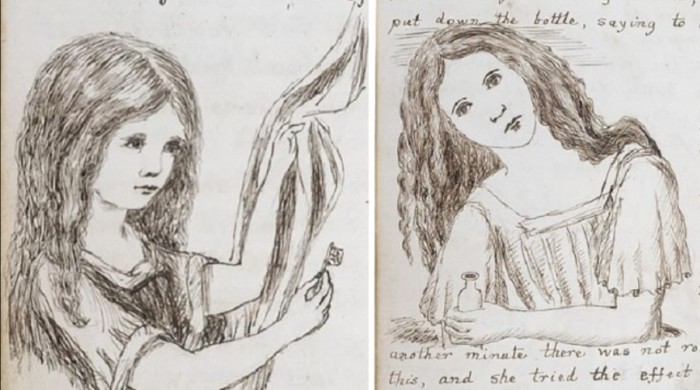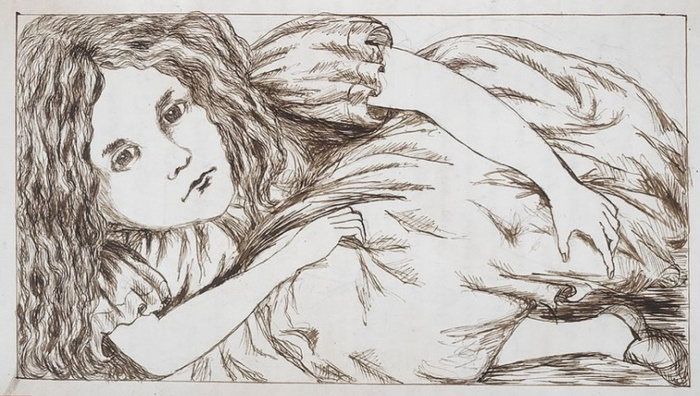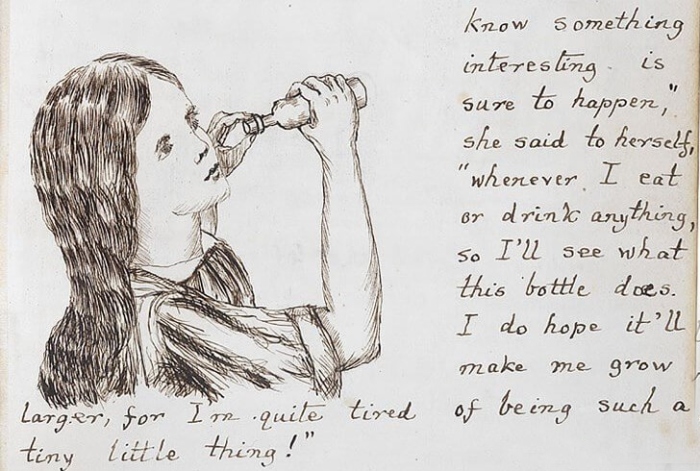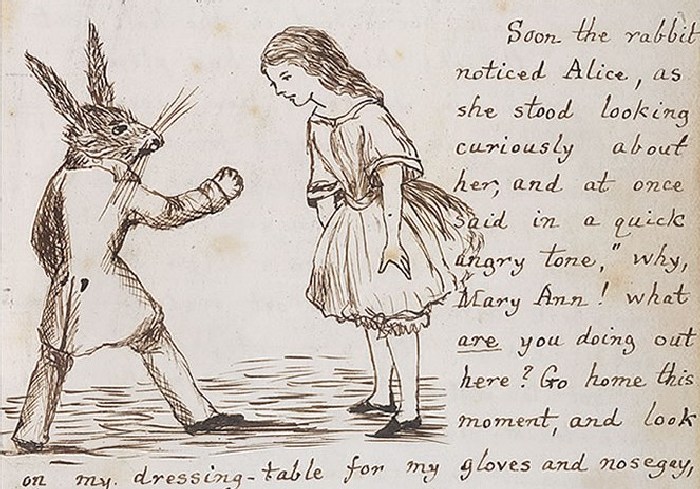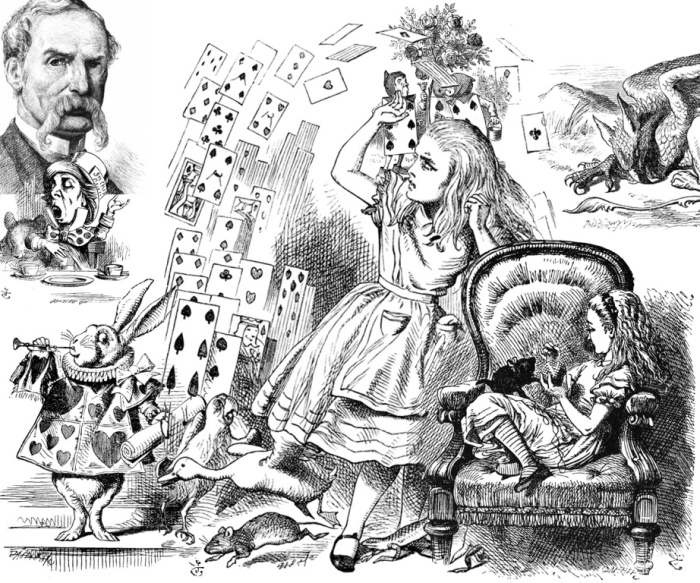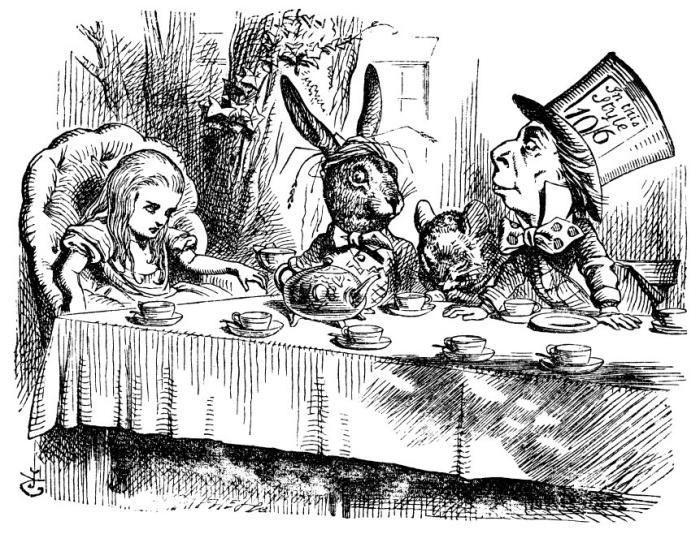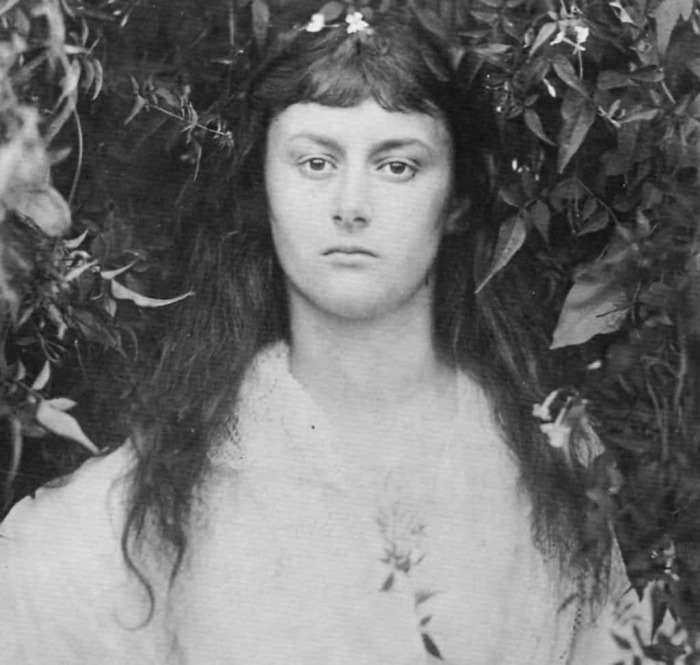История создания знаменитых книг, фантазии автора и трактовки учёных.
Чуть больше полутора веков назад вышла одна из самых неоднозначных сказок в истории литературы — «Алиса в Стране чудес» Льюиса Кэрролла. Редко какое произведение, предназначенное для детской аудитории, вызывало столько споров и обсуждений. Конечно, нередки случаи, когда писатели закладывали в сказочные истории вполне взрослые мысли — достаточно вспомнить «Маленького принца» Антуана де Сент-Экзюпери или «Муми-троллей» Туве Янссон.
Но всё же «Алиса в Стране чудес» и её продолжение, «Алиса в Зазеркалье», уникальны. Их обсуждали лингвисты, физики, математики, философы, историки, психологи, в общем, представители самых разных наук. И каждый видел в отдельных сценах какой-то глубокий смысл. Причём сейчас уже доподлинно трудно сказать, в каких моментах подтекст действительно присутствует, а где учёные выдают свои мысли за идеи Кэрролла.
Льюис Кэрролл: математик, сказочник, фотограф, изобретатель
Чарльз Лютвидж Доджсон, как на самом деле звали писателя (хотя сам он произносил свою фамилию как Додсон), был известен не только благодаря литературному таланту. Сначала его знали как выдающегося учёного и просто неординарную личность.
Родился Доджсон 27 января 1832 года в семье приходского священника в одной из деревушек графства Чешир. С самого детства он проявлял сообразительность и изобретательность: придумывал игры с подробными правилами, строил театр марионеток и показывал фокусы. Но главное, он очень любил сочинять истории и стихи и даже «издавал» (то есть писал от руки) домашний журнал.
Когда Чарльз подрос, он отправился учиться в колледж Крайст-Чёрч в Оксфорде. С этим учебным заведением впоследствии была связана большая часть его жизни. Несмотря на посредственные успехи в учёбе, Доджсон проявлял незаурядные способности к математике и вскоре начал зарабатывать чтением лекций. Правда, для этого ему пришлось принять духовный сан и обет безбрачия. Но многие считают, что брак Чарльза и так не очень волновал.
Доджсона можно назвать ярким примером поговорки «талантливый человек талантлив во всём». Помимо лекций и серьёзных математических трудов он придумывал задачи для детей и взрослых и хорошо играл в шахматы. Именно он изобрёл упрощённый метод перевода денег в банке, когда отправитель заполняет два бланка и сообщает код получателю.
А ещё Доджсон придумал «никтограф» — устройство для быстрой записи в темноте — и много других любопытных приспособлений. Кроме того, он любил фотографировать, в основном природу или детей. Многие из тех, кто знал Чарльза, говорили, что если бы он не прославился как писатель, то точно вошёл бы в историю благодаря какой-нибудь другой деятельности.
Но всё же людям запомнился именно литературный талант Доджсона. Он с детства любил «играть словами», позже придумал игру в «дуплеты» — когда в исходном слове меняется одна буква, пока оно не превращается в заданное (например, сделать из «мухи» — «слона»). А потом его стихи и прозу начали печатать и в журналах.
Именно тогда и «родился» Льюис Кэрролл. Всё-таки видному учёному, да ещё и с духовным саном, не пристало печататься под своим именем. И писатель занялся своим любимым делом — игрой в слова.
Псевдоним появился следующим образом: Доджсон взял свои имена Чарльз Лютвидж (первое он получил в честь отца, второе — девичья фамилия матери) и перевёл их на латынь. Получилось Carolus Ludovicus. Потом поменял местами и перевёл обратно, выбрав другие соответствия — Льюис Кэрролл. Под этим псевдонимом он и издал свои главные работы.
Кэрролл и Алиса
Льюис Кэрролл всегда любил общаться с маленькими девочками. Однако все разговоры о педофилии смело можно считать спекуляцией: нет ни одного упоминания о его непристойном поведении ни от самих девочек, ни от их родителей. Подобные слухи во многом связаны с тем, что семья Кэрролла после его смерти избавлялась от излишних упоминаний о его связи со взрослыми женщинами (видимо, из-за обета безбрачия). Так и возник миф о его увлечении исключительно детьми.
Скорее всего, дело совершенно в другом. Кэрролла всегда описывают, как застенчивого человека. Он очень смущался в обществе взрослых и серьёзных людей. А учитывая врождённое заикание, часто стеснялся даже заговорить. Только в обществе детей он чувствовал себя свободно, ведь с ними Кэрролл мог раскрыть свой талант сказочника, придумывая на ходу истории, которые приводили их в восторг.
С Алисой Лидделл, которая и стала главным (но не единственным) прообразом героини легендарной книги, писатель познакомился в 1856 году, когда в колледж, где он читал лекции, приехал новый декан Генри Лидделл со своей семьёй. В апреле 1856 года Кэрролл случайно столкнулся с Лидделлом, когда фотографировал собор. Они заговорили и вскоре подружились.
Льюис Кэрролл часто бывал в гостях у Лидделлов, там он и познакомился с юной дочкой декана Алисой. На момент приезда ей было всего четыре года. Вскоре Алиса стала любимой моделью Кэрролла. Наиболее известна её фотография «Алиса Лидделл в образе нищенки». На самом деле, это часть диптиха, но почему-то второй кадр, где девочка практически в той же позе, но хорошо одета, менее знаменит.
Как всё началось
По словам самих участников событий, история легендарной «Алисы в Стране чудес» берёт своё начало 4 июля 1862 года, когда Льюис Кэрролл и его друг Робинсон Дакворт отправились на лодочную прогулку с тремя дочерьми Лидделлов: десятилетней Алисой, её старшей сестрой Лориной Шарлоттой и младшей Эдит Мери.
Дети упрашивали Кэрролла рассказать какую-нибудь сказку, и он на ходу придумал историю девочки Алисы, которая провалилась в глубокую яму и попала в причудливое подземное царство.
Как ни странно, позже многие высказывали сомнения, что Кэрролл придумал сказку именно 4 июля. В первую очередь стали проверять слова писателя и самой Алисы — те говорили, что день был очень жаркий и солнечный. А если судить по архивам синоптиков, именно 4 июля было прохладно и пасмурно.
На самом деле, подобные факты наверняка волнуют только самих историков. Возможно, они перепутали этот день с какой-то другой прогулкой, возможно, в архивах есть ошибка. А скорее всего Кэрролл начал придумывать какие-то отрывки ещё раньше — есть упоминания о чтении отдельных строк ещё в 1850-х.
Но точно одно: во время одной из прогулок Кэрролл рассказал Алисе и её сёстрам сказку о приключениях семилетней девочки под землёй. Позже сёстры неоднократно просили продолжить историю, а Алиса требовала записать сказку.
И пусть там будет побольше всяких глупостей.
Алиса Лидделл
Разумеется, изначально история была значительно короче, и в сказке не было части событий и даже многих героев. Подаренная Алисе спустя два года на рождество рукопись «Приключение Алисы под землёй» насчитывала всего четыре главы. Зато в конце Кэрролл добавил фотографию Алисы в семилетнем возрасте как главную иллюстрацию.
Потом он неоднократно дорабатывал сюжет. Со временем в нём появились «безумное чаепитие» и его участники, Чеширский Кот, суд над Валетом и некоторые другие сцены. Но неуверенный в себе Кэрролл всё ещё сомневался, стоит ли издавать книгу.
Тогда он решил провести своеобразную проверку: попросил своего друга Джорджа Макдональда зачитать сказку детям. Те остались в полном восторге. А Макдональд посоветовал Кэрроллу ещё и напечатать собственные иллюстрации. Но тот не верил в свой талант художника и обратился к Джону Тенниелу.
Интересно, что в качестве примера образа главной героини автор отправил художнику фотографию не Алисы Лидделл, а другой своей юной подруги — Мэри Хилтон Бэдкок. Однако доподлинно неизвестно, использовал ли Тенниел хоть какие-то рекомендации Кэрролла при создании рисунков. Скорее всего, он ориентировался исключительно на своё воображение.
Но, похоже, Кэрролл не слишком заботился о портретном сходстве. В книге описание Алисы даётся только в общих чертах, автору были важнее эмоции и фантазии, а не описание героини. Ведь он и так знал, кому посвящена книга.
Традиционная сказка
Если разбирать действие «Алисы» поверхностно, как это сделали бы дети, то перед нами простейшая сказка. Её действие развивается абсолютно линейно: девочка просто переходит из одной локации в другую, проходя различные метаморфозы и встречая сказочных персонажей.
После падения она сталкивается с группой животных, которые рассказывают друг другу истории. Потом попадает в дом Белого Кролика, получает мудрый совет от Гусеницы, проводит время на «безумном чаепитии», играет в крокет с Королевой и слушает историю черепахи Квази.
Всё действие легко запомнить и пересказать. Как принято в сказках, добрые герои помогают Алисе и дают советы, злые — мешают и чаще всего сами попадают впросак. Структуру сказки можно сравнить практически с любой классической историей для детей. Хотя есть и несколько отличий.
Во-первых, Кэрролл не выводит какой-либо морали. Здесь нет конкретной победы добра над злом. Скорее всего, это связано как раз с тем, что автор придумывал сюжет «на ходу», не заботясь о финале.
Во-вторых, Кэрролл связал действие сказки с играми. Часть персонажей представляет из себя колоду карт: Король и Королева управляют страной, а мелкие карты им подчиняются. Это связано с любовью автора выдумывать различные новые правила для игр.
То же самое прослеживается в сцене с крокетом. У Кэрролла был свой вариант этой забавы под названием «Крокетный замок», и он даже опубликовал новую версию правил. Кстати, в изначальном варианте книги, вместо молотков герои пользовались не фламинго, а страусами.
Ну а в-третьих, значительная часть шуток в «Алисе» построена на различной игре слов, каламбурах и пародиях на старые стихи и песни.
Беда лингвистов и переводчиков
Именно из-за своей «языковой» особенности «Алиса в стране чудес» быстро привлекла внимание лингвистов, филологов и прочих гуманитариев. В повествовании Кэрролл использовал старые и редкие слова, которые уже на тот момент не употребляли в речи. А заодно он придумывал новые — различить, где использовано действительно устаревшее понятие, а где выдумка автора, получается не сразу.
Кроме того, Кэрролл нередко прибегал к игре слов, причём зачастую шутки предназначались явно не для детей. Думая, что она скоро пролетит сквозь землю, Алиса пыталась вспомнить, как называют людей из Австралии: «Как их там зовут?.. Антипатии, кажется». Вряд ли маленькие читатели без пояснений поймут, что на самом деле имелись в виду «антиподы».
Во время «безумного чаепития» Шляпник загадывает Алисе загадку: «Чем ворон похож на письменный стол?» Этот вопрос чуть не стал камнем преткновения среди любителей языка и философии. Появились варианты «[Эдгар Алан] По писал о/на них обоих», «У обоих есть перья, смоченные в чернилах». А Олдос Хаксли даже предложил на безумный вопрос ещё более безумный ответ: because there’s a ‘b’ in both, and because there’s an ‘n’ in neither (вряд ли это можно понятно перевести на русский).
Сам же Кэрролл впоследствии признался, что он специально сочинил загадку без ответа и даже не собирался её как-то объяснять. Но после шквала вопросов писатель всё-таки придумал свой вариант: «Because it can produce a few notes, tho they are very flat, and it is nevar put with the wrong end in front». Опять же, на русский это просто так перевести не получится. Условно, Кэрролл говорит, что и от стола, и от ворона можно получить несколько notes, которые будут flat. Это словосочетание можно перевести двояко: «записи» — в случае со столом, и «ноты» — в случае с вороном (а flat — это бемоль в переводе, то есть понижение ноты на полутон).
А уж переводчиков эта книга и вовсе ставила в тупик. Ведь им нужно было постараться передать и содержание, и юмор, и игру слов. Зачастую это было совсем непросто. В первой же сцене есть самый простой пример. Падая, Алиса от скуки задумывается: «Do cats eat bats?» — то есть: «Едят ли кошки летучих мышей?» А потом, засыпая, произносит: «Do bats eat cats?»
Это один из самых простых примеров игры слов от Кэрролла, но с ним уже возникают трудности при переводе. В результате автор наиболее популярной русской версии, Нина Демурова (в данной статье приведены примеры из её перевода), предложила вариант: «Едят ли мошки кошек?» — поскольку «летучие мыши» уже разрушают лёгкость речи. Автор ещё одного известного перевода — Борис Заходер — в предисловии к своей версии даже писал, что долгое время планировал издать книгу «К вопросу о причинах непереводимости на русский язык сказки Льюиса Кэрролла».
Дальше всё становится только запутаннее. Например, почти вся глава «Повесть Черепахи Квази» построена только на игре слов. Причём таких, что на русском у них просто нет аналогов. Например, Черепаха произносит фразу: «The master was an old Turtle — we used to call him Tortoise», — то есть их учителем была морская черепаха, которую они называли сухопутной (в английском языке это два разных слова).
А на вопрос Алисы, почему они так поступали, Квази ответил: «We called him Tortoise because he taught us», — здесь используется созвучие слов. В итоге Демурова написала в переводе, что учителя звали Спрутиком, потому что он ходил с прутиком. А Заходер превратил его из черепахи в Удава, которого называли Питоном, потому что ученики были его «питонцами».
А уж различные «науки», о которых говорит Квази, каждый переводил на свой лад, ведь все они созвучны с реальными школьными предметами: «Reeling, Writhing […] and then the different branches of Arithmetic — Ambition, Distraction, Uglification, and Derision». В переводе Демуровой это звучит как: «Чихали и Пищали […], а потом принялись за четыре действия Арифметики: Скольжение, Причитание, Умиление и Изнеможение».
Ещё сложнее обстояли дела со стихами и песенками. Кэрролл сочинял их не просто так: почти все они основаны на каких-то классических английских стихах. Видимо, автору было легче придумывать шутки, отталкиваясь от уже имеющейся структуры.
При этом Алиса, читая стихи, нередко путает их друг с другом, вставляя строчки из других произведений. В результате чего филологам приходилось разбирать, что же легло в основу того или иного отрывка. Переводчикам же это добавило новых проблем, ведь нужно сохранить и смысл, и размерность стиха. А иногда ещё и форму — в главе «Бег по кругу» появляются и «фигурные стихи» в форме мышиного хвоста.
При этом ни русские, ни английские дети даже не пытались анализировать построение языка или точность перевода. Их просто развлекали смешные слова и абсурдные ситуации. И уж тем более они не вдумывались в вероятный научный подтекст произведения.
Научная страна чудес
«Алиса» привлекла внимание не только лингвистов и филологов. Зная, что Кэрролл был ещё и математиком, и изобретателем, в книге ищут намёки на различные реальные и мысленные физические опыты, отсылки к космологии, истории и десяткам других наук.
Здесь можно вернуться всё к тому же падению Алисы под землю и её мыслям, что она пролетит планету насквозь. Эта тема нередко фигурировала в научной и фантастической литературе. Рассуждали даже о возможности создания тоннеля, по которому будет двигаться «гравитационный поезд» под действием одной только силы тяжести. Правда, чтобы это реализовать, придётся как-то исключить силу трения, сопротивление воздуха и силу Кориолиса. Кэрролл, кстати, и сам более серьёзно писал об этой теме в другой своей книге — «Сильвия и Бруно».
Хотя иногда учёные, будто соревнуясь друг с другом, пытаются придумывать всё более сложные трактовки слов Кэрролла даже там, где этого делать не стоит. Например, во время полёта Алиса хватает с полки пустую банку из-под апельсинового джема, но боится уронить её кому-нибудь на голову, а потом ставит на полку. Здесь одни увидели предсказание «Лифта Эйнштейна» — Кэрролл наверняка знал, что банка не может полететь вниз быстрее Алисы. Другие рассуждали о «двойном чуде», одно из которых произошло (Алиса на лету поставила банку на полку), а другое — нет (банка не полетела вниз).
Но если это кажется странным, то следует обратиться к книге Шана Лесли «Льюис Кэрролл и Оксфордское движение», где он пытается доказать, что апельсиновое варенье здесь выступает в роли символа протестантизма (оранжевые апельсины, по его мнению, связаны с Вильгельмом Оранским).
И точно так же простейшие ошибки Алисы, когда она вспоминает таблицу умножения, некоторые математики подводят под операции в восемнадцатеричной системе счисления.
Значит так: четырежды пять — двенадцать, четырежды шесть — тринадцать, четырежды семь… Так я до двадцати никогда не дойду!
Алиса
Действительно, это укладывается в вычисления при основании 18. Но, быть может, девочка просто перепутала слова «двенадцать» и «двадцать» и вообще плохо знала, как перемножать числа. Книга, всё-таки, детская.
В книге находят и намёки на расширение и сужение вселенной в сценах, где Алиса начинает есть и пить всё подряд, из-за чего то растёт, то уменьшается. Бег животных по кругу (с целью просохнуть после вынужденного купания) связывают с теорией эволюции.
А когда дело доходит до «безумного чаепития», учёные вспоминают об остановившихся часах Шляпника. Астрофизик Эддингтон увидел в этом намёк на модель той части космоса, где время остановилось. Именно поэтому герои остались ровно во времени чаепития, и бесконечно повторяют одни и те же действия, а мышка Соня никак не может проснуться.
Реальные герои сказки
Обо всех этих темах учёные могут спорить бесконечно. А вот о чём можно говорить с уверенностью, так это о реальных прообразах многих персонажей — и речь здесь не только об Алисе. Хотя, несмотря на перемену во внешности, автор явно намекает на юную Лидделл: действие происходит 7 мая — ровно в её день рождения, а Дина, о которой девочка вспоминает — её кошка.
Второстепенные герои и даже ситуации в «Алисе» явно списаны с реальности. Например, после того, как Алиса, увеличившись в размерах, наплакала целое море, вокруг неё собралось множество забавных животных. Это воспоминания о другой совместной прогулке Кэрролла и Лидделлов, когда они попали под дождь и сильно вымокли.
А необычные существа — участники этого похода. Робин Гусь — уже упомянутый друг автора Робинсон Дакворт (в оригинале он был просто the Duck, но переводчикам пришлось добавить имя для узнаваемости). Птица Додо — сам Кэрролл. Из-за заикания он иногда произносил свою фамилию «До-до-дожсон», что было поводом для шуток. Попугайчик Лори и орлёнок Эд — сестры Алисы Лорина и Эдит.
Не менее интересны и герои «безумного чаепития». Шляпник и Мартовский заяц скорее выступают ожившими поговорками «безумен, как шляпник» и, соответственно, «безумен, как мартовский заяц». Причём с происхождением второй всё ясно — в марте зайцы скачут по полям, как сумасшедшие. А вот насчёт первого историки так и не пришли к однозначному выводу. То ли фраза произошла от того, что шляпники травились парами ртути при работе с фетром. То ли просто с годами в поговорке «Безумен, как гадюка» слово adder (гадюка) сменилось на hatter (шляпник).
Хотя многие ещё вспоминают некоего торговца мебелью и очень эксцентричного человека Теофилиуса Картера, жившего неподалеку от Оксфорда. Его также прозвали «Безумным Шляпником» из-за привычки носить цилиндр и множества эксцентричных идей. Например, Картер придумал «кровать-будильник», которая сбрасывала спящего на пол в нужное время. Не оттого ли Шляпник в книге так хочет разбудить Соню?
Что же касается Сони, то, скорее всего, это намёк на ручного вомбата одного из друзей Кэрролла Данте Габриэля Росетти. Писатель часто бывал в гостях у этой семьи и периодически заставал животное спящим на столе. А традиция держать мышек-сонь в чайниках с сеном была вполне привычной для Англии тех времён.
А вот происхождение Чеширского Кота остаётся загадкой. Его имя и внешность явно произошли от поговорки «Улыбается как Чеширский кот». Но вот появление самой этой фразы неясно. Есть версии, что в графстве Чешир, где родился Кэрролл, на сырных головах вырезали морды улыбающихся котов. Также есть легенда о художнике, который рисовал подобных котов на тавернах. Получается, что здесь автор от реальных героев снова переходит к фольклору.
Критика сна
Странное смешение сказки, личных воспоминаний и сложных каламбуров Кэрролл объяснил в книге самым простым образом: на самом деле, всё происходящее — сон девочки, задремавшей в саду. Разумеется, это сразу исключает любые претензии к логике повествования. Причём в самом финале автор ещё больше усложняет действие: сестра Алисы начинает видеть её сон.
Как понятно из дневников Кэрролла, его очень интересовала тема реальности во сне. Он писал: «Сон имеет свой собственный мир, и зачастую он так же реалистичен, как и сама жизнь». Вероятно, это во многом связано и с его пристрастием к фантазиям и сказкам. Достаточно вспомнить, что Кэрролл любил придумывать новые правила к старым играм. Точно так же, создавая сказочные миры, он мог добавить в них свои правила, которые сильно отличаются от обычных. Нужно лишь принять их.
Но критики далеко не сразу оценили попытки Льюиса Кэрролла. Книгу стали считать кладезем мудрости лишь спустя десятилетия, а в первые годы отзывы о ней были в лучшем случае сдержанными. Автора хвалили лишь за владение языком, а вот сюжет называли «слишком запутанным» и «перегруженным». Парадоксально, но сказке, которая впоследствии станет эталоном абсурдного юмора, ставили в вину бессмысленность сюжета и отсутствие логики.
Однако Льюиса Кэрролла это не остановило: спустя шесть лет вышло продолжение под заголовком «Сквозь зеркало, и что там нашла Алиса» или, как чаще его называют, «Алиса в Зазеркалье».
Зеркала и шахматы
Придумывая вторую книгу, Кэрролл во многом использовал те же приёмы, но удивительным образом сумел не уйти в самоповторы. Здесь ему вновь помогли любимые занятия — в первую очередь, шахматы. Автор построил сюжет в виде шахматной партии, а оглавление книги сделал в виде описания ходов.
Правда шахматисты могут заметить, что многие ходы нелогичны, а их порядок порой нарушается. Но это снова придирки, ведь по сюжету всё та же Алиса сидит за шахматной доской со своим котёнком и засыпает. Вполне ожидаемо, что ребёнок может что-то перепутать.
Главное, что сохранена основа. В первой книге героями были игральные карты, в продолжении же Кэрролл заменил их шахматными фигурами, а саму Алису сделал пешкой. При этом все они двигаются по доске строго по правилам шахмат, а главная героиня может разговаривать только с теми, кто находится на соседней с ней клетке. И логично, что она играет за белых — всё-таки этот цвет связан с добром и детской невинностью.
Тут есть интересная тонкость, которая не очень заметна русскому читателю. В оригинале принятые у нас чёрные фигуры были красными. И поэтому Король и Королева вполне коррелировали с главными злодеями из Страны чудес.
Сюжет снова очень прост: Алиса должна пройти до конца шахматного поля, чтобы из пешки превратиться в королеву. Белые фигуры ей помогают, чёрные — мешают. А заодно девочка общается со всякими причудливыми существами и слушает интересные истории.
Эта книга, как и «Страна чудес» получилась почти случайно: Кэролл учил Алису Лидделл и её сестёр шахматам, а для лучшего запоминания ходов придумывал различные шутки и сказки.
Но писатель увидел в шахматах не только возможность построения сюжета. Он взял за основу само изначальное расположение фигур напротив друг друга. И тогда ему пришла мысль о Зазеркалье — месте, где всё симметрично, но при этом наоборот. К этому можно прибавить распространённое мнение, что вторая книга посвящена не одной, а сразу двум девочкам. Кроме уже подросшей Алисы Лидделл музой Кэрролла называли его дальнюю родственницу Алису Рейкс.
— Сначала скажи мне, — проговорил он, подавая мне апельсин, — в какой руке ты его держишь.
— В правой, — ответила я.
— А теперь, — сказал он, — подойди к зеркалу и скажи мне, в какой руке держит апельсин девочка в зеркале.
Воспоминания Алисы Рейкс о Льюисе Кэрролле
Хотя вступительное стихотворение, где автор грустит о том, что героиня выросла и забыла его, всё же намекает на воспоминания о временах создания первой книги. Тем более, что в фантазии Кэрролла Алиса повзрослела всего лишь на полгода.
Симметрия и отражения
Симметрию и двойственность можно заметить ещё до начала самого сюжета. Новая книга кажется полной противоположностью «Алисе в стране чудес». В первой сказке действие начиналось в жаркий день на лугу, а теперь Алиса сидит дома, пока на улице холодно. С её дня рождения прошло ровно полгода — на дворе 5 ноября.
И снова учёные начинают выискивать в словах юной героини намёки на научные открытия. На сей раз речь идёт даже о химии. Ещё не пройдя сквозь зеркало, Алиса спрашивает: «Впрочем, не знаю, можно ли пить зазеркальное молоко?» Здесь усматривают предсказание скорого открытия асимметричного строения атомов. Так, например, молекулы декстрозы и фруктозы представляют собой зеркальные отражения. В этом случае, действительно, Кэрролл мог предполагать, что молоко из Зазеркалья несъедобно. Или же это просто был вопрос девочки, которая боится навредить котёнку.
Ну а после того, как Алиса оказывается в Зазеркалье, отражения и двойники попадаются ей повсеместно. Труляля и Траляля — «зеркальные» близнецы. Для рукопожатия один протягивает Алисе правую руку, а другой — левую. Белый рыцарь появляется сразу после Чёрного, а потом поёт песню о попытке засунуть левую ногу в правый ботинок. Морж и Плотник тоже появляются парой и ведут себя ровно противоположно друг другу.
Последние, кстати, стали ещё одной причиной философских споров. По сюжету, они безжалостно пожирают устриц. Морж их немного жалеет, но съедает больше. А Плотник и хотел бы съесть столько же, но не успел. И здесь возникает традиционная дилемма: что важнее, поступки или намерения? Но Кэрролл не даёт конкретного ответа, оставляя это философам.
«Зеркальность» касается не только героев, но и самого действия. Когда Алиса встречает Чёрную Королеву, им приходится бежать только для того, чтобы оставаться на месте. Белая Королева сначала кричит от боли, а потом уже протыкает палец заколкой. Труляля и Траляля сначала поют песню о своей драке, и только после дерутся. И ровно то же происходит с Шалтаем-Болтаем.
В мире Зазеркалья Кэрролл сумел придать абсурдному сюжету какое-то подобие логического обоснования. Конечно, история точно так же безумна, но в «Стране чудес» автор просто поддавался этой глупости, а здесь придумывает структуру, где всё происходит задом наперёд, а то и вообще хаотично.
Кстати, находили в этом произведении и намёки на квантовую физику. А именно в сцене, где Алиса заходит в лавку и никак не может рассмотреть ни одну вещь, потому что они все «текучие». Возможно, это намёк на невозможность определить положение электрона. Или же просто очередная мысль о хаотичности всего происходящего в мире.
Настоящие герои
В «Алисе в Зазеркалье» Кэрролл продолжил свои эксперименты с языком и пародиями. Он брал за основу стишков и песен старые мотивы, но на этот раз, возможно, добавлял к ним исторический и политический подтекст.
Так, споры между Труляля и Траляля (в оригинале Tweedledum and Tweedledee) отсылают к конфликту композиторов Генделя и Бонончини. Имена героев взяты из эпиграммы Байрона о композиторах, где он приходит к выводу, что не видит разницы между «Труляля и Траляля» — то есть их мелодиями.
Ну а в Морже и Плотнике некоторые видят аллюзию на две политические партии Великобритании. И эта же тема более ярко прослеживается в противостоянии Льва и Единорога — на гербе страны изображены именно эти животные. Хотя, возможно, автор просто ссылался на старинную детскую песенку об этих существах. Ведь точно так же из старой песни появился и Шалтай-Болтай.
Но не забывал Кэрролл и о личном. Среди героев проскакивают персонажи, явно списанные с реальных людей. Чёрная Королева здесь похожа на мисс Прикетт — гувернантку семьи Лидделлов, которую дети прозвали «Колючкой». По некоторым предположениям, она же была прообразом вечно недовольной мыши в «Стране чудес».
А Белый Рыцарь — конечно же, снова сам Кэрролл. У него добрые голубые глаза, взлохмаченные волосы. А ещё он постоянно что-то выдумывает и очень стесняется.
По сути, Рыцарь — единственный, кто действительно помог Алисе в её путешествии. И в его грусти, когда девочка превращается в Королеву, можно заметить аналогию с эмоциями Кэрролла в начале книги, где он печалится, что юная подруга выросла и забыла его.
В финале же книги автор очень трогательно прощается с героиней. Это можно заметить не сразу. Но первые буквы каждой строчки заключительного стихотворения складываются в «Алиса Плезенс Лидделл» — полное имя девочки.
Ненастоящий язык
Игры слов в «Алисе в Зазеркалье» ничуть не меньше, чем в «Стране чудес». Но в этой книге есть, можно сказать, апофеоз любви Кэрролла к шуткам над языком. Это, конечно же, знаменитое стихотворение Jabberwocky, получившее в самом популярном русском переводе название «Бармаглот». Всё дело в том, что первое четверостишие этого стихотворения полностью состоит из несуществующих слов, которые, при этом, подчиняются всем законам языка.
Варкалось. Хливкие шорьки
Пырялись по наве,
И хрюкотали зелюки,
Как мюмзики в мове.
Перевод Дины Орловской
На самом деле, «Бармаглот» появился ещё за десять лет до «Алисы в Стране чудес». Тогда Кэрролл назвал его «Англосаксонский стих», пародируя старую речь. Изначально это просто бессмысленный набор слов, о котором автор иронично писал: «Смысл этой древней Поэзии неясен, но всё же он глубоко трогает сердце». Позже в «Алисе в Зазеркалье» главная героиня практически повторит его слова.
Наводят на всякие мысли — хоть я и не знаю, на какие.
Алиса
Объяснение всех слов появилось у автора уже в 1863 году, когда друзья попросили его в очередной раз прочитать стихотворение, а потом рассказать о его значении. Как ни странно, он действительно сумел его чётко истолковать. Хотя, возможно, снова придумывал на ходу.
В книге устами Шалтая-Болтая Кэрролл рассказывает о смысле стихотворения, приводя в пример «слова-бумажники» — то есть, целые фразы, собранные в одно слово. Например, «хливкий» это одновременно, хлипкий и ловкий, а «хрюкотать» — хрюкать и хохотать. В оригинале, конечно всё звучит совсем иначе, но Дина Орловская, автор наиболее известной русской версии, попыталась передать именно значение и игру слов. Что у Кэрролла очень непросто.
Остальная же часть стихотворения была дописана специально для книги. И она уже состоит, по большей части, из обычных слов. Правда, и здесь можно узнать, как «в глуше рымит исполин — Злопастный Брандашмыг». Как выглядят эти животные, было ведомо одному лишь Кэрроллу.
Сон о снах
Конечно же, всё происходящее во второй книге — тоже сон. Но Кэрролл здесь сумел ещё больше усложнить структуру истории. В финале «Алисы в Стране чудес» сестра героини начинала видеть её сон. Здесь же Алиса ещё в середине действия встречает спящего Белого Короля, а все окружающие утверждают, что она ему снится.
Это во многом напоминает буддистскую притчу о монахе, который видит себя во сне бабочкой, которая, в свою очередь, видит себя во сне монахом. Только Кэрролл идёт ещё дальше, делая структуру не цикличной, а скорее спиральной. Ведь Алиса не считает себя Королём, а видит его. При этом она сама может оказаться «сном во сне». И так до бесконечности — словно бесконечный коридор отражающихся друг в друге зеркал.
Сказка для детей и взрослых
Споры вокруг истинного значения книг Кэрролла стали разгораться значительно позже. Тем более, что после Алисы автор написал «Охоту на Снарка», ещё больше наполненную аллюзиями и неоднозначностью. По словам Кэрролла, эта книга создана «с конца». Он придумал последнюю строчку: «Ибо Снарк был Буджумом, увы», — а потом дописал к ней остальные строфы. И это снова очень похоже на правила зазеркального мира.
В «Охоте на Снарка» некоторые исследователи находили даже намёки на ядерную бомбу как противовес мирному использованию атома. Но кто знает, может это не имело вовсе никакого смысла.
Хотя в пользу теорий учёных о скрытых значениях «Алисы» свидетельствует тот факт, что в 1890 году Кэрролл выпустил «детскую версию» своих книг. Вряд ли обычным сказкам нужны отдельные версии для детей. А значит, как минимум часть исследований была не напрасна.
На сегодняшний день об «Алисе в Стране чудес» и «Алисе в Зазеркалье» написаны десятки научных работ. Сюжет неоднократно пересказывали в детских и взрослых экранизациях. Кто-то по сей день пытается найти в сказках предсказания научных открытий.
Другие же уверены, что попытки изучать эти сказки слишком серьёзно лишь вредят произведениям. Возможно, так оно и есть.
Бедная, бедная Алиса! Мало того, что её поймали и заставили учить уроки; её еще заставляют поучать других. Алиса теперь не только школьница, но и классная наставница.
Г. К. Честертон, писатель
2 октября 2017Литература
Как читать «Алису в Стране чудес»
Какие люди, события и выражения угадываются в книгах об Алисе и кем был Льюис Кэрролл
Сказки про Алису — одни из самых известных книг, написанных на английском языке: по цитируемости они уступают только Библии и пьесам Шекспира. Время идет, эпоха, описанная Кэрроллом, все глубже уходит в прошлое, но интерес к «Алисе» не уменьшается, а, напротив, растет. Что же такое «Алиса в Стране чудес»? Сказка для детей, сборник логических парадоксов для взрослых, аллегория английской истории или богословских споров? Чем больше проходит времени, тем большим количеством самых невероятных интерпретаций обрастают эти тексты.
Кто такой Льюис Кэрролл
Писательская судьба Кэрролла — это история человека, попавшего в литературу по случайности. Чарльз Доджсон (а именно так на самом деле звали автора «Алисы») рос среди многочисленных сестер и братьев: он был третьим из 11 детей. Младших надо было уметь занять, а у Чарльза был прирожденный дар изобретать самые разнообразные игры. Сохранился сделанный им в 11-летнем возрасте кукольный театр, а в семейных бумагах можно найти рассказы, сказки и стихотворные пародии, сочиненные им в 12 и 13 лет. В юности Доджсон любил изобретать слова и словесные игры — спустя годы он будет вести еженедельную колонку, посвященную играм, в Vanity Fair. Слова galumph Согласно определению Оксфордского словаря английского языка, глагол to galumph ранее трактовался как «двигаться беспорядочными скачками», а в современном языке стал означать шумное и неуклюжее движение. и chortle To chortle — «громко и радостно смеяться»., придуманные им для стихотворения «Бармаглот», вошли в словари английского языка.
Доджсон был личностью парадоксальной и загадочной. С одной стороны, застенчивый, педантичный, страдающий заиканием преподаватель математики в оксфордском колледже Крайст-Чёрч и исследователь евклидовой геометрии и символической логики, чопорный джентльмен и священнослужитель Доджсон принял сан дьякона, но стать священником, как было положено членам колледжа, так и не решился.; с другой — человек, водивший компанию со всеми знаменитыми писателями, поэтами и художниками своего времени, автор романтических стихов, любитель театра и общества — в том числе детского. Он умел рассказывать детям истории; его многочисленные child-friends Кэрролловское определение детей, с которыми он дружил и переписывался. вспоминали, что он всегда готов был развернуть перед ними какой-нибудь сюжет, хранившийся в его памяти, снабдив его новыми деталями и изменив действие. То, что одна из этих историй (сказка-импровизация, рассказанная 4 июля 1862 года), в отличие от многих других, была записана, а потом отдана в печать, — удивительное стечение обстоятельств.
Дневник Льюиса Кэрролла
Автор «Алисы в Стране чудес» — о путешествии в Россию летом 1867 года
Как возникла сказка про Алису
1 / 2
Алиса Лидделл. Фотография Льюиса Кэрролла. Лето 1858 годаNational Media Museum
2 / 2
Алиса Лидделл. Фотография Льюиса Кэрролла. Май-июнь 1860 годаThe Morgan Library & Museum
Летом 1862 года Чарльз Доджсон рассказал дочерям ректора Лидделла Генри Лидделл известен не только как отец Алисы: вместе с Робертом Скоттом он составил знаменитый словарь древнегреческого языка — так называемый «Лидделл — Скотт». Филологи-классики по всему миру пользуются им и сегодня. сказку-импровизацию. Девочки настойчиво просили ее записать. Зимой следующего года Доджсон закончил рукопись под названием «Приключения Алисы под землей» и подарил ее одной из сестер Лидделл, Алисе. Среди других читателей «Приключений» были дети писателя Джорджа Макдональда, с которым Доджсон познакомился, когда лечился от заикания. Макдональд убедил его задуматься о публикации, Доджсон серьезно переработал текст, и в декабре 1865 года Издательство датировало тираж 1866 годом. вышли «Приключения Алисы в Стране чудес», подписанные псевдонимом Льюис Кэрролл. «Алиса» неожиданно получила невероятный успех, и в 1867 году ее автор начал работу над продолжением. В декабре 1871 года вышла книга «Сквозь зеркало и что там увидела Алиса».
1 / 6
Страница рукописной книги Льюиса Кэрролла «Приключения Алисы под землей». 1862–1864 годыThe British Library
2 / 6
Страница рукописной книги Льюиса Кэрролла «Приключения Алисы под землей». 1862–1864 годыThe British Library
3 / 6
Страница рукописной книги Льюиса Кэрролла «Приключения Алисы под землей». 1862–1864 годыThe British Library
4 / 6
Страница рукописной книги Льюиса Кэрролла «Приключения Алисы под землей». 1862–1864 годыThe British Library
5 / 6
Страница рукописной книги Льюиса Кэрролла «Приключения Алисы под землей». 1862–1864 годыThe British Library
6 / 6
Страница рукописной книги Льюиса Кэрролла «Приключения Алисы под землей». 1862–1864 годыThe British Library
В 1928 году Алиса Харгривз, урожденная Лидделл, оказавшись после смерти мужа стесненной в средствах, выставила рукопись на аукционе Sotheby’s и продала ее за невероятные для того времени 15 400 фунтов. Через 20 лет рукопись снова попала на аукцион, где уже за 100 тысяч долларов ее по инициативе главы Библиотеки Конгресса США купила группа американских благотворителей, чтобы подарить Британскому музею — в знак благодарности британскому народу, который удерживал Гитлера, пока США готовились к войне. Позже рукопись была передана в Британскую библиотеку, на сайте которой ее теперь может полистать любой желающий.
На сегодняшний день вышло более ста английских изданий «Алисы», она переведена на 174 языка, на основе сказок созданы десятки экранизаций и тысячи театральных постановок.
Как выглядел рукописный оригинал «Алисы в Стране чудес»
Оригинал «Алисы», подаренный Льюисом Кэрроллом Алисе Лидделл, — из архива Британской библиотеки
Что такое «Алиса в Стране чудес»
1 / 5
Иллюстрация Джона Тенниела к «Алисе в Стране чудес». Лондон, 1867 год Thomas Fisher Rare Book Library
2 / 5
Иллюстрация Джона Тенниела к «Алисе в Стране чудес». Лондон, 1867 год Thomas Fisher Rare Book Library
3 / 5
Иллюстрация Джона Тенниела к «Алисе в Зазеркалье». Чикаго, 1900 год Library of Congress
4 / 5
Льюис Кэрролл с семьей писателя Джорджа Макдональда. 1863 год George MacDonald Society
5 / 5
Иллюстрация Джона Тенниела к «Алисе в Стране чудес». Лондон, 1867 год Thomas Fisher Rare Book Library
Чтобы верно понимать «Алису в Стране чудес», важно иметь в виду, что эта книга появилась на свет случайно. Автор двигался туда, куда его вела фантазия, ничего не желая этим сказать читателю и не подразумевая никаких разгадок. Возможно, именно поэтому текст стал идеальным полем для поиска смыслов. Вот далеко не полный список истолкований книг об Алисе, предложенных читателями и исследователями.
История Англии
Младенец-герцог, превращающийся в поросенка, — это Ричард III, на гербе которого был изображен белый кабан, а требование Королевы перекрасить белые розы в красный цвет, конечно же, отсылка к противостоянию Алой и Белой розы — Ланкастеров и Йорков. По другой версии, в книге изображен двор королевы Виктории: по легенде, королева сама написала «Алису», а потом попросила неизвестного оксфордского профессора подписать сказки своим именем.
История Оксфордского движения Оксфордское движение — движение за приближение англиканского богослужения и догматики к католической традиции, развивавшееся в Оксфорде в 1830–40-х годах.
Высокие и низкие двери, в которые пытается войти Алиса, меняющая рост, — это Высокая и Низкая церкви (тяготеющие, соответственно, к католической и протестантской традиции) и колеблющийся между этими течениями верующий. Кошка Дина и скотчтерьер, упоминания которых так боится Мышь (простой прихожанин), — это католичество и пресвитерианство, Белая и Черная королевы — кардиналы Ньюмен и Мэннинг, а Бармаглот — папство.
Шахматная задача
Чтобы ее решить, нужно использовать, в отличие от обычных задач, не только шахматную технику, но и «шахматную мораль», выводящую читателя на широкие морально-этические обобщения.
Энциклопедия психозов и сексуальности
В 1920–50-х годах стали особенно популярны психоаналитические толкования «Алисы», а дружбу Кэрролла с детьми стали пытаться представить как свидетельство его противоестественных наклонностей.
Энциклопедия употребления «веществ»
В 1960-х, на волне интереса к различным способам «расширения сознания», в сказках об Алисе, которая все время меняется, отпивая из склянок и откусывая от гриба, и ведет философские беседы с Гусеницей, курящей огромную трубку, стали видеть энциклопедию употребления «веществ». Манифест этой традиции — написанная в 1967 году песня «White Rabbit» группы Jefferson Airplane:
One pill makes you larger
And one pill makes you small
And the ones that mother gives you
Don’t do anything at all «Одна таблетка — и ты вырастаешь, // Другая — и ты уменьшаешься. // А от тех, что дает тебе мама, // Нет никакого толку»..
Откуда что взялось
Кэрролловская фантазия удивительна тем, что в «Стране чудес» и «Зазеркалье» нет ничего выдуманного. Метод Кэрролла напоминает аппликацию: элементы реальной жизни причудливо перемешаны между собой, поэтому в героях сказки ее первые слушатели легко угадывали себя, рассказчика, общих знакомых, привычные места и ситуации.
4 июля 1862 года
«Июльский полдень золотой» из стихотворного посвящения, предваряющего текст книги, — это вполне конкретная пятница, 4 июля 1862 года. По словам Уистена Хью Одена, день «столь же памятный в истории литературы, сколь в истории американского государства». Именно 4 июля Чарльз Доджсон, а также его друг, преподаватель Тринити-колледжа А позже — воспитатель принца Леопольда и каноник Вестминстерского аббатства. Робинсон Дакворт, и три дочери ректора — 13-летняя Лорина Шарлотта, 10-летняя Алиса Плезенс и Эдит Мэри восьми лет — отправились на лодочную прогулку по Айсису (так называется протекающая по Оксфорду Темза).
Строго говоря, это была уже вторая попытка отправиться на летнюю речную прогулку. Семнадцатого июня та же компания, а также две сестры и тетушка Доджсона сели в лодку, но вскоре пошел дождь, и гуляющим пришлось изменить свои планы Этот эпизод лег в основу глав «Море слез» и «Бег по кругу».. Но 4 июля погода была прекрасная, и компания устроила пикник в Годстоу, у развалин древнего аббатства. Именно там Доджсон рассказал девочкам Лидделл первую версию сказки про Алису. Это был экспромт: на недоуменные вопросы друга о том, где он услышал эту сказку, автор отвечал, что «сочиняет на ходу». Прогулки продолжались до середины августа, и девочки просили рассказывать дальше и дальше.
Алиса, Додо, Орленок Эд, Черная Королева и другие
Прототипом главной героини была средняя сестра, Алиса, любимица Доджсона. Лорина стала прототипом попугайчика Лори, а Эдит — Орленка Эда. Отсылка к сестрам Лидделл есть также в главе «Безумное чаепитие»: «кисельных барышень» из рассказа Сони зовут Элси, Лэси и Тилли. «Элси» — воспроизведение инициалов Лорины Шарлотты (L. C., то есть Lorina Charlotte); «Тилли» — сокращение от Матильды, домашнего имени Эдит, а «Лэси» (Lacie) — анаграмма имени Алисы (Alice). Сам Доджсон — это Додо. Представляясь, он выговаривал свою фамилию с характерным заиканием: «До-до-доджсон». Дакворт был изображен в виде Селезня (Робин Гусь в переводе Нины Демуровой), а мисс Прикетт, гувернантка сестер Лидделл (они звали ее Колючкой — Pricks), стала прообразом Мыши и Черной Королевы.
Дверь, сад удивительной красоты и безумное чаепитие
1 / 5
Сад ректора. Фотография Льюиса Кэрролла. 1856–1857 годыHarry Ransom Center, The University of Texas at Austin
2 / 5
Калитка в саду ректора в наши дниФотография Николая Эппле
3 / 5
«Кошачье дерево» в саду ректора в наши дниФотография Николая Эппле
4 / 5
Вид на сад ректора из кабинета Доджсона в библиотеке в наши дниФотография Николая Эппле
5 / 5
Колодец Фридесвиды в наши дниФотография Николая Эппле
Заглядывая в дверцу, Алиса видит «сад удивительной красоты» — это дверь, ведущая из сада дома ректора в сад при соборе (детям было запрещено заходить в церковный сад, и они могли видеть его только через калитку). Здесь Доджсон и девочки играли в крокет, а на раскидистом дереве, растущем в саду, сидели кошки. Нынешние жильцы ректорского дома считают, что среди них был и Чеширский Кот.
Даже безумное чаепитие, для участников которого всегда шесть часов и время пить чай, имеет реальный прообраз: когда бы сестры Лидделл ни пришли к Доджсону, у него всегда был готов для них чай. «Патоковый колодец» из сказки, которую во время чаепития рассказывает Соня, превращается в «кисель», а живущие на дне сестрицы — в «кисельных барышень». Это целебный источник в местечке Бинзи, которое находилось по дороге из Оксфорда в Годстоу.
Первая версия «Алисы в Стране чудес» представляла собой именно собрание таких отсылок, тогда как нонсенсы и словесные игры всем известной «Алисы» появились лишь при переработке сказки для публикации.
Шахматы, говорящие цветы и Зазеркалье
В «Алисе в Зазеркалье» тоже содержится огромное количество отсылок к реальным людям и ситуациям. Доджсон любил играть с сестрами Лидделл в шахматы — отсюда шахматная основа сказки. Снежинкой звали котенка Мэри Макдональд, дочери Джорджа Макдональда, а в образе белой пешки Доджсон вывел его старшую дочь Лили. Роза и фиалка из главы «Сад, где цветы говорили» — младшие сестры Лидделл Рода и Вайолет Violet (англ.) — фиалка.. Сам сад и последующий бег на месте были, очевидно, навеяны прогулкой автора с Алисой и мисс Прикетт 4 апреля 1863 года. Кэрролл приехал навестить детей, гостивших у бабушки с дедушкой в Чарлтон-Кингс (в их доме находилось то самое зеркало, через которое проходит Алиса). Эпизод с путешествием на поезде (глава «Зазеркальные насекомые») — отзвук путешествия обратно в Оксфорд 16 апреля 1863 года. Возможно, именно во время этой поездки Доджсон придумал топографию Зазеркалья: железнодорожная линия между Глостером и Дидкотом пересекает шесть ручьев — это очень похоже на шесть ручейков-горизонталей, которые в «Зазеркалье» преодолевает Алиса-пешка, чтобы стать королевой.
Из чего состоит книга
Слова, пословицы, народные стихи и песни
Элементы реальности, из которых сконструирован ирреальный мир Страны чудес и Зазеркалья, не ограничиваются людьми, местами и ситуациями. В гораздо большей степени этот мир создан из элементов языка. Впрочем, эти пласты тесно переплетаются. Например, на роль прототипа Шляпника В переводе Демуровой — Болванщик. претендуют как минимум два реальных человека: оксфордский изобретатель и коммерсант Теофил Картер Считается, что Джон Тенниел, иллюстрировавший «Алису», специально приезжал в Оксфорд, чтобы делать с него наброски. и Роджер Крэб, шляпник, живший в XVII веке. Но в первую очередь своим происхождением этот персонаж обязан языку. Шляпник — это визуализация английской пословицы «Mad as a hatter» — «Безумен как шляпник». В Англии XIX века при производстве фетра, из которого делали шляпы, использовалась ртуть. Шляпники вдыхали ее пары, а симптомами ртутного отравления являются спутанная речь, потеря памяти, тики и искажение зрения.
Персонаж, созданный из языкового образа, — очень характерный прием для Кэрролла. Мартовский Заяц — тоже из поговорки: «Mad as a March hare» в переводе означает «Безумен как мартовский заяц»: в Англии считается, что зайцы в период размножения, то есть с февраля по сентябрь, сходят с ума.
Чеширский Кот появился из выражения «To grin like a Cheshire cat» «Ухмыляться как Чеширский Кот».. Происхождение этой фразы не вполне очевидно. Возможно, оно возникло потому, что в графстве Чешир было много молочных ферм и коты чувствовали себя там особенно вольготно, или потому, что на этих фермах изготавливали сыр в форме котов с улыбающимися мордами (причем есть их полагалось с хвоста, так что последнее, что от них оставалось, — это морда без туловища). Или потому, что местный художник рисовал над входами в пабы львов с разинутой пастью, но получались у него улыбающиеся коты. Реплика Алисы «Котам на королей смотреть не возбраняется» в ответ на недовольство Короля пристальным взглядом Чеширского Кота тоже отсылка к старой пословице «A cat may look at a king», означающей, что даже у стоящих в самом низу иерархической лестницы есть права.
Но лучше всего этот прием виден на примере Черепахи Квази, с которой Алиса встречается в девятой главе. В оригинале ее зовут Mock Turtle. И на недоуменный вопрос Алисы, что же она такое, Королева сообщает ей: «It’s the thing Mock Turtle Soup is made from» — то есть то, из чего делают «как бы черепаший суп». Mock turtle soup — имитация традиционного деликатесного супа из зеленой черепахи, готовившаяся из телятины Именно поэтому на иллюстрации Тенниела Mock Turtle — это существо с головой теленка, задними копытами и телячьим хвостом.. Такое создание персонажей из игры слов очень типично для Кэрролла В первоначальной редакции перевода Нины Демуровой Mock Turtle называется Под-Котиком, то есть существом, из шкуры которого изготавливаются шубы «под котика»..
Язык у Кэрролла управляет и развитием сюжета. Так, Бубновый Валет похищает крендели, за что его судят в 11-й и 12-й главах «Страны чудес». Это «драматизация» английской народной песенки «The Queen of Hearts, she made some tarts…» («Король Червей, пожелав кренделей…»). Из народных песен выросли также эпизоды о Шалтае-Болтае, Льве и Единороге.
Теннисон, Шекспир и английская народная поэзия
В книгах Кэрролла можно найти множество отсылок к литературным произведениям. Самое очевидное — это откровенные пародии, прежде всего переиначенные известные стихотворения, главным образом нравоучительные («Папа Вильям», «Малютка крокодил», «Еда вечерняя» и так далее). Пародии не ограничиваются стихами: Кэрролл иронически обыгрывает пассажи из учебников (в главе «Бег по кругу») и даже стихи поэтов, к которым относился с большим уважением (эпизод в начале главы «Сад, где цветы говорили» обыгрывает строки из поэмы Теннисона «Мод»). Сказки об Алисе настолько наполнены литературными реминисценциями, цитатами и полуцитатами, что одно их перечисление составляет увесистые тома. Среди цитируемых Кэрроллом авторов — Вергилий, Данте, Мильтон, Грей, Кольридж, Скотт, Китс, Диккенс, Макдональд и многие другие. Особенно часто в «Алисе» цитируется Шекспир: так, реплика «Голову ему (ей) долой», которую постоянно повторяет Королева, — прямая цитата из «Ричарда III».
Как логика и математика повлияли на «Алису»
Специальностью Чарльза Доджсона были евклидова геометрия, математический анализ и математическая логика. Кроме того, он увлекался фотографией, изобретением логических и математических игр и головоломок. Этот логик и математик становится одним из создателей литературы нонсенса, в которой абсурд представляет собой строгую систему.
Пример нонсенса — часы Шляпника, которые показывают не час, а число. Алисе это кажется странным — ведь в часах, не показывающих время, нет смысла. Но в них нет смысла в ее системе координат, тогда как в мире Шляпника, в котором всегда шесть часов и время пить чай, смысл часов именно в указании дня. Внутри каждого из миров логика не нарушена — она сбивается при их встрече. Точно так же идея смазывать часы сливочным маслом — не бред, а понятный сбой логики: и механизм, и хлеб полагается чем-то смазывать, главное — не перепутать, чем именно.
Инверсия — еще одна черта писательского метода Кэрролла. В изобретенном им графическом методе умножения множитель записывался задом наперед и над множимым. По воспоминаниям Доджсона, задом наперед была сочинена «Охота на Снарка»: сначала последняя строчка, потом последняя строфа, а потом все остальное. Изобретенная им игра «Дуплеты» состояла в перестановке местами букв в слове. Его псевдоним Lewis Carroll — тоже инверсия: сначала он перевел свое полное имя — Чарльз Латвидж — на латынь, получилось Carolus Ludovicus. А потом обратно на английский — имена при этом поменялись местами.
Инверсия в «Алисе» встречается на самых разных уровнях — от сюжетного (на суде над Валетом Королева требует сначала вынести приговор, а потом установить виновность подсудимого) до структурного (встречая Алису, Единорог говорит, что всегда считал детей сказочными существами). Принцип зеркального отражения, которому подчинена логика существования Зазеркалья, — тоже разновидность инверсии (и «отраженное» расположение фигур на шахматной доске делает шахматную игру идеальным продолжением темы игры карточной из первой книги). Чтобы утолить жажду, здесь нужно отведать сухого печенья; чтобы стоять на месте, нужно бежать; из пальца сначала идет кровь, а уже потом его колют булавкой.
Умные раскраски
Иллюстрация к «Алисе в Стране чудес», гравюра с единорогами, волна Хокусая и другие картины, которые можно разрисовать
Кто создал первые иллюстрации к «Алисе»
Одна из важнейших составляющих сказок об Алисе — иллюстрации, с которыми ее увидели первые читатели и которых нет в большинстве переизданий. Речь об иллюстрациях Джона Тенниела (1820–1914), которые важны не меньше реальных прообразов героев и ситуаций, описанных в книге.
Сначала Кэрролл собирался опубликовать книгу с собственными иллюстрациями и даже перенес некоторые из рисунков на самшитовые дощечки, использовавшиеся типографами для изготовления гравюр. Но друзья из круга прерафаэлитов убедили его пригласить профессионального иллюстратора. Кэрролл остановил свой выбор на самом известном и востребованном: Тенниел тогда был главным иллюстратором влиятельного сатирического журнала «Панч» и одним из самых занятых художников.
Работа над иллюстрациями под дотошным и часто навязчивым контролем Кэрролла (70 % иллюстраций отталкиваются от авторских рисунков) надолго затормозила выпуск книги. Тенниел был недоволен качеством тиража, поэтому Кэрролл потребовал у издателей изъять его из продажи Интересно, что сейчас именно он дороже всего ценится у коллекционеров. и напечатать новый. И все же, готовясь к публикации «Алисы в Зазеркалье», Кэрролл вновь пригласил Тенниела. Сначала тот наотрез отказался (работа с Кэрроллом требовала слишком много сил и времени), но автор был настойчив и в конце концов уговорил художника взяться за работу.
Иллюстрации Тенниела — не дополнение к тексту, но его полноправный партнер, и именно поэтому Кэрролл так требовательно к ним относился. Даже на уровне сюжета многое можно понять только благодаря иллюстрациям — например, что Королевский Гонец из пятой и седьмой глав «Зазеркалья» — это Шляпник из «Страны чудес». Некоторые оксфордские реалии стали связываться с «Алисой» из-за того, что послужили прообразами не для Кэрролла, а для Тенниела: например, на рисунке из главы «Вода и вязание» изображен «овечий» магазин на Сент-Олдейтc, 83. Сегодня это магазин сувениров, посвященный книгам Льюиса Кэрролла.
Где мораль
Одна из причин успеха «Алисы» — отсутствие привычной для детских книжек того времени нравоучительности. Назидательные детские истории были мейнстримом тогдашней детской литературы (их публиковали в огромных количествах в изданиях вроде «Журнал тетушки Джуди»). Сказки про Алису выбиваются из этого ряда: их героиня ведет себя естественно, как живой ребенок, а не образец добродетели. Она путается в датах и словах, плохо помнит хрестоматийные стихи и исторические примеры. Да и сам пародийный подход Кэрролла, делающий хрестоматийные стихотворения предметом легкомысленной игры, не слишком способствует морализаторству. Более того, морализаторство и назидательность в «Алисе» — прямой объект насмешек: достаточно вспомнить абсурдные замечания Герцогини («А мораль отсюда такова…») и кровожадность Черной Королевы, образ которой сам Кэрролл называл «квинтэссенцией всех гувернанток». Успех «Алисы» показал, что именно такой детской литературы больше всего не хватало как детям, так и взрослым.
Дальнейшая литературная судьба Кэрролла подтвердила уникальность «Алисы» как результата невероятного стечения обстоятельств. Мало кто знает, что, помимо «Алисы в Стране чудес», он написал «Сильвию и Бруно» — назидательный роман о волшебной стране, сознательно (но совершенно безрезультатно) разрабатывающий темы, присутствующие в «Алисе». В общей сложности Кэрролл работал над этим романом 20 лет и считал его делом своей жизни.
Как переводить «Алису»
Главный герой «Приключений Алисы в Стране чудес» и «Алисы в Зазеркалье» — язык, что делает перевод этих книг невероятно сложным, а подчас невозможным. Вот только один из многочисленных примеров непереводимости «Алисы»: варенье, которое по «твердому правилу» Королевы горничная получает только «на завтра», в русском переводе не более чем очередной случай странной зазеркальной логики «Тебя я взяла бы [в горничные] с удовольствием, — откликнулась Королева. — Два
пенса в неделю и варенье на завтра!
Алиса рассмеялась.
— Нет, я в горничные не пойду, — сказала она. — К тому же варенье я не люблю!
— Варенье отличное, — настаивала Королева.
— Спасибо, но сегодня мне, право, не хочется!
— Сегодня ты бы его все равно не получила, даже если б очень захотела, — ответила Королева. — Правило у меня твердое: варенье на завтра! И только на завтра!
— Но ведь завтра когда-нибудь будет сегодня!
— Нет, никогда! Завтра никогда не бывает сегодня! Разве можно проснуться поутру и сказать: „Ну, вот, сейчас, наконец, завтра?“» (пер. Нины Демуровой).. Но в оригинале фраза «The rule is, jam to-morrow and jam yesterday — but never jam to-day» не просто странная. Как обычно это бывает у Кэрролла, у этой странности есть система, которая строится из элементов реальности. Слово jam, по-английски означающее «варенье», в латыни используется для передачи значения «сейчас», «теперь», но только в прошлом и будущем временах. В настоящем же времени для этого используется слово nunc. Вложенная Кэрроллом в уста Королевы фраза использовалась на уроках латыни в качестве мнемонического правила. Таким образом, «варенье на завтра» — не только зазеркальная странность, но и изящная языковая игра и еще один пример обыгрывания Кэрроллом школьной рутины.
«Алису в Стране чудес» невозможно перевести, но можно пересоздать на материале другого языка. Именно такие переводы Кэрролла оказываются удачными. Так произошло с русским переводом, сделанным Ниной Михайловной Демуровой. Подготовленное Демуровой издание «Алисы» в серии «Литературные памятники» (1979) — образец книгоиздания, соединяющий талант и глубочайшую компетентность редактора-переводчика с лучшими традициями советской академической науки. Помимо перевода, издание включает классический комментарий Мартина Гарднера из его «Аннотированной Алисы» (в свою очередь, откомментированный для русского читателя), статьи о Кэрролле Гилберта Честертона, Вирджинии Вулф, Уолтера де ла Мара и другие материалы — и, конечно, воспроизводит иллюстрации Тенниела.
Демурова не просто перевела Алису, а совершила чудо, сделав эту книгу достоянием русскоязычной культуры. Свидетельств тому довольно много; одно из самых красноречивых — сделанный Олегом Герасимовым на основе этого перевода музыкальный спектакль, который вышел на пластинках студии «Мелодия» в 1976 году. Песни к спектаклю написал Владимир Высоцкий — и выход пластинок стал первой его официальной публикацией в СССР в качестве поэта и композитора. Спектакль оказался настолько живым, что слушатели находили в нем политические подтексты («Много неясного в странной стране», «Нет-нет, у народа не трудная роль: // Упасть на колени — какая проблема?»), а худсовет даже пытался запретить выход пластинок. Но пластинки все же вышли и переиздавались вплоть до 1990-х годов миллионными тиражами.
Читайте также материал Николая Эппле о том, как устроены «Хроники Нарнии»
микрорубрики
Ежедневные короткие материалы, которые мы выпускали последние три года
Архив
|
Lewis Carroll |
|
|---|---|
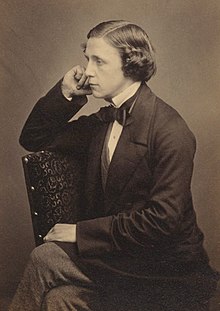
Carroll in June 1857 |
|
| Born | Charles Lutwidge Dodgson 27 January 1832 Daresbury, Cheshire, England |
| Died | 14 January 1898 (aged 65) Guildford, Surrey, England |
| Resting place | Mount Cemetery, Guildford, Surrey, England |
| Occupation |
|
| Education |
|
| Genre |
|
| Relatives |
|
| Signature | |
Charles Lutwidge Dodgson (; 27 January 1832 – 14 January 1898), better known by his pen name Lewis Carroll, was an English author, poet and mathematician. His most notable works are Alice’s Adventures in Wonderland (1865) and its sequel Through the Looking-Glass (1871). He was noted for his facility with word play, logic, and fantasy. His poems Jabberwocky (1871) and The Hunting of the Snark (1876) are classified in the genre of literary nonsense.
Carroll came from a family of high-church Anglicans, and developed a long relationship with Christ Church, Oxford, where he lived for most of his life as a scholar and teacher. Alice Liddell, the daughter of Christ Church’s dean Henry Liddell, is widely identified as the original inspiration for Alice in Wonderland, though Carroll always denied this.
An avid puzzler, Carroll created the word ladder puzzle (which he then called «Doublets»), which he published in his weekly column for Vanity Fair magazine between 1879 and 1881. In 1982 a memorial stone to Carroll was unveiled at Poets’ Corner in Westminster Abbey. There are societies in many parts of the world dedicated to the enjoyment and promotion of his works.[1][2]
Early life[edit]
Dodgson’s family was predominantly northern English, conservative, and high-church Anglican. Most of his male ancestors were army officers or Anglican clergymen. His great-grandfather, Charles Dodgson, had risen through the ranks of the church to become the Bishop of Elphin in rural Ireland.[3] His paternal grandfather, another Charles, had been an army captain, killed in action in Ireland in 1803, when his two sons were hardly more than babies.[4] The older of these sons, yet another Charles Dodgson, was Carroll’s father. He went to Westminster School and then to Christ Church, Oxford.[5] He reverted to the other family tradition and took holy orders. He was mathematically gifted and won a double first degree, which could have been the prelude to a brilliant academic career. Instead, he married his first cousin Frances Jane Lutwidge in 1830 and became a country parson.[6][7]
Dodgson was born on 27 January 1832 at All Saints’ Vicarage in Daresbury, Cheshire,[8] the oldest boy and the third oldest of 11 children. When he was 11, his father was given the living of Croft-on-Tees, Yorkshire, and the whole family moved to the spacious rectory. This remained their home for the next 25 years. Charles’ father was an active and highly conservative cleric of the Church of England who later became the Archdeacon of Richmond[9] and involved himself, sometimes influentially, in the intense religious disputes that were dividing the church. He was high-church, inclining toward Anglo-Catholicism, an admirer of John Henry Newman and the Tractarian movement, and did his best to instil such views in his children. However, Charles developed an ambivalent relationship with his father’s values and with the Church of England as a whole.[10]
During his early youth, Dodgson was educated at home. His «reading lists» preserved in the family archives testify to a precocious intellect: at the age of seven, he was reading books such as The Pilgrim’s Progress. He also spoke with a stammer – a condition shared by most of his siblings[11] – that often inhibited his social life throughout his years. At the age of twelve he was sent to Richmond Grammar School (now part of Richmond School) in Richmond, North Yorkshire.
Lewis Carroll self-portrait c. 1856, aged 24 at that time
In 1846 Dodgson entered Rugby School, where he was evidently unhappy, as he wrote some years after leaving: «I cannot say … that any earthly considerations would induce me to go through my three years again … I can honestly say that if I could have been … secure from annoyance at night, the hardships of the daily life would have been comparative trifles to bear.»[12] He did not claim he suffered from bullying, but cited little boys as the main targets of older bullies at Rugby.[13] Stuart Dodgson Collingwood, Dodgson’s nephew, wrote that «even though it is hard for those who have only known him as the gentle and retiring don to believe it, it is nevertheless true that long after he left school, his name was remembered as that of a boy who knew well how to use his fists in defence of a righteous cause», which is the protection of the smaller boys.[13]
Scholastically, though, he excelled with apparent ease. «I have not had a more promising boy at his age since I came to Rugby», observed mathematics master R. B. Mayor.[14] Francis Walkingame’s The Tutor’s Assistant; Being a Compendium of Arithmetic – the mathematics textbook that the young Dodgson used – still survives and it contained an inscription in Latin, which translates to: «This book belongs to Charles Lutwidge Dodgson: hands off!»[15] Some pages also included annotations such as the one found on p. 129, where he wrote «Not a fair question in decimals» next to a question.[16]
He left Rugby at the end of 1849 and matriculated at the University of Oxford in May 1850 as a member of his father’s old college, Christ Church.[17] After waiting for rooms in college to become available, he went into residence in January 1851.[18] He had been at Oxford only two days when he received a summons home. His mother had died of «inflammation of the brain» – perhaps meningitis or a stroke – at the age of 47.[18]
His early academic career veered between high promise and irresistible distraction. He did not always work hard, but was exceptionally gifted, and achievement came easily to him. In 1852, he obtained first-class honours in Mathematics Moderations and was soon afterwards nominated to a Studentship by his father’s old friend Canon Edward Pusey.[19][20] In 1854, he obtained first-class honours in the Final Honours School of Mathematics, standing first on the list, and thus graduated as Bachelor of Arts.[21][22] He remained at Christ Church studying and teaching, but the next year he failed an important scholarship exam through his self-confessed inability to apply himself to study.[23][24] Even so, his talent as a mathematician won him the Christ Church Mathematical Lectureship in 1855,[25] which he continued to hold for the next 26 years.[26] Despite early unhappiness, Dodgson remained at Christ Church, in various capacities, until his death, including that of Sub-Librarian of the Christ Church library, where his office was close to the Deanery, where Alice Liddell lived.[27]
Character and appearance[edit]
Health problems[edit]
The young adult Charles Dodgson was about 6 feet (1.83 m) tall and slender, and he had curly brown hair and blue or grey eyes (depending on the account). He was described in later life as somewhat asymmetrical, and as carrying himself rather stiffly and awkwardly, although this might be on account of a knee injury sustained in middle age. As a very young child, he suffered a fever that left him deaf in one ear. At the age of 17, he suffered a severe attack of whooping cough, which was probably responsible for his chronically weak chest in later life. In early childhood, he acquired a stammer, which he referred to as his «hesitation»; it remained throughout his life.[27]
The stammer has always been a significant part of the image of Dodgson. While one apocryphal story says that he stammered only in adult company and was free and fluent with children, there is no evidence to support this idea.[28] Many children of his acquaintance remembered the stammer, while many adults failed to notice it. Dodgson himself seems to have been far more acutely aware of it than most people whom he met; it is said that he caricatured himself as the Dodo in Alice’s Adventures in Wonderland, referring to his difficulty in pronouncing his last name, but this is one of the many supposed facts often repeated for which no first-hand evidence remains. He did indeed refer to himself as a dodo, but whether or not this reference was to his stammer is simply speculation.[27]
Dodgson’s stammer did trouble him, but it was never so debilitating that it prevented him from applying his other personal qualities to do well in society. He lived in a time when people commonly devised their own amusements and when singing and recitation were required social skills, and the young Dodgson was well equipped to be an engaging entertainer. He could reportedly sing at a passable level and was not afraid to do so before an audience. He was also adept at mimicry and storytelling, and reputedly quite good at charades.[27]
[edit]
In the interim between his early published writings and the success of the Alice books, Dodgson began to move in the pre-Raphaelite social circle. He first met John Ruskin in 1857 and became friendly with him. Around 1863, he developed a close relationship with Dante Gabriel Rossetti and his family. He would often take pictures of the family in the garden of the Rossetti’s house in Chelsea, London. He also knew William Holman Hunt, John Everett Millais, and Arthur Hughes, among other artists. He knew fairy-tale author George MacDonald well – it was the enthusiastic reception of Alice by the young MacDonald children that persuaded him to submit the work for publication.[27][29]
Politics, religion, and philosophy[edit]
In broad terms, Dodgson has traditionally been regarded as politically, religiously, and personally conservative. Martin Gardner labels Dodgson as a Tory who was «awed by lords and inclined to be snobbish towards inferiors».[30] William Tuckwell, in his Reminiscences of Oxford (1900), regarded him as «austere, shy, precise, absorbed in mathematical reverie, watchfully tenacious of his dignity, stiffly conservative in political, theological, social theory, his life mapped out in squares like Alice’s landscape».[31] Dodgson was ordained a deacon in the Church of England on 22 December 1861. In The Life and Letters of Lewis Carroll, the editor states that «his Diary is full of such modest depreciations of himself and his work, interspersed with earnest prayers (too sacred and private to be reproduced here) that God would forgive him the past, and help him to perform His holy will in the future.»[32] When a friend asked him about his religious views, Dodgson wrote in response that he was a member of the Church of England, but «doubt[ed] if he was fully a ‘High Churchman'». He added:
I believe that when you and I come to lie down for the last time, if only we can keep firm hold of the great truths Christ taught us—our own utter worthlessness and His infinite worth; and that He has brought us back to our one Father, and made us His brethren, and so brethren to one another—we shall have all we need to guide us through the shadows. Most assuredly I accept to the full the doctrines you refer to—that Christ died to save us, that we have no other way of salvation open to us but through His death, and that it is by faith in Him, and through no merit of ours, that we are reconciled to God; and most assuredly I can cordially say, «I owe all to Him who loved me, and died on the Cross of Calvary.»
— Carroll (1897)[33]
Dodgson also expressed interest in other fields. He was an early member of the Society for Psychical Research, and one of his letters suggests that he accepted as real what was then called «thought reading».[34] Dodgson wrote some studies of various philosophical arguments. In 1895, he developed a philosophical regressus-argument on deductive reasoning in his article «What the Tortoise Said to Achilles», which appeared in one of the early volumes of Mind.[35] The article was reprinted in the same journal a hundred years later in 1995, with a subsequent article by Simon Blackburn titled «Practical Tortoise Raising».[36]
Artistic activities[edit]
One of Carroll’s own illustrations
Literature[edit]
From a young age, Dodgson wrote poetry and short stories, contributing heavily to the family magazine Mischmasch and later sending them to various magazines, enjoying moderate success. Between 1854 and 1856, his work appeared in the national publications The Comic Times and The Train, as well as smaller magazines such as the Whitby Gazette and the Oxford Critic. Most of this output was humorous, sometimes satirical, but his standards and ambitions were exacting. «I do not think I have yet written anything worthy of real publication (in which I do not include the Whitby Gazette or the Oxonian Advertiser), but I do not despair of doing so someday,» he wrote in July 1855.[27] Sometime after 1850, he did write puppet plays for his siblings’ entertainment, of which one has survived: La Guida di Bragia.[37]
In March 1856, he published his first piece of work under the name that would make him famous. A romantic poem called «Solitude» appeared in The Train under the authorship of «Lewis Carroll». This pseudonym was a play on his real name: Lewis was the anglicised form of Ludovicus, which was the Latin for Lutwidge, and Carroll an Irish surname similar to the Latin name Carolus, from which comes the name Charles.[7] The transition went as follows:
«Charles Lutwidge» translated into Latin as «Carolus Ludovicus». This was then translated back into English as «Carroll Lewis» and then reversed to make «Lewis Carroll».[38] This pseudonym was chosen by editor Edmund Yates from a list of four submitted by Dodgson, the others being Edgar Cuthwellis, Edgar U. C. Westhill, and Louis Carroll.[39]
Alice books[edit]
«The chief difficulty Alice found at first was in managing her flamingo». Illustration by John Tenniel, 1865.
The Jabberwock, as illustrated by John Tenniel for Lewis Carroll’s Through the Looking-Glass, including the poem «Jabberwocky».
In 1856, Dean Henry Liddell arrived at Christ Church, bringing with him his young family, all of whom would figure largely in Dodgson’s life over the following years, and would greatly influence his writing career. Dodgson became close friends with Liddell’s wife Lorina and their children, particularly the three sisters Lorina, Edith, and Alice Liddell. He was widely assumed for many years to have derived his own «Alice» from Alice Liddell; the acrostic poem at the end of Through the Looking-Glass spells out her name in full, and there are also many superficial references to her hidden in the text of both books. It has been noted that Dodgson himself repeatedly denied in later life that his «little heroine» was based on any real child,[40][41] and he frequently dedicated his works to girls of his acquaintance, adding their names in acrostic poems at the beginning of the text. Gertrude Chataway’s name appears in this form at the beginning of The Hunting of the Snark, and it is not suggested that this means that any of the characters in the narrative are based on her.[41]
Information is scarce (Dodgson’s diaries for the years 1858–1862 are missing), but it seems clear that his friendship with the Liddell family was an important part of his life in the late 1850s, and he grew into the habit of taking the children on rowing trips (first the boy, Harry, and later the three girls) accompanied by an adult friend[42] to nearby Nuneham Courtenay or Godstow.[43]
It was on one such expedition on 4 July 1862 that Dodgson invented the outline of the story that eventually became his first and greatest commercial success. He told the story to Alice Liddell and she begged him to write it down, and Dodgson eventually (after much delay) presented her with a handwritten, illustrated manuscript entitled Alice’s Adventures Under Ground in November 1864.[43]
Before this, the family of friend and mentor George MacDonald read Dodgson’s incomplete manuscript, and the enthusiasm of the MacDonald children encouraged Dodgson to seek publication. In 1863, he had taken the unfinished manuscript to Macmillan the publisher, who liked it immediately. After the possible alternative titles were rejected – Alice Among the Fairies and Alice’s Golden Hour – the work was finally published as Alice’s Adventures in Wonderland in 1865 under the Lewis Carroll pen-name, which Dodgson had first used some nine years earlier.[29] The illustrations this time were by Sir John Tenniel; Dodgson evidently thought that a published book would need the skills of a professional artist. Annotated versions provide insights into many of the ideas and hidden meanings that are prevalent in these books.[44][45] Critical literature has often proposed Freudian interpretations of the book as «a descent into the dark world of the subconscious», as well as seeing it as a satire upon contemporary mathematical advances.[46][47]
The overwhelming commercial success of the first Alice book changed Dodgson’s life in many ways.[48][49][50] The fame of his alter ego «Lewis Carroll» soon spread around the world. He was inundated with fan mail and with sometimes unwanted attention. Indeed, according to one popular story, Queen Victoria herself enjoyed Alice in Wonderland so much that she commanded that he dedicate his next book to her, and was accordingly presented with his next work, a scholarly mathematical volume entitled An Elementary Treatise on Determinants.[51][52] Dodgson himself vehemently denied this story, commenting «… It is utterly false in every particular: nothing even resembling it has occurred»;[52][53] and it is unlikely for other reasons. As T. B. Strong comments in a Times article, «It would have been clean contrary to all his practice to identify [the] author of Alice with the author of his mathematical works».[54][55] He also began earning quite substantial sums of money but continued with his seemingly disliked post at Christ Church.[29]
Late in 1871, he published the sequel Through the Looking-Glass, and What Alice Found There. (The title page of the first edition erroneously gives «1872» as the date of publication.[56]) Its somewhat darker mood possibly reflects changes in Dodgson’s life. His father’s death in 1868 plunged him into a depression that lasted some years.[29]
The Hunting of the Snark[edit]
In 1876, Dodgson produced his next great work, The Hunting of the Snark, a fantastical «nonsense» poem, with illustrations by Henry Holiday, exploring the adventures of a bizarre crew of nine tradesmen and one beaver, who set off to find the snark. It received largely mixed reviews from Carroll’s contemporary reviewers,[57] but was enormously popular with the public, having been reprinted seventeen times between 1876 and 1908,[58] and has seen various adaptations into musicals, opera, theatre, plays and music.[59] Painter Dante Gabriel Rossetti reputedly became convinced that the poem was about him.[29]
Sylvie and Bruno[edit]
In 1895, 30 years after the publication of his masterpieces, Carroll attempted a comeback, producing a two-volume tale of the fairy siblings Sylvie and Bruno. Carroll entwines two plots set in two alternative worlds, one set in rural England and the other in the fairytale kingdoms of Elfland, Outland, and others. The fairytale world satirizes English society, and more specifically the world of academia. Sylvie and Bruno came out in two volumes and is considered a lesser work, although it has remained in print for over a century.
Photography (1856–1880)[edit]
In 1856, Dodgson took up the new art form of photography under the influence first of his uncle Skeffington Lutwidge, and later of his Oxford friend Reginald Southey.[60] He soon excelled at the art and became a well-known gentleman-photographer, and he seems even to have toyed with the idea of making a living out of it in his very early years.[29]
A study by Roger Taylor and Edward Wakeling exhaustively lists every surviving print, and Taylor calculates that just over half of his surviving work depicts young girls, though about 60% of his original photographic portfolio is now missing.[61] Dodgson also made many studies of men, women, boys, and landscapes; his subjects also include skeletons, dolls, dogs, statues, paintings, and trees.[62] His pictures of children were taken with a parent in attendance and many of the pictures were taken in the Liddell garden because natural sunlight was required for good exposures.[42]
He also found photography to be a useful entrée into higher social circles.[63] During the most productive part of his career, he made portraits of notable sitters such as John Everett Millais, Ellen Terry, Dante Gabriel Rossetti, Julia Margaret Cameron, Michael Faraday, Lord Salisbury, and Alfred Tennyson.[29]
By the time that Dodgson abruptly ceased photography (1880, after 24 years), he had established his own studio on the roof of Tom Quad, created around 3,000 images, and was an amateur master of the medium, though fewer than 1,000 images have survived time and deliberate destruction. He stopped taking photographs because keeping his studio working was too time-consuming.[64] He used the wet collodion process; commercial photographers who started using the dry-plate process in the 1870s took pictures more quickly.[65] Popular taste changed with the advent of Modernism, affecting the types of photographs that he produced.
Inventions[edit]
To promote letter writing, Dodgson invented «The Wonderland Postage-Stamp Case» in 1889. This was a cloth-backed folder with twelve slots, two marked for inserting the most commonly used penny stamp, and one each for the other current denominations up to one shilling. The folder was then put into a slipcase decorated with a picture of Alice on the front and the Cheshire Cat on the back. It intended to organize stamps wherever one stored their writing implements; Carroll expressly notes in Eight or Nine Wise Words about Letter-Writing it is not intended to be carried in a pocket or purse, as the most common individual stamps could easily be carried on their own. The pack included a copy of a pamphlet version of this lecture.[66][67]
Reconstructed nyctograph, with scale demonstrated by a 5 euro cent.
Another invention was a writing tablet called the nyctograph that allowed note-taking in the dark, thus eliminating the need to get out of bed and strike a light when one woke with an idea. The device consisted of a gridded card with sixteen squares and a system of symbols representing an alphabet of Dodgson’s design, using letter shapes similar to the Graffiti writing system on a Palm device.[68]
He also devised a number of games, including an early version of what today is known as Scrabble. Devised some time in 1878, he invented the «doublet» (see word ladder), a form of brain-teaser that is still popular today, changing one word into another by altering one letter at a time, each successive change always resulting in a genuine word.[69] For instance, CAT is transformed into DOG by the following steps: CAT, COT, DOT, DOG.[29] It first appeared in the 29 March 1879 issue of Vanity Fair, with Carroll writing a weekly column for the magazine for two years; the final column dated 9 April 1881.[70] The games and puzzles of Lewis Carroll were the subject of Martin Gardner’s March 1960 Mathematical Games column in Scientific American.
Other items include a rule for finding the day of the week for any date; a means for justifying right margins on a typewriter; a steering device for a velociman (a type of tricycle); fairer elimination rules for tennis tournaments; a new sort of postal money order; rules for reckoning postage; rules for a win in betting; rules for dividing a number by various divisors; a cardboard scale for the Senior Common Room at Christ Church which, held next to a glass, ensured the right amount of liqueur for the price paid; a double-sided adhesive strip to fasten envelopes or mount things in books; a device for helping a bedridden invalid to read from a book placed sideways; and at least two ciphers for cryptography.[29]
He also proposed alternative systems of parliamentary representation. He proposed the so-called Dodgson’s method, using the Condorcet method.[71] In 1884, he proposed a proportional representation system based on multi-member districts, each voter casting only a single vote, quotas as minimum requirements to take seats, and votes transferable by candidates through what is now called Liquid democracy.[72]
Mathematical work[edit]
Within the academic discipline of mathematics, Dodgson worked primarily in the fields of geometry, linear and matrix algebra, mathematical logic, and recreational mathematics, producing nearly a dozen books under his real name. Dodgson also developed new ideas in linear algebra (e.g., the first printed proof of the Kronecker–Capelli theorem),[73][74] probability, and the study of elections (e.g., Dodgson’s method) and committees; some of this work was not published until well after his death. His occupation as Mathematical Lecturer at Christ Church gave him some financial security.[75]
Mathematical logic[edit]
His work in the field of mathematical logic attracted renewed interest in the late 20th century. Martin Gardner’s book on logic machines and diagrams and William Warren Bartley’s posthumous publication of the second part of Dodgson’s symbolic logic book have sparked a reevaluation of Dodgson’s contributions to symbolic logic.[76][77][78] It is recognized that in his Symbolic Logic Part II, Dodgson introduced the Method of Trees, the earliest modern use of a truth tree.[79]
Algebra[edit]
Robbins’ and Rumsey’s investigation[80] of Dodgson condensation, a method of evaluating determinants, led them to the alternating sign matrix conjecture, now a theorem.
Recreational mathematics[edit]
The discovery in the 1990s of additional ciphers that Dodgson had constructed, in addition to his «Memoria Technica», showed that he had employed sophisticated mathematical ideas in their creation.[81]
Correspondence[edit]
Dodgson wrote and received as many as 98,721 letters, according to a special letter register which he devised. He documented his advice about how to write more satisfying letters in a missive entitled «Eight or Nine Wise Words about Letter-Writing».[82]
Later years[edit]
Lewis Carroll in later life
Dodgson’s existence remained little changed over the last twenty years of his life, despite his growing wealth and fame. He continued to teach at Christ Church until 1881 and remained in residence there until his death. Public appearances included attending the West End musical Alice in Wonderland (the first major live production of his Alice books) at the Prince of Wales Theatre on 30 December 1886.[83] The two volumes of his last novel, Sylvie and Bruno, were published in 1889 and 1893, but the intricacy of this work was apparently not appreciated by contemporary readers; it achieved nothing like the success of the Alice books, with disappointing reviews and sales of only 13,000 copies.[84][85]
The only known occasion on which he travelled abroad was a trip to Russia in 1867 as an ecclesiastic, together with the Reverend Henry Liddon. He recounts the travel in his «Russian Journal», which was first commercially published in 1935.[86] On his way to Russia and back, he also saw different cities in Belgium, Germany, partitioned Poland, and France.
Death[edit]
Dodgson died of pneumonia following influenza on 14 January 1898 at his sisters’ home, «The Chestnuts», in Guildford in the county of Surrey, just four days before the death of Henry Liddell. He was two weeks away from turning 66 years old. His funeral was held at the nearby St Mary’s Church.[87] His body was buried at the Mount Cemetery in Guildford.[29]
He is commemorated at All Saints’ Church, Daresbury, in its stained glass windows depicting characters from Alice’s Adventures in Wonderland.
Controversies and mysteries[edit]
Sexuality[edit]
Some late twentieth-century biographers have suggested that Dodgson’s interest in children had an erotic element, including Morton N. Cohen in his Lewis Carroll: A Biography (1995),[88] Donald Thomas in his Lewis Carroll: A Portrait with Background (1995), and Michael Bakewell in his Lewis Carroll: A Biography (1996).
Cohen, in particular, speculates that Dodgson’s «sexual energies sought unconventional outlets», and further writes:
We cannot know to what extent sexual urges lay behind Charles’s preference for drawing and photographing children in the nude. He contended the preference was entirely aesthetic. But given his emotional attachment to children as well as his aesthetic appreciation of their forms, his assertion that his interest was strictly artistic is naïve. He probably felt more than he dared acknowledge, even to himself.[89]
Cohen goes on to note that Dodgson «apparently convinced many of his friends that his attachment to the nude female child form was free of any eroticism», but adds that «later generations look beneath the surface» (p. 229). He argues that Dodgson may have wanted to marry the 11-year-old Alice Liddell and that this was the cause of the unexplained «break» with the family in June 1863,[29] an event for which other explanations are offered. Biographers Derek Hudson and Roger Lancelyn Green stop short of identifying Dodgson as a paedophile (Green also edited Dodgson’s diaries and papers), but they concur that he had a passion for small female children and next to no interest in the adult world.[citation needed] Catherine Robson refers to Carroll as «the Victorian era’s most famous (or infamous) girl lover».[90]
Several other writers and scholars have challenged the evidential basis for Cohen’s and others’ views about Dodgson’s sexual interests. Hugues Lebailly has endeavoured to set Dodgson’s child photography within the «Victorian Child Cult», which perceived child nudity as essentially an expression of innocence.[91] Lebailly claims that studies of child nudes were mainstream and fashionable in Dodgson’s time and that most photographers made them as a matter of course, including Oscar Gustave Rejlander and Julia Margaret Cameron. Lebailly continues that child nudes even appeared on Victorian Christmas cards, implying a very different social and aesthetic assessment of such material. Lebailly concludes that it has been an error of Dodgson’s biographers to view his child-photography with 20th- or 21st-century eyes, and to have presented it as some form of personal idiosyncrasy, when it was a response to a prevalent aesthetic and philosophical movement of the time.
Karoline Leach’s reappraisal of Dodgson focused in particular on his controversial sexuality. She argues that the allegations of paedophilia rose initially from a misunderstanding of Victorian morals, as well as the mistaken idea – fostered by Dodgson’s various biographers – that he had no interest in adult women. She termed the traditional image of Dodgson «the Carroll Myth». She drew attention to the large amounts of evidence in his diaries and letters that he was also keenly interested in adult women, married and single, and enjoyed several relationships with them that would have been considered scandalous by the social standards of his time. She also pointed to the fact that many of those whom he described as «child-friends» were girls in their late teens and even twenties.[92] She argues that suggestions of paedophilia emerged only many years after his death, when his well-meaning family had suppressed all evidence of his relationships with women in an effort to preserve his reputation, thus giving a false impression of a man interested only in little girls. Similarly, Leach points to a 1932 biography by Langford Reed as the source of the dubious claim that many of Carroll’s female friendships ended when the girls reached the age of 14.[93]
In addition to the biographical works that have discussed Dodgson’s sexuality, there are modern artistic interpretations of his life and work that do so as well – in particular, Dennis Potter in his play Alice and his screenplay for the motion picture Dreamchild, and Robert Wilson in his musical Alice.
Ordination[edit]
Dodgson had been groomed for the ordained ministry in the Church of England from a very early age and was expected to be ordained within four years of obtaining his master’s degree, as a condition of his residency at Christ Church. He delayed the process for some time but was eventually ordained as a deacon on 22 December 1861. But when the time came a year later to be ordained as a priest, Dodgson appealed to the dean for permission not to proceed. This was against college rules and, initially, Dean Liddell told him that he would have to consult the college ruling body, which would almost certainly have resulted in his being expelled. For unknown reasons, Liddell changed his mind overnight and permitted him to remain at the college in defiance of the rules.[94] Dodgson never became a priest, unique amongst senior students of his time.
There is currently no conclusive evidence about why Dodgson rejected the priesthood. Some have suggested that his stammer made him reluctant to take the step because he was afraid of having to preach.[95] Wilson quotes letters by Dodgson describing difficulty in reading lessons and prayers rather than preaching in his own words.[96] But Dodgson did indeed preach in later life, even though not in priest’s orders, so it seems unlikely that his impediment was a major factor affecting his choice.[citation needed] Wilson also points out that the Bishop of Oxford, Samuel Wilberforce, who ordained Dodgson, had strong views against clergy going to the theatre, one of Dodgson’s great interests. He was interested in minority forms of Christianity (he was an admirer of F. D. Maurice) and «alternative» religions (theosophy).[97] Dodgson became deeply troubled by an unexplained sense of sin and guilt at this time (the early 1860s) and frequently expressed the view in his diaries that he was a «vile and worthless» sinner, unworthy of the priesthood and this sense of sin and unworthiness may well have affected his decision to abandon being ordained to the priesthood.[98]
Missing diaries[edit]
At least four complete volumes and around seven pages of text are missing from Dodgson’s 13 diaries.[99] The loss of the volumes remains unexplained; the pages have been removed by an unknown hand. Most scholars assume that the diary material was removed by family members in the interests of preserving the family name, but this has not been proven.[100] Except for one page, material is missing from his diaries for the period between 1853 and 1863 (when Dodgson was 21–31 years old).[101][102][failed verification] During this period , Dodgson began experiencing great mental and spiritual anguish and confessing to an overwhelming sense of his own sin. This was also the period of time when he composed his extensive love poetry, leading to speculation that the poems may have been autobiographical.[103][104]
Many theories have been put forward to explain the missing material. A popular explanation for one missing page (27 June 1863) is that it might have been torn out to conceal a proposal of marriage on that day by Dodgson to the 11-year-old Alice Liddell. However, there has never been any evidence to suggest that this was so, and a paper offers some evidence to the contrary which was discovered by Karoline Leach in the Dodgson family archive in 1996.[105]
The «cut pages in diary» document, in the Dodgson family archive in Woking
This paper is known as the «cut pages in diary» document, and was compiled by various members of Carroll’s family after his death. Part of it may have been written at the time when the pages were destroyed, though this is unclear. The document offers a brief summary of two diary pages that are missing, including the one for 27 June 1863. The summary for this page states that Mrs. Liddell told Dodgson that there was gossip circulating about him and the Liddell family’s governess, as well as about his relationship with «Ina», presumably Alice’s older sister Lorina Liddell. The «break» with the Liddell family that occurred soon after was presumably in response to this gossip.[106][107] An alternative interpretation has been made[by whom?] regarding Carroll’s rumoured involvement with «Ina»: Lorina was also the name of Alice Liddell’s mother. What is deemed most crucial and surprising is that the document seems to imply that Dodgson’s break with the family was not connected with Alice at all; until a primary source is discovered, the events of 27 June 1863 will remain in doubt.
Migraine and epilepsy[edit]
In his diary for 1880, Dodgson recorded experiencing his first episode of migraine with aura, describing very accurately the process of «moving fortifications» that are a manifestation of the aura stage of the syndrome.[108] Unfortunately, there is no clear evidence to show whether this was his first experience of migraine per se, or if he may have previously had the far more common form of migraine without aura, although the latter seems most likely, given the fact that migraine most commonly develops in the teens or early adulthood. Another form of migraine aura called Alice in Wonderland syndrome has been named after Dodgson’s little heroine because its manifestation can resemble the sudden size-changes in the book. It is also known as micropsia and macropsia, a brain condition affecting the way that objects are perceived by the mind. For example, an afflicted person may look at a larger object such as a basketball and perceive it as if it were the size of a golf ball. Some authors have suggested that Dodgson may have experienced this type of aura and used it as an inspiration in his work, but there is no evidence that he did.[109][110]
Dodgson also had two attacks in which he lost consciousness. He was diagnosed by a Dr. Morshead, Dr. Brooks, and Dr. Stedman, and they believed the attack and a consequent attack to be an «epileptiform» seizure (initially thought to be fainting, but Brooks changed his mind). Some have concluded from this that he had this condition for his entire life, but there is no evidence of this in his diaries beyond the diagnosis of the two attacks already mentioned.[108] Some authors, Sadi Ranson in particular, have suggested that Carroll may have had temporal lobe epilepsy in which consciousness is not always completely lost but altered, and in which the symptoms mimic many of the same experiences as Alice in Wonderland. Carroll had at least one incident in which he suffered full loss of consciousness and awoke with a bloody nose, which he recorded in his diary and noted that the episode left him not feeling himself for «quite sometime afterward». This attack was diagnosed as possibly «epileptiform» and Carroll himself later wrote of his «seizures» in the same diary.
Most of the standard diagnostic tests of today were not available in the nineteenth century. Yvonne Hart, consultant neurologist at the John Radcliffe Hospital, Oxford, considered Dodgson’s symptoms. Her conclusion, quoted in Jenny Woolf’s 2010 The Mystery of Lewis Carroll, is that Dodgson very likely had migraine and may have had epilepsy, but she emphasises that she would have considerable doubt about making a diagnosis of epilepsy without further information.[111]
Legacy[edit]
There are societies in many parts of the world dedicated to the enjoyment and promotion of his works and the investigation of his life.[112]
Copenhagen Street in Islington, north London is the location of the Lewis Carroll Children’s Library.[113]
In 1982, his great-nephew unveiled a memorial stone to him in Poets’ Corner, Westminster Abbey.[114] In January 1994, an asteroid, 6984 Lewiscarroll, was discovered and named after Carroll. The Lewis Carroll Centenary Wood near his birthplace in Daresbury opened in 2000.[115]
Born in All Saints’ Vicarage, Daresbury, Cheshire, in 1832, Lewis Carroll is commemorated at All Saints’ Church, Daresbury in its stained glass windows depicting characters from Alice’s Adventures in Wonderland. In March 2012, the Lewis Carroll Centre, attached to the church, was opened.[116]
Works[edit]
Literary works[edit]
- La Guida di Bragia, a Ballad Opera for the Marionette Theatre (around 1850)
- «Miss Jones», comic song (1862)[117]
- Alice’s Adventures in Wonderland (1865)
- Phantasmagoria and Other Poems (1869)
- Through the Looking-Glass, and What Alice Found There (includes «Jabberwocky» and «The Walrus and the Carpenter») (1871)
- The Hunting of the Snark (1876)
- Rhyme? And Reason? (1883) – shares some contents with the 1869 collection, including the long poem «Phantasmagoria»
- A Tangled Tale (1885)
- Sylvie and Bruno (1889)
- The Nursery «Alice» (1890)
- Sylvie and Bruno Concluded (1893)
- Pillow Problems (1893)
- What the Tortoise Said to Achilles (1895)
- Three Sunsets and Other Poems (1898)
- The Manlet (1903)[118]
Mathematical works[edit]
- A Syllabus of Plane Algebraic Geometry (1860)
- The Fifth Book of Euclid Treated Algebraically (1858 and 1868)
- An Elementary Treatise on Determinants, With Their Application to Simultaneous Linear Equations and Algebraic Equations
- Euclid and his Modern Rivals (1879), both literary and mathematical in style
- Symbolic Logic Part I
- Symbolic Logic Part II (published posthumously)
- The Alphabet Cipher (1868)
- The Game of Logic (1887)
- Curiosa Mathematica I (1888)
- Curiosa Mathematica II (1892)
- A discussion of the various methods of procedure in conducting elections (1873), Suggestions as to the best method of taking votes, where more than two issues are to be voted on (1874), A method of taking votes on more than two issues (1876), collected as The Theory of Committees and Elections, edited, analysed, and published in 1958 by Duncan Black
Other works[edit]
- Some Popular Fallacies about Vivisection
- Eight or Nine Wise Words About Letter-Writing
- Notes by an Oxford Chiel
- The Principles of Parliamentary Representation (1884)
See also[edit]
- Lewis Carroll identity
- Lewis Carroll Shelf Award
- RGS Worcester and The Alice Ottley School – Miss Ottley, the first Headmistress of The Alice Ottley School, was a friend of Lewis Carroll. One of the school’s houses was named after him.
- Carroll diagram
- Origins of a Story
- The White Knight
References[edit]
- ^ «Lewis Carroll Societies». Lewiscarrollsociety.org.uk. Archived from the original on 29 March 2016. Retrieved 7 October 2020.
- ^ Lewis Carroll Society of North America Inc. Archived 26 March 2022 at the Wayback Machine Charity Navigator. Retrieved 7 October
- ^ Clark, p. 10
- ^ Collingwood, pp. 6–7
- ^ Bakewell, Michael (1996). Lewis Carroll: A Biography. London: Heinemann. p. 2. ISBN 9780434045792.
- ^ Collingwood, p. 8
- ^ a b Cohen, pp. 30–35
- ^ «Google map of Daresbury, UK». Retrieved 22 October 2011.[dead link]
- ^ «Charles Lutwidge Dodgson». The MacTutor History of Mathematics archive. Archived from the original on 5 July 2011. Retrieved 8 March 2011.
- ^ Cohen, pp. 200–202
- ^ Cohen, p. 4
- ^ Collingwood, pp. 30–31
- ^ a b Woolf, Jenny (2010). The Mystery of Lewis Carroll: Discovering the Whimsical, Thoughtful, and Sometimes Lonely Man Who Created «Alice in Wonderland». New York: St. Martin’s Press. pp. 24. ISBN 9780312612986.
- ^ Collingwood, p. 29
- ^ Carroll, Lewis (1995). Wakeling, Edward (ed.). Rediscovered Lewis Carroll Puzzles. New York City: Dover Publications. pp. 13. ISBN 0486288617.
- ^ Lovett, Charlie (2005). Lewis Carroll Among His Books: A Descriptive Catalogue of the Private Library of Charles L. Dodgson. Jefferson, North Carolina: McFarland & Company, Inc., Publishers. p. 329. ISBN 0786421053.
- ^ Clark, pp. 63–64
- ^ a b Clark, pp. 64–65
- ^ Collingwood, p. 52
- ^ Clark, p. 74
- ^ Collingwood, p. 57
- ^ Wilson, p. 51
- ^ Cohen, p. 51
- ^ Clark, p. 79
- ^ Flood, Raymond; Rice, Adrian; Wilson, Robin (2011). Mathematics in Victorian Britain. Oxfordshire, England: Oxford University Press. p. 41. ISBN 978-0-19-960139-4. OCLC 721931689.
- ^ Cohen, pp. 414–416
- ^ a b c d e f Leach, Ch. 2.
- ^ Leach, p. 91
- ^ a b c d e f g h i j k Cohen, pp. 100–4
- ^ Gardner, Martin (2000). Introduction to The annotated Alice: Alice’s adventures in Wonderland & Through the looking glass. W. W. Norton & Company. p. xv. ISBN 0-517-02962-6.
- ^ Gardner, Martin (2009). Introduction to Alice’s Adventures in Wonderland and Through the Looking-Glass. Oxford University Press. p. xvi. ISBN 978-0-517-02962-6.
- ^ Collingwood
- ^ Collingwood, Chapter IX
- ^ Hayness, Renée (1982). The Society for Psychical Research, 1882–1982 A History. London: Macdonald & Co. pp. 13–14. ISBN 0-356-07875-2.
- ^ Carroll, L. (1895). «What the Tortoise Said to Achilles». Mind. IV (14): 278–280. doi:10.1093/mind/IV.14.278.
- ^ Blackburn, S. (1995). «Practical Tortoise Raising». Mind. 104 (416): 695–711. doi:10.1093/mind/104.416.695.
- ^ Heath, Peter L. (2007). «Introduction». La Guida Di Bragia, a Ballad Opera for the Marionette Theatre. Lewis Carroll Society of North America. pp. vii–xvi. ISBN 978-0-930326-15-9.
- ^ Roger Lancelyn Green On-line Encyclopædia Britannica Archived 9 May 2015 at the Wayback Machine
- ^ Thomas, p. 129
- ^ Cohen, Morton N. (ed) (1979) The Letters of Lewis Carroll, London: Macmillan.
- ^ a b Leach, Ch. 5 «The Unreal Alice»
- ^ a b Winchester, Simon (2011). The Alice Behind Wonderland. Oxford University Press. ISBN 978-0-19-539619-5. OCLC 641525313.
- ^ a b Leach, Ch. 4
- ^ Gardner, Martin (2000). «The Annotated Alice. The Definitive Edition». New York: W.W. Norton.
- ^ Heath, Peter (1974). «The Philosopher’s Alice». New York: St. Martin’s Press.
- ^ «Algebra in Wonderland». The New York Times. 7 March 2010. Archived from the original on 12 March 2010. Retrieved 10 February 2017.
- ^ Bayley, Melanie. «Alice’s adventures in algebra: Wonderland solved». New Scientist. Archived from the original on 25 January 2022. Retrieved 14 October 2016.
- ^ Elster, Charles Harrington (2006). The big book of beastly mispronunciations: the complete opinionated guide for the careful speaker. Houghton Mifflin Harcourt. pp. 158–159. ISBN 061842315X. Archived from the original on 3 January 2017. Retrieved 3 August 2016.
- ^ Emerson, R. H. (1996). «The Unpronounceables: Difficult Literary Names 1500–1940». English Language Notes. 34 (2): 63–74. ISSN 0013-8282.
- ^ «Lewis Carroll». Biography in Context. Gale. Archived from the original on 26 March 2022. Retrieved 24 September 2015.
- ^ Wilson
- ^ a b «Lewis Carroll – Logician, Nonsense Writer, Mathematician and Photographer». The Hitchhiker’s Guide to the Galaxy. BBC. 26 August 2005. Archived from the original on 3 February 2009. Retrieved 12 February 2009.
- ^ Dodgson, Charles (1896). Symbolic Logic.
- ^ Strong, T. B. (27 January 1932). «Mr. Dodgson: Lewis Carroll at Oxford». [The Times].
- ^ «Fit for a Queen». Snopes. 26 March 1999. Archived from the original on 26 March 2022. Retrieved 25 March 2011.
- ^ Cohen, Morton (24 June 2009). Introduction to «Alice in Wonderland and Through the Looking-Glass». Random House. ISBN 978-0-553-21345-4.
- ^ Cohen, Morton N. (1976). «Hark the Snark». In Guilano, Edward (ed.). Lewis Carroll Observed. New York: Clarkson N. Potter, Inc. pp. 92–110. ISBN 0-517-52497-X.
- ^ Williams, Sidney Herbert; Madan, Falconer (1979). Handbook of the literature of the Rev. C.L. Dodgson. Folkestone, England: Dawson. p. 68. ISBN 9780712909068. OCLC 5754676.
- ^ Greenarce, Selwyn (2006) [1876]. «The Listing of the Snark». In Martin Gardner (ed.). The Annotated Hunting of the Snark (Definitive ed.). W. W. Norton. pp. 117–147. ISBN 0-393-06242-2.
- ^ Clark, p. 93
- ^ Taylor, Roger; Wakeling, Edward (25 February 2002). Lewis Carroll, Photographer. Princeton University Press. ISBN 978-0-691-07443-6.
- ^ Cohen, Morton (1999). «Reflections in a Looking Glass.» New York: Aperture.
- ^ Thomas, p. 116
- ^ Thomas, p. 265
- ^ Wakeling, Edward (1998). «Lewis Carroll’s Photography». An Exhibition From the Jon A. Lindseth Collection of C. L. Dodgson and Lewis Carroll. New York, NY: The Grolier Club. pp. 55–67. ISBN 0-910672-23-7.
- ^ Flodden W. Heron, «Lewis Carroll, Inventor of Postage Stamp Case» in Stamps, vol. 26, no. 12, 25 March 1939
- ^ «Carroll Related Stamps». The Lewis Carroll Society. 28 April 2005. Archived from the original on 21 March 2012. Retrieved 10 March 2011.
- ^ Everson, Michael. (2011) «Alice’s Adventures in Wonderland: An edition printed in the Nyctographic Square Alphabet devised by Lewis Carroll». Foreword by Alan Tannenbaum, Éire: Cathair na Mart. ISBN 978-1-904808-78-7
- ^ Gardner, Martin. «Word Ladders: Lewis Carroll’s Doublets». No. Vol. 80, No. 487, Centenary Issue (Mar. 1996). The Mathematical Gazette. JSTOR 3620349. Archived from the original on 20 April 2021. Retrieved 22 March 2022.
- ^ Deanna Haunsperger, Stephen Kennedy (31 July 2006). The Edge of the Universe: Celebrating Ten Years of Math Horizons. Mathematical Association of America. p. 22. ISBN 0-88385-555-0.
- ^ Black, Duncan; McLean, Iain; McMillan, Alistair; Monroe, Burt L.; Dodgson, Charles Lutwidge (1996). A Mathematical Approach to Proportional Representation. ISBN 978-0-7923-9620-8. Archived from the original on 4 February 2021. Retrieved 4 October 2020.
- ^ Charles Dodgson, Principles of Parliamentary Representation (1884)
- ^ Seneta, Eugene (1984). «Lewis Carroll as a Probabilist and Mathematician» (PDF). The Mathematical Scientist. 9: 79–84. Archived (PDF) from the original on 30 January 2016. Retrieved 1 February 2015.
- ^ Abeles, Francine F. (1998) Charles L. Dodgson, Mathematician». An Exhibition From the Jon A. Lindseth Collection of C.L. Dodgson and Lewis Carroll». New York: The Grolier Club, pp. 45–54.
- ^ Wilson, p. 61
- ^ Gardner, Martin. (1958) «Logic Machines and Diagrams». Brighton, Sussex: Harvester Press
- ^ Bartley, William Warren III, ed. (1977) «Lewis Carroll’s Symbolic Logic». New York: Clarkson N. Potter, 2nd ed 1986.
- ^ Moktefi, Amirouche. (2008) «Lewis Carroll’s Logic», pp. 457–505 in British Logic in the Nineteenth Century, Vol. 4 of Handbook of the History of Logic, Dov M. Gabbay and John Woods (eds.) Amsterdam: Elsevier.
- ^ «Modern Logic: The Boolean Period: Carroll – Encyclopedia.com». Archived from the original on 3 August 2020. Retrieved 22 July 2020.
- ^ Robbins, D. P.; Rumsey, H. (1986). «Determinants and alternating sign matrices». Advances in Mathematics. 62 (2): 169. doi:10.1016/0001-8708(86)90099-X.
- ^ Abeles, F. F. (2005). «Lewis Carroll’s ciphers: The literary connections». Advances in Applied Mathematics. 34 (4): 697–708. doi:10.1016/j.aam.2004.06.006.
- ^ Clark, Dorothy G. (April 2010). «The Place of Lewis Carroll in Children’s Literature (review)». The Lion and the Unicorn. 34 (2): 253–258. doi:10.1353/uni.0.0495. S2CID 143924225. Archived from the original on 4 March 2016. Retrieved 21 January 2014.
- ^ Carroll, Lewis (1979). The Letters of Lewis Carroll, Volumes 1–2. Oxford University Press. p. 657.
Dec. 30th.—To London with M—, and took her to «Alice in Wonderland,» Mr. Savile Clarke’s play at the Prince of Wales’s Theatre… as a whole, the play seems a success.
- ^ Angelica Shirley Carpenter (2002). Lewis Carroll: Through the Looking Glass. Lerner. p. 98.ISBN 978-0822500735.
- ^ Christensen, Thomas (1991). «Dodgson’s Dodges» Archived 15 July 2011 at the Wayback Machine. rightreading.com.
- ^ «Chronology of Works of Lewis Carroll». Archived from the original on 20 February 2009. Retrieved 20 February 2009.
- ^ «Lewis Carroll and St Mary’s Church – Guildford: This Is Our Town website». 30 October 2013. Archived from the original on 11 November 2016. Retrieved 10 November 2016.
- ^ Cohen, pp. 166–167, 254–255
- ^ Cohen, p. 228
- ^ Robson, Catherine (2001). Men in Wonderland: The Lost Girlhood of the Victorian Gentlemen. Princeton, New Jersey: Princeton University Press. p. 137. ISBN 978-0691004228.
- ^ «Association for new Lewis Carroll studies». Contrariwise.wild-reality.net. Archived from the original on 7 February 2012. Retrieved 19 October 2019.
- ^ Leach, pp. 16–17
- ^ Leach, p. 33
- ^ Dodgson’s MS diaries, volume 8, 22–24 October 1862
- ^ Cohen, p. 263
- ^ Wilson, pp. 103–104
- ^ Leach, p. 134
- ^ Dodgson’s MS diaries, volume 8, see prayers scattered throughout the text
- ^ Leach, pp. 48, 51
- ^ Leach, pp. 48–51
- ^ Leach, p. 52
- ^ Wakeling, Edward (April 2003). «The Real Lewis Carroll / A Talk given to the Lewis Carroll Society». 1855 … 1856 … 1857 … 1858 … 1862 … 1863. Archived from the original on 22 August 2016. Retrieved 14 September 2009.
- ^ Leach p. 54
- ^ «The Dodgson Family and Their Legacy». Archived from the original on 14 January 2011. Retrieved 5 January 2011.
- ^ Dodgson Family Collection, Cat. No. F/17/1. «Cut Pages in Diary». (For an account of its discovery see The Times Literary Supplement, 3 May 1996.)
- ^ Leach, pp. 170–2.
- ^ «Text available on-line». Looking for Lewis Carroll. Archived from the original on 16 November 2018. Retrieved 4 May 2007.
- ^ a b Wakeling, Edward (Ed.) «The Diaries of Lewis Carroll», Vol. 9, p. 52
- ^ Maudie, F.W. «Migraine and Lewis Carroll». The Migraine Periodical. 17.
- ^ Podoll, K; Robinson, D (1999). «Lewis Carroll’s migraine experiences». The Lancet. 353 (9161): 1366. doi:10.1016/S0140-6736(05)74368-3. PMID 10218566. S2CID 5082284.
- ^ Woolf, Jenny (4 February 2010). The Mystery of Lewis Carroll. St. Martin’s Press. pp. 298–9. ISBN 978-0-312-67371-0.
- ^ «Lewis Carroll Societies». Lewiscarrollsociety.org.uk. Archived from the original on 29 March 2016. Retrieved 12 September 2013.
- ^ «‘A most curious thing’ / Lewis Carroll Library». www.designbybeam.com. Archived from the original on 3 April 2015. Retrieved 15 March 2013.
- ^ «LEWIS CARROLL IS HONORED ON 150TH BIRTHDAY». The New York Times. 18 December 1982. Archived from the original on 5 May 2015. Retrieved 30 January 2015.
- ^ «Lewis Carroll Centenary Wood near Daresbury Runcorn». www.woodlandtrust.org.uk. Archived from the original on 5 August 2020. Retrieved 27 November 2019.
- ^ About Us, Lewis Carroll Centre & All Saints Daresbury PCC, archived from the original on 14 April 2012, retrieved 11 April 2012
- ^ The Carrollian. Lewis Carroll Society. Issue 7–8. p. 7. 2001: «In 1862 when Lewis Carroll sent to Yates the manuscript of the words of a ‘melancholy song’, entitled ‘Miss Jones’, he hoped that it would be published and performed by a comedian on a London music-hall stage.» Archived 4 August 2020 at the Wayback Machine
- ^ The Hunting of the Snark and Other Poems and Verses, New York: Harper & Brothers, 1903
Bibliography[edit]
- Clark, Ann (1979). Lewis Carroll: A Biography. London: J. M. Dent. ISBN 0-460-04302-1.
- Cohen, Morton (1996). Lewis Carroll: A Biography. Vintage Books. pp. 30–35. ISBN 0-679-74562-9.
- Collingwood, Stuart Dodgson (1898). The Life and Letters of Lewis Carroll. London: T. Fisher Unwin.
- Leach, Karoline (1999). In the Shadow of the Dreamchild: A New Understanding of Lewis Carroll. London: Peter Owen.
- Pizzati, Giovanni: «An Endless Procession of People in Masquerade». Figure piane in Alice in Wonderland. 1993, Cagliari.
- Reed, Langford: The Life of Lewis Carroll (1932. London: W. and G. Foyle)
- Taylor, Alexander L., Knight: The White Knight (1952. Edinburgh: Oliver and Boyd)
- Taylor, Roger & Wakeling, Edward: Lewis Carroll, Photographer. 2002. Princeton University Press. ISBN 0-691-07443-7. (Catalogues nearly every Carroll photograph known to be still in existence.)
- Thomas, Donald (1996). Lewis Carroll: A Biography. Barnes and Noble, Inc. ISBN 978-0-7607-1232-0.
- Wilson, Robin (2008). Lewis Carroll in Numberland: His Fantastical Mathematical Logical Life. London: Allen Lane. ISBN 978-0-7139-9757-6.
- Woolf, Jenny: The Mystery of Lewis Carroll. 2010. New York: St Martin’s Press. ISBN 978-0-312-61298-6
Further reading[edit]
- Black, Duncan (1958). The Circumstances in which Rev. C. L. Dodgson (Lewis Carroll) wrote his Three Pamphlets and Appendix: Text of Dodgson’s Three Pamphlets and of ‘The Cyclostyled Sheet’ in The Theory of Committees and Elections, Cambridge: Cambridge University Press
- Bowman, Isa (1899). The Story of Lewis Carroll: Told for Young People by the Real Alice in Wonderland, Miss Isa Bowman. London: J.M. Dent & Co.
- Carroll, Lewis: The Annotated Alice: 150th Anniversary Deluxe Edition. Illustrated by John Tenniel. Edited by Martin Gardner & Mark Burstein. W. W. Norton. 2015. ISBN 978-0-393-24543-1
- Dodgson, Charles L.: Euclid and His Modern Rivals. Macmillan. 1879.
- Dodgson, Charles L.: The Pamphlets of Lewis Carroll
- Vol. 1: The Oxford Pamphlets. 1993. ISBN 0-8139-1250-4
- Vol. 2: The Mathematical Pamphlets. 1994. ISBN 0-9303-26-09-1
- Vol. 3: The Political Pamphlets. 2001. ISBN 0-930326-14-8
- Vol. 4: The Logic Pamphlets. 2010 ISBN 978-0-930326-25-8.
- Douglas-Fairhurst, Robert (2016). The Story of Alice: Lewis Carroll and the Secret History of Wonderland. Harvard University Press. ISBN 9780674970762.
- Goodacre, Selwyn (2006). All the Snarks: The Illustrated Editions of the Hunting of the Snark. Oxford: Inky Parrot Press.
- Graham-Smith, Darien (2005). Contextualising Carroll, University of Wales, Bangor. PhD thesis.
- Huxley, Francis: The Raven and the Writing Desk. 1976. ISBN 0-06-012113-0.
- Kelly, Richard: Lewis Carroll. 1990. Boston: Twayne Publishers.
- Kelly, Richard (ed.): Alice’s Adventures in Wonderland. 2000. Peterborough, Ontario: Broadviewpress.
- Lovett, Charlie: Lewis Carroll Among His Books: A Descriptive Catalogue of the Private Library of Charles L. Dodgson. 2005. ISBN 0-7864-2105-3
- Waggoner, Diane (2020). Lewis Carroll’s Photography and Modern Childhood. Princeton: Princeton University Press. ISBN 978-0-691-19318-2.
- Wakeling, Edward (2015). The Photographs of Lewis Carroll: A Catalogue Raisonné. Austin: University of Texas Press. ISBN 978-0-292-76743-0.
- Wullschläger, Jackie: Inventing Wonderland. ISBN 0-7432-2892-8. — Also looks at Edward Lear (of the «nonsense» verses), J. M. Barrie (Peter Pan), Kenneth Grahame (The Wind in the Willows), and A. A. Milne (Winnie-the-Pooh).
- N.N.: Dreaming in Pictures: The Photography of Lewis Carroll. Yale University Press & SFMOMA, 2004. (Places Carroll firmly in the art photography tradition.)
External links[edit]
- Digital collections
- Works by Lewis Carroll in eBook form at Standard Ebooks
- Works by Lewis Carroll at Project Gutenberg
- Works by or about Lewis Carroll at Internet Archive
- Works by Lewis Carroll at LibriVox (public domain audiobooks)
- Works by Lewis Carroll at Open Library
- The Poems of Lewis Carroll
- [1] First Editions
- Physical collections
- Guide to Harcourt Amory collection of Lewis Carroll at Houghton Library, Harvard University
- Lewis Carroll at the British Library
- Lewis Carroll online exhibition at the Harry Ransom Center at the University of Texas at Austin
- Lewis Carroll Scrapbook Collection at the Library of Congress
- «Archival material relating to Lewis Carroll». UK National Archives.
- Biographical information and scholarship
- Lewis Carroll at victorianweb.org
- Contrariwise: the Association for New Lewis Carroll Studies — articles by leading members of the ‘new scholarship’
- Lewis Carroll’s Shifting Reputation
- Lewis Carroll: Logic, Internet Encyclopedia of Philosophy
- Other links
- Lewis Carroll at the Internet Book List
- Lewis Carroll at the Internet Speculative Fiction Database
- Newspaper clippings about Lewis Carroll in the 20th Century Press Archives of the ZBW
- The Lewis Carroll Society
|
Lewis Carroll |
|
|---|---|

Carroll in June 1857 |
|
| Born | Charles Lutwidge Dodgson 27 January 1832 Daresbury, Cheshire, England |
| Died | 14 January 1898 (aged 65) Guildford, Surrey, England |
| Resting place | Mount Cemetery, Guildford, Surrey, England |
| Occupation |
|
| Education |
|
| Genre |
|
| Relatives |
|
| Signature | |
Charles Lutwidge Dodgson (; 27 January 1832 – 14 January 1898), better known by his pen name Lewis Carroll, was an English author, poet and mathematician. His most notable works are Alice’s Adventures in Wonderland (1865) and its sequel Through the Looking-Glass (1871). He was noted for his facility with word play, logic, and fantasy. His poems Jabberwocky (1871) and The Hunting of the Snark (1876) are classified in the genre of literary nonsense.
Carroll came from a family of high-church Anglicans, and developed a long relationship with Christ Church, Oxford, where he lived for most of his life as a scholar and teacher. Alice Liddell, the daughter of Christ Church’s dean Henry Liddell, is widely identified as the original inspiration for Alice in Wonderland, though Carroll always denied this.
An avid puzzler, Carroll created the word ladder puzzle (which he then called «Doublets»), which he published in his weekly column for Vanity Fair magazine between 1879 and 1881. In 1982 a memorial stone to Carroll was unveiled at Poets’ Corner in Westminster Abbey. There are societies in many parts of the world dedicated to the enjoyment and promotion of his works.[1][2]
Early life[edit]
Dodgson’s family was predominantly northern English, conservative, and high-church Anglican. Most of his male ancestors were army officers or Anglican clergymen. His great-grandfather, Charles Dodgson, had risen through the ranks of the church to become the Bishop of Elphin in rural Ireland.[3] His paternal grandfather, another Charles, had been an army captain, killed in action in Ireland in 1803, when his two sons were hardly more than babies.[4] The older of these sons, yet another Charles Dodgson, was Carroll’s father. He went to Westminster School and then to Christ Church, Oxford.[5] He reverted to the other family tradition and took holy orders. He was mathematically gifted and won a double first degree, which could have been the prelude to a brilliant academic career. Instead, he married his first cousin Frances Jane Lutwidge in 1830 and became a country parson.[6][7]
Dodgson was born on 27 January 1832 at All Saints’ Vicarage in Daresbury, Cheshire,[8] the oldest boy and the third oldest of 11 children. When he was 11, his father was given the living of Croft-on-Tees, Yorkshire, and the whole family moved to the spacious rectory. This remained their home for the next 25 years. Charles’ father was an active and highly conservative cleric of the Church of England who later became the Archdeacon of Richmond[9] and involved himself, sometimes influentially, in the intense religious disputes that were dividing the church. He was high-church, inclining toward Anglo-Catholicism, an admirer of John Henry Newman and the Tractarian movement, and did his best to instil such views in his children. However, Charles developed an ambivalent relationship with his father’s values and with the Church of England as a whole.[10]
During his early youth, Dodgson was educated at home. His «reading lists» preserved in the family archives testify to a precocious intellect: at the age of seven, he was reading books such as The Pilgrim’s Progress. He also spoke with a stammer – a condition shared by most of his siblings[11] – that often inhibited his social life throughout his years. At the age of twelve he was sent to Richmond Grammar School (now part of Richmond School) in Richmond, North Yorkshire.
Lewis Carroll self-portrait c. 1856, aged 24 at that time
In 1846 Dodgson entered Rugby School, where he was evidently unhappy, as he wrote some years after leaving: «I cannot say … that any earthly considerations would induce me to go through my three years again … I can honestly say that if I could have been … secure from annoyance at night, the hardships of the daily life would have been comparative trifles to bear.»[12] He did not claim he suffered from bullying, but cited little boys as the main targets of older bullies at Rugby.[13] Stuart Dodgson Collingwood, Dodgson’s nephew, wrote that «even though it is hard for those who have only known him as the gentle and retiring don to believe it, it is nevertheless true that long after he left school, his name was remembered as that of a boy who knew well how to use his fists in defence of a righteous cause», which is the protection of the smaller boys.[13]
Scholastically, though, he excelled with apparent ease. «I have not had a more promising boy at his age since I came to Rugby», observed mathematics master R. B. Mayor.[14] Francis Walkingame’s The Tutor’s Assistant; Being a Compendium of Arithmetic – the mathematics textbook that the young Dodgson used – still survives and it contained an inscription in Latin, which translates to: «This book belongs to Charles Lutwidge Dodgson: hands off!»[15] Some pages also included annotations such as the one found on p. 129, where he wrote «Not a fair question in decimals» next to a question.[16]
He left Rugby at the end of 1849 and matriculated at the University of Oxford in May 1850 as a member of his father’s old college, Christ Church.[17] After waiting for rooms in college to become available, he went into residence in January 1851.[18] He had been at Oxford only two days when he received a summons home. His mother had died of «inflammation of the brain» – perhaps meningitis or a stroke – at the age of 47.[18]
His early academic career veered between high promise and irresistible distraction. He did not always work hard, but was exceptionally gifted, and achievement came easily to him. In 1852, he obtained first-class honours in Mathematics Moderations and was soon afterwards nominated to a Studentship by his father’s old friend Canon Edward Pusey.[19][20] In 1854, he obtained first-class honours in the Final Honours School of Mathematics, standing first on the list, and thus graduated as Bachelor of Arts.[21][22] He remained at Christ Church studying and teaching, but the next year he failed an important scholarship exam through his self-confessed inability to apply himself to study.[23][24] Even so, his talent as a mathematician won him the Christ Church Mathematical Lectureship in 1855,[25] which he continued to hold for the next 26 years.[26] Despite early unhappiness, Dodgson remained at Christ Church, in various capacities, until his death, including that of Sub-Librarian of the Christ Church library, where his office was close to the Deanery, where Alice Liddell lived.[27]
Character and appearance[edit]
Health problems[edit]
The young adult Charles Dodgson was about 6 feet (1.83 m) tall and slender, and he had curly brown hair and blue or grey eyes (depending on the account). He was described in later life as somewhat asymmetrical, and as carrying himself rather stiffly and awkwardly, although this might be on account of a knee injury sustained in middle age. As a very young child, he suffered a fever that left him deaf in one ear. At the age of 17, he suffered a severe attack of whooping cough, which was probably responsible for his chronically weak chest in later life. In early childhood, he acquired a stammer, which he referred to as his «hesitation»; it remained throughout his life.[27]
The stammer has always been a significant part of the image of Dodgson. While one apocryphal story says that he stammered only in adult company and was free and fluent with children, there is no evidence to support this idea.[28] Many children of his acquaintance remembered the stammer, while many adults failed to notice it. Dodgson himself seems to have been far more acutely aware of it than most people whom he met; it is said that he caricatured himself as the Dodo in Alice’s Adventures in Wonderland, referring to his difficulty in pronouncing his last name, but this is one of the many supposed facts often repeated for which no first-hand evidence remains. He did indeed refer to himself as a dodo, but whether or not this reference was to his stammer is simply speculation.[27]
Dodgson’s stammer did trouble him, but it was never so debilitating that it prevented him from applying his other personal qualities to do well in society. He lived in a time when people commonly devised their own amusements and when singing and recitation were required social skills, and the young Dodgson was well equipped to be an engaging entertainer. He could reportedly sing at a passable level and was not afraid to do so before an audience. He was also adept at mimicry and storytelling, and reputedly quite good at charades.[27]
[edit]
In the interim between his early published writings and the success of the Alice books, Dodgson began to move in the pre-Raphaelite social circle. He first met John Ruskin in 1857 and became friendly with him. Around 1863, he developed a close relationship with Dante Gabriel Rossetti and his family. He would often take pictures of the family in the garden of the Rossetti’s house in Chelsea, London. He also knew William Holman Hunt, John Everett Millais, and Arthur Hughes, among other artists. He knew fairy-tale author George MacDonald well – it was the enthusiastic reception of Alice by the young MacDonald children that persuaded him to submit the work for publication.[27][29]
Politics, religion, and philosophy[edit]
In broad terms, Dodgson has traditionally been regarded as politically, religiously, and personally conservative. Martin Gardner labels Dodgson as a Tory who was «awed by lords and inclined to be snobbish towards inferiors».[30] William Tuckwell, in his Reminiscences of Oxford (1900), regarded him as «austere, shy, precise, absorbed in mathematical reverie, watchfully tenacious of his dignity, stiffly conservative in political, theological, social theory, his life mapped out in squares like Alice’s landscape».[31] Dodgson was ordained a deacon in the Church of England on 22 December 1861. In The Life and Letters of Lewis Carroll, the editor states that «his Diary is full of such modest depreciations of himself and his work, interspersed with earnest prayers (too sacred and private to be reproduced here) that God would forgive him the past, and help him to perform His holy will in the future.»[32] When a friend asked him about his religious views, Dodgson wrote in response that he was a member of the Church of England, but «doubt[ed] if he was fully a ‘High Churchman'». He added:
I believe that when you and I come to lie down for the last time, if only we can keep firm hold of the great truths Christ taught us—our own utter worthlessness and His infinite worth; and that He has brought us back to our one Father, and made us His brethren, and so brethren to one another—we shall have all we need to guide us through the shadows. Most assuredly I accept to the full the doctrines you refer to—that Christ died to save us, that we have no other way of salvation open to us but through His death, and that it is by faith in Him, and through no merit of ours, that we are reconciled to God; and most assuredly I can cordially say, «I owe all to Him who loved me, and died on the Cross of Calvary.»
— Carroll (1897)[33]
Dodgson also expressed interest in other fields. He was an early member of the Society for Psychical Research, and one of his letters suggests that he accepted as real what was then called «thought reading».[34] Dodgson wrote some studies of various philosophical arguments. In 1895, he developed a philosophical regressus-argument on deductive reasoning in his article «What the Tortoise Said to Achilles», which appeared in one of the early volumes of Mind.[35] The article was reprinted in the same journal a hundred years later in 1995, with a subsequent article by Simon Blackburn titled «Practical Tortoise Raising».[36]
Artistic activities[edit]
One of Carroll’s own illustrations
Literature[edit]
From a young age, Dodgson wrote poetry and short stories, contributing heavily to the family magazine Mischmasch and later sending them to various magazines, enjoying moderate success. Between 1854 and 1856, his work appeared in the national publications The Comic Times and The Train, as well as smaller magazines such as the Whitby Gazette and the Oxford Critic. Most of this output was humorous, sometimes satirical, but his standards and ambitions were exacting. «I do not think I have yet written anything worthy of real publication (in which I do not include the Whitby Gazette or the Oxonian Advertiser), but I do not despair of doing so someday,» he wrote in July 1855.[27] Sometime after 1850, he did write puppet plays for his siblings’ entertainment, of which one has survived: La Guida di Bragia.[37]
In March 1856, he published his first piece of work under the name that would make him famous. A romantic poem called «Solitude» appeared in The Train under the authorship of «Lewis Carroll». This pseudonym was a play on his real name: Lewis was the anglicised form of Ludovicus, which was the Latin for Lutwidge, and Carroll an Irish surname similar to the Latin name Carolus, from which comes the name Charles.[7] The transition went as follows:
«Charles Lutwidge» translated into Latin as «Carolus Ludovicus». This was then translated back into English as «Carroll Lewis» and then reversed to make «Lewis Carroll».[38] This pseudonym was chosen by editor Edmund Yates from a list of four submitted by Dodgson, the others being Edgar Cuthwellis, Edgar U. C. Westhill, and Louis Carroll.[39]
Alice books[edit]
«The chief difficulty Alice found at first was in managing her flamingo». Illustration by John Tenniel, 1865.
The Jabberwock, as illustrated by John Tenniel for Lewis Carroll’s Through the Looking-Glass, including the poem «Jabberwocky».
In 1856, Dean Henry Liddell arrived at Christ Church, bringing with him his young family, all of whom would figure largely in Dodgson’s life over the following years, and would greatly influence his writing career. Dodgson became close friends with Liddell’s wife Lorina and their children, particularly the three sisters Lorina, Edith, and Alice Liddell. He was widely assumed for many years to have derived his own «Alice» from Alice Liddell; the acrostic poem at the end of Through the Looking-Glass spells out her name in full, and there are also many superficial references to her hidden in the text of both books. It has been noted that Dodgson himself repeatedly denied in later life that his «little heroine» was based on any real child,[40][41] and he frequently dedicated his works to girls of his acquaintance, adding their names in acrostic poems at the beginning of the text. Gertrude Chataway’s name appears in this form at the beginning of The Hunting of the Snark, and it is not suggested that this means that any of the characters in the narrative are based on her.[41]
Information is scarce (Dodgson’s diaries for the years 1858–1862 are missing), but it seems clear that his friendship with the Liddell family was an important part of his life in the late 1850s, and he grew into the habit of taking the children on rowing trips (first the boy, Harry, and later the three girls) accompanied by an adult friend[42] to nearby Nuneham Courtenay or Godstow.[43]
It was on one such expedition on 4 July 1862 that Dodgson invented the outline of the story that eventually became his first and greatest commercial success. He told the story to Alice Liddell and she begged him to write it down, and Dodgson eventually (after much delay) presented her with a handwritten, illustrated manuscript entitled Alice’s Adventures Under Ground in November 1864.[43]
Before this, the family of friend and mentor George MacDonald read Dodgson’s incomplete manuscript, and the enthusiasm of the MacDonald children encouraged Dodgson to seek publication. In 1863, he had taken the unfinished manuscript to Macmillan the publisher, who liked it immediately. After the possible alternative titles were rejected – Alice Among the Fairies and Alice’s Golden Hour – the work was finally published as Alice’s Adventures in Wonderland in 1865 under the Lewis Carroll pen-name, which Dodgson had first used some nine years earlier.[29] The illustrations this time were by Sir John Tenniel; Dodgson evidently thought that a published book would need the skills of a professional artist. Annotated versions provide insights into many of the ideas and hidden meanings that are prevalent in these books.[44][45] Critical literature has often proposed Freudian interpretations of the book as «a descent into the dark world of the subconscious», as well as seeing it as a satire upon contemporary mathematical advances.[46][47]
The overwhelming commercial success of the first Alice book changed Dodgson’s life in many ways.[48][49][50] The fame of his alter ego «Lewis Carroll» soon spread around the world. He was inundated with fan mail and with sometimes unwanted attention. Indeed, according to one popular story, Queen Victoria herself enjoyed Alice in Wonderland so much that she commanded that he dedicate his next book to her, and was accordingly presented with his next work, a scholarly mathematical volume entitled An Elementary Treatise on Determinants.[51][52] Dodgson himself vehemently denied this story, commenting «… It is utterly false in every particular: nothing even resembling it has occurred»;[52][53] and it is unlikely for other reasons. As T. B. Strong comments in a Times article, «It would have been clean contrary to all his practice to identify [the] author of Alice with the author of his mathematical works».[54][55] He also began earning quite substantial sums of money but continued with his seemingly disliked post at Christ Church.[29]
Late in 1871, he published the sequel Through the Looking-Glass, and What Alice Found There. (The title page of the first edition erroneously gives «1872» as the date of publication.[56]) Its somewhat darker mood possibly reflects changes in Dodgson’s life. His father’s death in 1868 plunged him into a depression that lasted some years.[29]
The Hunting of the Snark[edit]
In 1876, Dodgson produced his next great work, The Hunting of the Snark, a fantastical «nonsense» poem, with illustrations by Henry Holiday, exploring the adventures of a bizarre crew of nine tradesmen and one beaver, who set off to find the snark. It received largely mixed reviews from Carroll’s contemporary reviewers,[57] but was enormously popular with the public, having been reprinted seventeen times between 1876 and 1908,[58] and has seen various adaptations into musicals, opera, theatre, plays and music.[59] Painter Dante Gabriel Rossetti reputedly became convinced that the poem was about him.[29]
Sylvie and Bruno[edit]
In 1895, 30 years after the publication of his masterpieces, Carroll attempted a comeback, producing a two-volume tale of the fairy siblings Sylvie and Bruno. Carroll entwines two plots set in two alternative worlds, one set in rural England and the other in the fairytale kingdoms of Elfland, Outland, and others. The fairytale world satirizes English society, and more specifically the world of academia. Sylvie and Bruno came out in two volumes and is considered a lesser work, although it has remained in print for over a century.
Photography (1856–1880)[edit]
In 1856, Dodgson took up the new art form of photography under the influence first of his uncle Skeffington Lutwidge, and later of his Oxford friend Reginald Southey.[60] He soon excelled at the art and became a well-known gentleman-photographer, and he seems even to have toyed with the idea of making a living out of it in his very early years.[29]
A study by Roger Taylor and Edward Wakeling exhaustively lists every surviving print, and Taylor calculates that just over half of his surviving work depicts young girls, though about 60% of his original photographic portfolio is now missing.[61] Dodgson also made many studies of men, women, boys, and landscapes; his subjects also include skeletons, dolls, dogs, statues, paintings, and trees.[62] His pictures of children were taken with a parent in attendance and many of the pictures were taken in the Liddell garden because natural sunlight was required for good exposures.[42]
He also found photography to be a useful entrée into higher social circles.[63] During the most productive part of his career, he made portraits of notable sitters such as John Everett Millais, Ellen Terry, Dante Gabriel Rossetti, Julia Margaret Cameron, Michael Faraday, Lord Salisbury, and Alfred Tennyson.[29]
By the time that Dodgson abruptly ceased photography (1880, after 24 years), he had established his own studio on the roof of Tom Quad, created around 3,000 images, and was an amateur master of the medium, though fewer than 1,000 images have survived time and deliberate destruction. He stopped taking photographs because keeping his studio working was too time-consuming.[64] He used the wet collodion process; commercial photographers who started using the dry-plate process in the 1870s took pictures more quickly.[65] Popular taste changed with the advent of Modernism, affecting the types of photographs that he produced.
Inventions[edit]
To promote letter writing, Dodgson invented «The Wonderland Postage-Stamp Case» in 1889. This was a cloth-backed folder with twelve slots, two marked for inserting the most commonly used penny stamp, and one each for the other current denominations up to one shilling. The folder was then put into a slipcase decorated with a picture of Alice on the front and the Cheshire Cat on the back. It intended to organize stamps wherever one stored their writing implements; Carroll expressly notes in Eight or Nine Wise Words about Letter-Writing it is not intended to be carried in a pocket or purse, as the most common individual stamps could easily be carried on their own. The pack included a copy of a pamphlet version of this lecture.[66][67]
Reconstructed nyctograph, with scale demonstrated by a 5 euro cent.
Another invention was a writing tablet called the nyctograph that allowed note-taking in the dark, thus eliminating the need to get out of bed and strike a light when one woke with an idea. The device consisted of a gridded card with sixteen squares and a system of symbols representing an alphabet of Dodgson’s design, using letter shapes similar to the Graffiti writing system on a Palm device.[68]
He also devised a number of games, including an early version of what today is known as Scrabble. Devised some time in 1878, he invented the «doublet» (see word ladder), a form of brain-teaser that is still popular today, changing one word into another by altering one letter at a time, each successive change always resulting in a genuine word.[69] For instance, CAT is transformed into DOG by the following steps: CAT, COT, DOT, DOG.[29] It first appeared in the 29 March 1879 issue of Vanity Fair, with Carroll writing a weekly column for the magazine for two years; the final column dated 9 April 1881.[70] The games and puzzles of Lewis Carroll were the subject of Martin Gardner’s March 1960 Mathematical Games column in Scientific American.
Other items include a rule for finding the day of the week for any date; a means for justifying right margins on a typewriter; a steering device for a velociman (a type of tricycle); fairer elimination rules for tennis tournaments; a new sort of postal money order; rules for reckoning postage; rules for a win in betting; rules for dividing a number by various divisors; a cardboard scale for the Senior Common Room at Christ Church which, held next to a glass, ensured the right amount of liqueur for the price paid; a double-sided adhesive strip to fasten envelopes or mount things in books; a device for helping a bedridden invalid to read from a book placed sideways; and at least two ciphers for cryptography.[29]
He also proposed alternative systems of parliamentary representation. He proposed the so-called Dodgson’s method, using the Condorcet method.[71] In 1884, he proposed a proportional representation system based on multi-member districts, each voter casting only a single vote, quotas as minimum requirements to take seats, and votes transferable by candidates through what is now called Liquid democracy.[72]
Mathematical work[edit]
Within the academic discipline of mathematics, Dodgson worked primarily in the fields of geometry, linear and matrix algebra, mathematical logic, and recreational mathematics, producing nearly a dozen books under his real name. Dodgson also developed new ideas in linear algebra (e.g., the first printed proof of the Kronecker–Capelli theorem),[73][74] probability, and the study of elections (e.g., Dodgson’s method) and committees; some of this work was not published until well after his death. His occupation as Mathematical Lecturer at Christ Church gave him some financial security.[75]
Mathematical logic[edit]
His work in the field of mathematical logic attracted renewed interest in the late 20th century. Martin Gardner’s book on logic machines and diagrams and William Warren Bartley’s posthumous publication of the second part of Dodgson’s symbolic logic book have sparked a reevaluation of Dodgson’s contributions to symbolic logic.[76][77][78] It is recognized that in his Symbolic Logic Part II, Dodgson introduced the Method of Trees, the earliest modern use of a truth tree.[79]
Algebra[edit]
Robbins’ and Rumsey’s investigation[80] of Dodgson condensation, a method of evaluating determinants, led them to the alternating sign matrix conjecture, now a theorem.
Recreational mathematics[edit]
The discovery in the 1990s of additional ciphers that Dodgson had constructed, in addition to his «Memoria Technica», showed that he had employed sophisticated mathematical ideas in their creation.[81]
Correspondence[edit]
Dodgson wrote and received as many as 98,721 letters, according to a special letter register which he devised. He documented his advice about how to write more satisfying letters in a missive entitled «Eight or Nine Wise Words about Letter-Writing».[82]
Later years[edit]
Lewis Carroll in later life
Dodgson’s existence remained little changed over the last twenty years of his life, despite his growing wealth and fame. He continued to teach at Christ Church until 1881 and remained in residence there until his death. Public appearances included attending the West End musical Alice in Wonderland (the first major live production of his Alice books) at the Prince of Wales Theatre on 30 December 1886.[83] The two volumes of his last novel, Sylvie and Bruno, were published in 1889 and 1893, but the intricacy of this work was apparently not appreciated by contemporary readers; it achieved nothing like the success of the Alice books, with disappointing reviews and sales of only 13,000 copies.[84][85]
The only known occasion on which he travelled abroad was a trip to Russia in 1867 as an ecclesiastic, together with the Reverend Henry Liddon. He recounts the travel in his «Russian Journal», which was first commercially published in 1935.[86] On his way to Russia and back, he also saw different cities in Belgium, Germany, partitioned Poland, and France.
Death[edit]
Dodgson died of pneumonia following influenza on 14 January 1898 at his sisters’ home, «The Chestnuts», in Guildford in the county of Surrey, just four days before the death of Henry Liddell. He was two weeks away from turning 66 years old. His funeral was held at the nearby St Mary’s Church.[87] His body was buried at the Mount Cemetery in Guildford.[29]
He is commemorated at All Saints’ Church, Daresbury, in its stained glass windows depicting characters from Alice’s Adventures in Wonderland.
Controversies and mysteries[edit]
Sexuality[edit]
Some late twentieth-century biographers have suggested that Dodgson’s interest in children had an erotic element, including Morton N. Cohen in his Lewis Carroll: A Biography (1995),[88] Donald Thomas in his Lewis Carroll: A Portrait with Background (1995), and Michael Bakewell in his Lewis Carroll: A Biography (1996).
Cohen, in particular, speculates that Dodgson’s «sexual energies sought unconventional outlets», and further writes:
We cannot know to what extent sexual urges lay behind Charles’s preference for drawing and photographing children in the nude. He contended the preference was entirely aesthetic. But given his emotional attachment to children as well as his aesthetic appreciation of their forms, his assertion that his interest was strictly artistic is naïve. He probably felt more than he dared acknowledge, even to himself.[89]
Cohen goes on to note that Dodgson «apparently convinced many of his friends that his attachment to the nude female child form was free of any eroticism», but adds that «later generations look beneath the surface» (p. 229). He argues that Dodgson may have wanted to marry the 11-year-old Alice Liddell and that this was the cause of the unexplained «break» with the family in June 1863,[29] an event for which other explanations are offered. Biographers Derek Hudson and Roger Lancelyn Green stop short of identifying Dodgson as a paedophile (Green also edited Dodgson’s diaries and papers), but they concur that he had a passion for small female children and next to no interest in the adult world.[citation needed] Catherine Robson refers to Carroll as «the Victorian era’s most famous (or infamous) girl lover».[90]
Several other writers and scholars have challenged the evidential basis for Cohen’s and others’ views about Dodgson’s sexual interests. Hugues Lebailly has endeavoured to set Dodgson’s child photography within the «Victorian Child Cult», which perceived child nudity as essentially an expression of innocence.[91] Lebailly claims that studies of child nudes were mainstream and fashionable in Dodgson’s time and that most photographers made them as a matter of course, including Oscar Gustave Rejlander and Julia Margaret Cameron. Lebailly continues that child nudes even appeared on Victorian Christmas cards, implying a very different social and aesthetic assessment of such material. Lebailly concludes that it has been an error of Dodgson’s biographers to view his child-photography with 20th- or 21st-century eyes, and to have presented it as some form of personal idiosyncrasy, when it was a response to a prevalent aesthetic and philosophical movement of the time.
Karoline Leach’s reappraisal of Dodgson focused in particular on his controversial sexuality. She argues that the allegations of paedophilia rose initially from a misunderstanding of Victorian morals, as well as the mistaken idea – fostered by Dodgson’s various biographers – that he had no interest in adult women. She termed the traditional image of Dodgson «the Carroll Myth». She drew attention to the large amounts of evidence in his diaries and letters that he was also keenly interested in adult women, married and single, and enjoyed several relationships with them that would have been considered scandalous by the social standards of his time. She also pointed to the fact that many of those whom he described as «child-friends» were girls in their late teens and even twenties.[92] She argues that suggestions of paedophilia emerged only many years after his death, when his well-meaning family had suppressed all evidence of his relationships with women in an effort to preserve his reputation, thus giving a false impression of a man interested only in little girls. Similarly, Leach points to a 1932 biography by Langford Reed as the source of the dubious claim that many of Carroll’s female friendships ended when the girls reached the age of 14.[93]
In addition to the biographical works that have discussed Dodgson’s sexuality, there are modern artistic interpretations of his life and work that do so as well – in particular, Dennis Potter in his play Alice and his screenplay for the motion picture Dreamchild, and Robert Wilson in his musical Alice.
Ordination[edit]
Dodgson had been groomed for the ordained ministry in the Church of England from a very early age and was expected to be ordained within four years of obtaining his master’s degree, as a condition of his residency at Christ Church. He delayed the process for some time but was eventually ordained as a deacon on 22 December 1861. But when the time came a year later to be ordained as a priest, Dodgson appealed to the dean for permission not to proceed. This was against college rules and, initially, Dean Liddell told him that he would have to consult the college ruling body, which would almost certainly have resulted in his being expelled. For unknown reasons, Liddell changed his mind overnight and permitted him to remain at the college in defiance of the rules.[94] Dodgson never became a priest, unique amongst senior students of his time.
There is currently no conclusive evidence about why Dodgson rejected the priesthood. Some have suggested that his stammer made him reluctant to take the step because he was afraid of having to preach.[95] Wilson quotes letters by Dodgson describing difficulty in reading lessons and prayers rather than preaching in his own words.[96] But Dodgson did indeed preach in later life, even though not in priest’s orders, so it seems unlikely that his impediment was a major factor affecting his choice.[citation needed] Wilson also points out that the Bishop of Oxford, Samuel Wilberforce, who ordained Dodgson, had strong views against clergy going to the theatre, one of Dodgson’s great interests. He was interested in minority forms of Christianity (he was an admirer of F. D. Maurice) and «alternative» religions (theosophy).[97] Dodgson became deeply troubled by an unexplained sense of sin and guilt at this time (the early 1860s) and frequently expressed the view in his diaries that he was a «vile and worthless» sinner, unworthy of the priesthood and this sense of sin and unworthiness may well have affected his decision to abandon being ordained to the priesthood.[98]
Missing diaries[edit]
At least four complete volumes and around seven pages of text are missing from Dodgson’s 13 diaries.[99] The loss of the volumes remains unexplained; the pages have been removed by an unknown hand. Most scholars assume that the diary material was removed by family members in the interests of preserving the family name, but this has not been proven.[100] Except for one page, material is missing from his diaries for the period between 1853 and 1863 (when Dodgson was 21–31 years old).[101][102][failed verification] During this period , Dodgson began experiencing great mental and spiritual anguish and confessing to an overwhelming sense of his own sin. This was also the period of time when he composed his extensive love poetry, leading to speculation that the poems may have been autobiographical.[103][104]
Many theories have been put forward to explain the missing material. A popular explanation for one missing page (27 June 1863) is that it might have been torn out to conceal a proposal of marriage on that day by Dodgson to the 11-year-old Alice Liddell. However, there has never been any evidence to suggest that this was so, and a paper offers some evidence to the contrary which was discovered by Karoline Leach in the Dodgson family archive in 1996.[105]
The «cut pages in diary» document, in the Dodgson family archive in Woking
This paper is known as the «cut pages in diary» document, and was compiled by various members of Carroll’s family after his death. Part of it may have been written at the time when the pages were destroyed, though this is unclear. The document offers a brief summary of two diary pages that are missing, including the one for 27 June 1863. The summary for this page states that Mrs. Liddell told Dodgson that there was gossip circulating about him and the Liddell family’s governess, as well as about his relationship with «Ina», presumably Alice’s older sister Lorina Liddell. The «break» with the Liddell family that occurred soon after was presumably in response to this gossip.[106][107] An alternative interpretation has been made[by whom?] regarding Carroll’s rumoured involvement with «Ina»: Lorina was also the name of Alice Liddell’s mother. What is deemed most crucial and surprising is that the document seems to imply that Dodgson’s break with the family was not connected with Alice at all; until a primary source is discovered, the events of 27 June 1863 will remain in doubt.
Migraine and epilepsy[edit]
In his diary for 1880, Dodgson recorded experiencing his first episode of migraine with aura, describing very accurately the process of «moving fortifications» that are a manifestation of the aura stage of the syndrome.[108] Unfortunately, there is no clear evidence to show whether this was his first experience of migraine per se, or if he may have previously had the far more common form of migraine without aura, although the latter seems most likely, given the fact that migraine most commonly develops in the teens or early adulthood. Another form of migraine aura called Alice in Wonderland syndrome has been named after Dodgson’s little heroine because its manifestation can resemble the sudden size-changes in the book. It is also known as micropsia and macropsia, a brain condition affecting the way that objects are perceived by the mind. For example, an afflicted person may look at a larger object such as a basketball and perceive it as if it were the size of a golf ball. Some authors have suggested that Dodgson may have experienced this type of aura and used it as an inspiration in his work, but there is no evidence that he did.[109][110]
Dodgson also had two attacks in which he lost consciousness. He was diagnosed by a Dr. Morshead, Dr. Brooks, and Dr. Stedman, and they believed the attack and a consequent attack to be an «epileptiform» seizure (initially thought to be fainting, but Brooks changed his mind). Some have concluded from this that he had this condition for his entire life, but there is no evidence of this in his diaries beyond the diagnosis of the two attacks already mentioned.[108] Some authors, Sadi Ranson in particular, have suggested that Carroll may have had temporal lobe epilepsy in which consciousness is not always completely lost but altered, and in which the symptoms mimic many of the same experiences as Alice in Wonderland. Carroll had at least one incident in which he suffered full loss of consciousness and awoke with a bloody nose, which he recorded in his diary and noted that the episode left him not feeling himself for «quite sometime afterward». This attack was diagnosed as possibly «epileptiform» and Carroll himself later wrote of his «seizures» in the same diary.
Most of the standard diagnostic tests of today were not available in the nineteenth century. Yvonne Hart, consultant neurologist at the John Radcliffe Hospital, Oxford, considered Dodgson’s symptoms. Her conclusion, quoted in Jenny Woolf’s 2010 The Mystery of Lewis Carroll, is that Dodgson very likely had migraine and may have had epilepsy, but she emphasises that she would have considerable doubt about making a diagnosis of epilepsy without further information.[111]
Legacy[edit]
There are societies in many parts of the world dedicated to the enjoyment and promotion of his works and the investigation of his life.[112]
Copenhagen Street in Islington, north London is the location of the Lewis Carroll Children’s Library.[113]
In 1982, his great-nephew unveiled a memorial stone to him in Poets’ Corner, Westminster Abbey.[114] In January 1994, an asteroid, 6984 Lewiscarroll, was discovered and named after Carroll. The Lewis Carroll Centenary Wood near his birthplace in Daresbury opened in 2000.[115]
Born in All Saints’ Vicarage, Daresbury, Cheshire, in 1832, Lewis Carroll is commemorated at All Saints’ Church, Daresbury in its stained glass windows depicting characters from Alice’s Adventures in Wonderland. In March 2012, the Lewis Carroll Centre, attached to the church, was opened.[116]
Works[edit]
Literary works[edit]
- La Guida di Bragia, a Ballad Opera for the Marionette Theatre (around 1850)
- «Miss Jones», comic song (1862)[117]
- Alice’s Adventures in Wonderland (1865)
- Phantasmagoria and Other Poems (1869)
- Through the Looking-Glass, and What Alice Found There (includes «Jabberwocky» and «The Walrus and the Carpenter») (1871)
- The Hunting of the Snark (1876)
- Rhyme? And Reason? (1883) – shares some contents with the 1869 collection, including the long poem «Phantasmagoria»
- A Tangled Tale (1885)
- Sylvie and Bruno (1889)
- The Nursery «Alice» (1890)
- Sylvie and Bruno Concluded (1893)
- Pillow Problems (1893)
- What the Tortoise Said to Achilles (1895)
- Three Sunsets and Other Poems (1898)
- The Manlet (1903)[118]
Mathematical works[edit]
- A Syllabus of Plane Algebraic Geometry (1860)
- The Fifth Book of Euclid Treated Algebraically (1858 and 1868)
- An Elementary Treatise on Determinants, With Their Application to Simultaneous Linear Equations and Algebraic Equations
- Euclid and his Modern Rivals (1879), both literary and mathematical in style
- Symbolic Logic Part I
- Symbolic Logic Part II (published posthumously)
- The Alphabet Cipher (1868)
- The Game of Logic (1887)
- Curiosa Mathematica I (1888)
- Curiosa Mathematica II (1892)
- A discussion of the various methods of procedure in conducting elections (1873), Suggestions as to the best method of taking votes, where more than two issues are to be voted on (1874), A method of taking votes on more than two issues (1876), collected as The Theory of Committees and Elections, edited, analysed, and published in 1958 by Duncan Black
Other works[edit]
- Some Popular Fallacies about Vivisection
- Eight or Nine Wise Words About Letter-Writing
- Notes by an Oxford Chiel
- The Principles of Parliamentary Representation (1884)
See also[edit]
- Lewis Carroll identity
- Lewis Carroll Shelf Award
- RGS Worcester and The Alice Ottley School – Miss Ottley, the first Headmistress of The Alice Ottley School, was a friend of Lewis Carroll. One of the school’s houses was named after him.
- Carroll diagram
- Origins of a Story
- The White Knight
References[edit]
- ^ «Lewis Carroll Societies». Lewiscarrollsociety.org.uk. Archived from the original on 29 March 2016. Retrieved 7 October 2020.
- ^ Lewis Carroll Society of North America Inc. Archived 26 March 2022 at the Wayback Machine Charity Navigator. Retrieved 7 October
- ^ Clark, p. 10
- ^ Collingwood, pp. 6–7
- ^ Bakewell, Michael (1996). Lewis Carroll: A Biography. London: Heinemann. p. 2. ISBN 9780434045792.
- ^ Collingwood, p. 8
- ^ a b Cohen, pp. 30–35
- ^ «Google map of Daresbury, UK». Retrieved 22 October 2011.[dead link]
- ^ «Charles Lutwidge Dodgson». The MacTutor History of Mathematics archive. Archived from the original on 5 July 2011. Retrieved 8 March 2011.
- ^ Cohen, pp. 200–202
- ^ Cohen, p. 4
- ^ Collingwood, pp. 30–31
- ^ a b Woolf, Jenny (2010). The Mystery of Lewis Carroll: Discovering the Whimsical, Thoughtful, and Sometimes Lonely Man Who Created «Alice in Wonderland». New York: St. Martin’s Press. pp. 24. ISBN 9780312612986.
- ^ Collingwood, p. 29
- ^ Carroll, Lewis (1995). Wakeling, Edward (ed.). Rediscovered Lewis Carroll Puzzles. New York City: Dover Publications. pp. 13. ISBN 0486288617.
- ^ Lovett, Charlie (2005). Lewis Carroll Among His Books: A Descriptive Catalogue of the Private Library of Charles L. Dodgson. Jefferson, North Carolina: McFarland & Company, Inc., Publishers. p. 329. ISBN 0786421053.
- ^ Clark, pp. 63–64
- ^ a b Clark, pp. 64–65
- ^ Collingwood, p. 52
- ^ Clark, p. 74
- ^ Collingwood, p. 57
- ^ Wilson, p. 51
- ^ Cohen, p. 51
- ^ Clark, p. 79
- ^ Flood, Raymond; Rice, Adrian; Wilson, Robin (2011). Mathematics in Victorian Britain. Oxfordshire, England: Oxford University Press. p. 41. ISBN 978-0-19-960139-4. OCLC 721931689.
- ^ Cohen, pp. 414–416
- ^ a b c d e f Leach, Ch. 2.
- ^ Leach, p. 91
- ^ a b c d e f g h i j k Cohen, pp. 100–4
- ^ Gardner, Martin (2000). Introduction to The annotated Alice: Alice’s adventures in Wonderland & Through the looking glass. W. W. Norton & Company. p. xv. ISBN 0-517-02962-6.
- ^ Gardner, Martin (2009). Introduction to Alice’s Adventures in Wonderland and Through the Looking-Glass. Oxford University Press. p. xvi. ISBN 978-0-517-02962-6.
- ^ Collingwood
- ^ Collingwood, Chapter IX
- ^ Hayness, Renée (1982). The Society for Psychical Research, 1882–1982 A History. London: Macdonald & Co. pp. 13–14. ISBN 0-356-07875-2.
- ^ Carroll, L. (1895). «What the Tortoise Said to Achilles». Mind. IV (14): 278–280. doi:10.1093/mind/IV.14.278.
- ^ Blackburn, S. (1995). «Practical Tortoise Raising». Mind. 104 (416): 695–711. doi:10.1093/mind/104.416.695.
- ^ Heath, Peter L. (2007). «Introduction». La Guida Di Bragia, a Ballad Opera for the Marionette Theatre. Lewis Carroll Society of North America. pp. vii–xvi. ISBN 978-0-930326-15-9.
- ^ Roger Lancelyn Green On-line Encyclopædia Britannica Archived 9 May 2015 at the Wayback Machine
- ^ Thomas, p. 129
- ^ Cohen, Morton N. (ed) (1979) The Letters of Lewis Carroll, London: Macmillan.
- ^ a b Leach, Ch. 5 «The Unreal Alice»
- ^ a b Winchester, Simon (2011). The Alice Behind Wonderland. Oxford University Press. ISBN 978-0-19-539619-5. OCLC 641525313.
- ^ a b Leach, Ch. 4
- ^ Gardner, Martin (2000). «The Annotated Alice. The Definitive Edition». New York: W.W. Norton.
- ^ Heath, Peter (1974). «The Philosopher’s Alice». New York: St. Martin’s Press.
- ^ «Algebra in Wonderland». The New York Times. 7 March 2010. Archived from the original on 12 March 2010. Retrieved 10 February 2017.
- ^ Bayley, Melanie. «Alice’s adventures in algebra: Wonderland solved». New Scientist. Archived from the original on 25 January 2022. Retrieved 14 October 2016.
- ^ Elster, Charles Harrington (2006). The big book of beastly mispronunciations: the complete opinionated guide for the careful speaker. Houghton Mifflin Harcourt. pp. 158–159. ISBN 061842315X. Archived from the original on 3 January 2017. Retrieved 3 August 2016.
- ^ Emerson, R. H. (1996). «The Unpronounceables: Difficult Literary Names 1500–1940». English Language Notes. 34 (2): 63–74. ISSN 0013-8282.
- ^ «Lewis Carroll». Biography in Context. Gale. Archived from the original on 26 March 2022. Retrieved 24 September 2015.
- ^ Wilson
- ^ a b «Lewis Carroll – Logician, Nonsense Writer, Mathematician and Photographer». The Hitchhiker’s Guide to the Galaxy. BBC. 26 August 2005. Archived from the original on 3 February 2009. Retrieved 12 February 2009.
- ^ Dodgson, Charles (1896). Symbolic Logic.
- ^ Strong, T. B. (27 January 1932). «Mr. Dodgson: Lewis Carroll at Oxford». [The Times].
- ^ «Fit for a Queen». Snopes. 26 March 1999. Archived from the original on 26 March 2022. Retrieved 25 March 2011.
- ^ Cohen, Morton (24 June 2009). Introduction to «Alice in Wonderland and Through the Looking-Glass». Random House. ISBN 978-0-553-21345-4.
- ^ Cohen, Morton N. (1976). «Hark the Snark». In Guilano, Edward (ed.). Lewis Carroll Observed. New York: Clarkson N. Potter, Inc. pp. 92–110. ISBN 0-517-52497-X.
- ^ Williams, Sidney Herbert; Madan, Falconer (1979). Handbook of the literature of the Rev. C.L. Dodgson. Folkestone, England: Dawson. p. 68. ISBN 9780712909068. OCLC 5754676.
- ^ Greenarce, Selwyn (2006) [1876]. «The Listing of the Snark». In Martin Gardner (ed.). The Annotated Hunting of the Snark (Definitive ed.). W. W. Norton. pp. 117–147. ISBN 0-393-06242-2.
- ^ Clark, p. 93
- ^ Taylor, Roger; Wakeling, Edward (25 February 2002). Lewis Carroll, Photographer. Princeton University Press. ISBN 978-0-691-07443-6.
- ^ Cohen, Morton (1999). «Reflections in a Looking Glass.» New York: Aperture.
- ^ Thomas, p. 116
- ^ Thomas, p. 265
- ^ Wakeling, Edward (1998). «Lewis Carroll’s Photography». An Exhibition From the Jon A. Lindseth Collection of C. L. Dodgson and Lewis Carroll. New York, NY: The Grolier Club. pp. 55–67. ISBN 0-910672-23-7.
- ^ Flodden W. Heron, «Lewis Carroll, Inventor of Postage Stamp Case» in Stamps, vol. 26, no. 12, 25 March 1939
- ^ «Carroll Related Stamps». The Lewis Carroll Society. 28 April 2005. Archived from the original on 21 March 2012. Retrieved 10 March 2011.
- ^ Everson, Michael. (2011) «Alice’s Adventures in Wonderland: An edition printed in the Nyctographic Square Alphabet devised by Lewis Carroll». Foreword by Alan Tannenbaum, Éire: Cathair na Mart. ISBN 978-1-904808-78-7
- ^ Gardner, Martin. «Word Ladders: Lewis Carroll’s Doublets». No. Vol. 80, No. 487, Centenary Issue (Mar. 1996). The Mathematical Gazette. JSTOR 3620349. Archived from the original on 20 April 2021. Retrieved 22 March 2022.
- ^ Deanna Haunsperger, Stephen Kennedy (31 July 2006). The Edge of the Universe: Celebrating Ten Years of Math Horizons. Mathematical Association of America. p. 22. ISBN 0-88385-555-0.
- ^ Black, Duncan; McLean, Iain; McMillan, Alistair; Monroe, Burt L.; Dodgson, Charles Lutwidge (1996). A Mathematical Approach to Proportional Representation. ISBN 978-0-7923-9620-8. Archived from the original on 4 February 2021. Retrieved 4 October 2020.
- ^ Charles Dodgson, Principles of Parliamentary Representation (1884)
- ^ Seneta, Eugene (1984). «Lewis Carroll as a Probabilist and Mathematician» (PDF). The Mathematical Scientist. 9: 79–84. Archived (PDF) from the original on 30 January 2016. Retrieved 1 February 2015.
- ^ Abeles, Francine F. (1998) Charles L. Dodgson, Mathematician». An Exhibition From the Jon A. Lindseth Collection of C.L. Dodgson and Lewis Carroll». New York: The Grolier Club, pp. 45–54.
- ^ Wilson, p. 61
- ^ Gardner, Martin. (1958) «Logic Machines and Diagrams». Brighton, Sussex: Harvester Press
- ^ Bartley, William Warren III, ed. (1977) «Lewis Carroll’s Symbolic Logic». New York: Clarkson N. Potter, 2nd ed 1986.
- ^ Moktefi, Amirouche. (2008) «Lewis Carroll’s Logic», pp. 457–505 in British Logic in the Nineteenth Century, Vol. 4 of Handbook of the History of Logic, Dov M. Gabbay and John Woods (eds.) Amsterdam: Elsevier.
- ^ «Modern Logic: The Boolean Period: Carroll – Encyclopedia.com». Archived from the original on 3 August 2020. Retrieved 22 July 2020.
- ^ Robbins, D. P.; Rumsey, H. (1986). «Determinants and alternating sign matrices». Advances in Mathematics. 62 (2): 169. doi:10.1016/0001-8708(86)90099-X.
- ^ Abeles, F. F. (2005). «Lewis Carroll’s ciphers: The literary connections». Advances in Applied Mathematics. 34 (4): 697–708. doi:10.1016/j.aam.2004.06.006.
- ^ Clark, Dorothy G. (April 2010). «The Place of Lewis Carroll in Children’s Literature (review)». The Lion and the Unicorn. 34 (2): 253–258. doi:10.1353/uni.0.0495. S2CID 143924225. Archived from the original on 4 March 2016. Retrieved 21 January 2014.
- ^ Carroll, Lewis (1979). The Letters of Lewis Carroll, Volumes 1–2. Oxford University Press. p. 657.
Dec. 30th.—To London with M—, and took her to «Alice in Wonderland,» Mr. Savile Clarke’s play at the Prince of Wales’s Theatre… as a whole, the play seems a success.
- ^ Angelica Shirley Carpenter (2002). Lewis Carroll: Through the Looking Glass. Lerner. p. 98.ISBN 978-0822500735.
- ^ Christensen, Thomas (1991). «Dodgson’s Dodges» Archived 15 July 2011 at the Wayback Machine. rightreading.com.
- ^ «Chronology of Works of Lewis Carroll». Archived from the original on 20 February 2009. Retrieved 20 February 2009.
- ^ «Lewis Carroll and St Mary’s Church – Guildford: This Is Our Town website». 30 October 2013. Archived from the original on 11 November 2016. Retrieved 10 November 2016.
- ^ Cohen, pp. 166–167, 254–255
- ^ Cohen, p. 228
- ^ Robson, Catherine (2001). Men in Wonderland: The Lost Girlhood of the Victorian Gentlemen. Princeton, New Jersey: Princeton University Press. p. 137. ISBN 978-0691004228.
- ^ «Association for new Lewis Carroll studies». Contrariwise.wild-reality.net. Archived from the original on 7 February 2012. Retrieved 19 October 2019.
- ^ Leach, pp. 16–17
- ^ Leach, p. 33
- ^ Dodgson’s MS diaries, volume 8, 22–24 October 1862
- ^ Cohen, p. 263
- ^ Wilson, pp. 103–104
- ^ Leach, p. 134
- ^ Dodgson’s MS diaries, volume 8, see prayers scattered throughout the text
- ^ Leach, pp. 48, 51
- ^ Leach, pp. 48–51
- ^ Leach, p. 52
- ^ Wakeling, Edward (April 2003). «The Real Lewis Carroll / A Talk given to the Lewis Carroll Society». 1855 … 1856 … 1857 … 1858 … 1862 … 1863. Archived from the original on 22 August 2016. Retrieved 14 September 2009.
- ^ Leach p. 54
- ^ «The Dodgson Family and Their Legacy». Archived from the original on 14 January 2011. Retrieved 5 January 2011.
- ^ Dodgson Family Collection, Cat. No. F/17/1. «Cut Pages in Diary». (For an account of its discovery see The Times Literary Supplement, 3 May 1996.)
- ^ Leach, pp. 170–2.
- ^ «Text available on-line». Looking for Lewis Carroll. Archived from the original on 16 November 2018. Retrieved 4 May 2007.
- ^ a b Wakeling, Edward (Ed.) «The Diaries of Lewis Carroll», Vol. 9, p. 52
- ^ Maudie, F.W. «Migraine and Lewis Carroll». The Migraine Periodical. 17.
- ^ Podoll, K; Robinson, D (1999). «Lewis Carroll’s migraine experiences». The Lancet. 353 (9161): 1366. doi:10.1016/S0140-6736(05)74368-3. PMID 10218566. S2CID 5082284.
- ^ Woolf, Jenny (4 February 2010). The Mystery of Lewis Carroll. St. Martin’s Press. pp. 298–9. ISBN 978-0-312-67371-0.
- ^ «Lewis Carroll Societies». Lewiscarrollsociety.org.uk. Archived from the original on 29 March 2016. Retrieved 12 September 2013.
- ^ «‘A most curious thing’ / Lewis Carroll Library». www.designbybeam.com. Archived from the original on 3 April 2015. Retrieved 15 March 2013.
- ^ «LEWIS CARROLL IS HONORED ON 150TH BIRTHDAY». The New York Times. 18 December 1982. Archived from the original on 5 May 2015. Retrieved 30 January 2015.
- ^ «Lewis Carroll Centenary Wood near Daresbury Runcorn». www.woodlandtrust.org.uk. Archived from the original on 5 August 2020. Retrieved 27 November 2019.
- ^ About Us, Lewis Carroll Centre & All Saints Daresbury PCC, archived from the original on 14 April 2012, retrieved 11 April 2012
- ^ The Carrollian. Lewis Carroll Society. Issue 7–8. p. 7. 2001: «In 1862 when Lewis Carroll sent to Yates the manuscript of the words of a ‘melancholy song’, entitled ‘Miss Jones’, he hoped that it would be published and performed by a comedian on a London music-hall stage.» Archived 4 August 2020 at the Wayback Machine
- ^ The Hunting of the Snark and Other Poems and Verses, New York: Harper & Brothers, 1903
Bibliography[edit]
- Clark, Ann (1979). Lewis Carroll: A Biography. London: J. M. Dent. ISBN 0-460-04302-1.
- Cohen, Morton (1996). Lewis Carroll: A Biography. Vintage Books. pp. 30–35. ISBN 0-679-74562-9.
- Collingwood, Stuart Dodgson (1898). The Life and Letters of Lewis Carroll. London: T. Fisher Unwin.
- Leach, Karoline (1999). In the Shadow of the Dreamchild: A New Understanding of Lewis Carroll. London: Peter Owen.
- Pizzati, Giovanni: «An Endless Procession of People in Masquerade». Figure piane in Alice in Wonderland. 1993, Cagliari.
- Reed, Langford: The Life of Lewis Carroll (1932. London: W. and G. Foyle)
- Taylor, Alexander L., Knight: The White Knight (1952. Edinburgh: Oliver and Boyd)
- Taylor, Roger & Wakeling, Edward: Lewis Carroll, Photographer. 2002. Princeton University Press. ISBN 0-691-07443-7. (Catalogues nearly every Carroll photograph known to be still in existence.)
- Thomas, Donald (1996). Lewis Carroll: A Biography. Barnes and Noble, Inc. ISBN 978-0-7607-1232-0.
- Wilson, Robin (2008). Lewis Carroll in Numberland: His Fantastical Mathematical Logical Life. London: Allen Lane. ISBN 978-0-7139-9757-6.
- Woolf, Jenny: The Mystery of Lewis Carroll. 2010. New York: St Martin’s Press. ISBN 978-0-312-61298-6
Further reading[edit]
- Black, Duncan (1958). The Circumstances in which Rev. C. L. Dodgson (Lewis Carroll) wrote his Three Pamphlets and Appendix: Text of Dodgson’s Three Pamphlets and of ‘The Cyclostyled Sheet’ in The Theory of Committees and Elections, Cambridge: Cambridge University Press
- Bowman, Isa (1899). The Story of Lewis Carroll: Told for Young People by the Real Alice in Wonderland, Miss Isa Bowman. London: J.M. Dent & Co.
- Carroll, Lewis: The Annotated Alice: 150th Anniversary Deluxe Edition. Illustrated by John Tenniel. Edited by Martin Gardner & Mark Burstein. W. W. Norton. 2015. ISBN 978-0-393-24543-1
- Dodgson, Charles L.: Euclid and His Modern Rivals. Macmillan. 1879.
- Dodgson, Charles L.: The Pamphlets of Lewis Carroll
- Vol. 1: The Oxford Pamphlets. 1993. ISBN 0-8139-1250-4
- Vol. 2: The Mathematical Pamphlets. 1994. ISBN 0-9303-26-09-1
- Vol. 3: The Political Pamphlets. 2001. ISBN 0-930326-14-8
- Vol. 4: The Logic Pamphlets. 2010 ISBN 978-0-930326-25-8.
- Douglas-Fairhurst, Robert (2016). The Story of Alice: Lewis Carroll and the Secret History of Wonderland. Harvard University Press. ISBN 9780674970762.
- Goodacre, Selwyn (2006). All the Snarks: The Illustrated Editions of the Hunting of the Snark. Oxford: Inky Parrot Press.
- Graham-Smith, Darien (2005). Contextualising Carroll, University of Wales, Bangor. PhD thesis.
- Huxley, Francis: The Raven and the Writing Desk. 1976. ISBN 0-06-012113-0.
- Kelly, Richard: Lewis Carroll. 1990. Boston: Twayne Publishers.
- Kelly, Richard (ed.): Alice’s Adventures in Wonderland. 2000. Peterborough, Ontario: Broadviewpress.
- Lovett, Charlie: Lewis Carroll Among His Books: A Descriptive Catalogue of the Private Library of Charles L. Dodgson. 2005. ISBN 0-7864-2105-3
- Waggoner, Diane (2020). Lewis Carroll’s Photography and Modern Childhood. Princeton: Princeton University Press. ISBN 978-0-691-19318-2.
- Wakeling, Edward (2015). The Photographs of Lewis Carroll: A Catalogue Raisonné. Austin: University of Texas Press. ISBN 978-0-292-76743-0.
- Wullschläger, Jackie: Inventing Wonderland. ISBN 0-7432-2892-8. — Also looks at Edward Lear (of the «nonsense» verses), J. M. Barrie (Peter Pan), Kenneth Grahame (The Wind in the Willows), and A. A. Milne (Winnie-the-Pooh).
- N.N.: Dreaming in Pictures: The Photography of Lewis Carroll. Yale University Press & SFMOMA, 2004. (Places Carroll firmly in the art photography tradition.)
External links[edit]
- Digital collections
- Works by Lewis Carroll in eBook form at Standard Ebooks
- Works by Lewis Carroll at Project Gutenberg
- Works by or about Lewis Carroll at Internet Archive
- Works by Lewis Carroll at LibriVox (public domain audiobooks)
- Works by Lewis Carroll at Open Library
- The Poems of Lewis Carroll
- [1] First Editions
- Physical collections
- Guide to Harcourt Amory collection of Lewis Carroll at Houghton Library, Harvard University
- Lewis Carroll at the British Library
- Lewis Carroll online exhibition at the Harry Ransom Center at the University of Texas at Austin
- Lewis Carroll Scrapbook Collection at the Library of Congress
- «Archival material relating to Lewis Carroll». UK National Archives.
- Biographical information and scholarship
- Lewis Carroll at victorianweb.org
- Contrariwise: the Association for New Lewis Carroll Studies — articles by leading members of the ‘new scholarship’
- Lewis Carroll’s Shifting Reputation
- Lewis Carroll: Logic, Internet Encyclopedia of Philosophy
- Other links
- Lewis Carroll at the Internet Book List
- Lewis Carroll at the Internet Speculative Fiction Database
- Newspaper clippings about Lewis Carroll in the 20th Century Press Archives of the ZBW
- The Lewis Carroll Society
Льюис Кэрролл — биография
Английский писатель Льюис Кэрролл прославился не только своими историями о девочке Алисе. Он остался в истории как математик, философ, логик, фотограф, диакон. Самыми известными произведениями писателя стали «Алиса в Стране Чудес» и «Алиса в Зазеркалье».
Вначале Льюис Кэрролл написал небольшой рассказ, смысл которого понимал только узкий круг самых близких ему людей. Постепенно он расширял свое произведение, пока не получилась книга, которая вызывает живой интерес всего человечества на протяжении столетия.
Детство
Настоящее имя писателя Чарльз Лютвидж Доджсон. Он родился 27 января 1832 года в небольшой деревеньке Дарсбери английского графства Чешир в семье приходского священника. Мальчика назвали в честь отца, кроме него у родителей было еще три сына и семь дочерей. С ранних лет Чарльз поражал всех своим умом и сообразительностью.
До двенадцати лет его учителем был родной отец. Чарльз левша, а в те годы это могло стать причиной религиозных преследований. Поэтому родители строго следили за тем, чтобы сын писал правой рукой, и именно это насилие над собой обернулось впоследствии психологической травмой, осложненной небольшим заиканием. По мнению некоторых исследователей биографии писателя, он был аутистом, хотя точные данные по этому поводу отсутствуют.
В 12 лет мальчика отдали в частную грамматическую школу, которая находилась в нескольких милях от Ричмонда. Чарльз быстро сошелся с учителями и одноклассниками, ему импонировала и здешняя атмосфера. В 1845-м он стал учеником более престижной школы в Рагби, которая делала упор на физическую подготовку учеников и прививала им христианские ценности.
Здесь Чарльзу было не так комфортно, как раньше, но он продолжал получать хорошие отметки, особенно продвинулся в математике и богословии.
В 1850-м будущий писатель стал студентом колледжа Крайст-Черч при университете в Оксфорде. Его оценки были далеки от идеальных за единственным исключением – математики. Парень явно обладал выдающимися математическими способностями. Спустя несколько лет он получил диплом бакалавра, и остался в этом же колледже лектором по математике. Причем свои лекции готовил самостоятельно. Эта работа хорошо оплачивалась, и Чарльз продолжал заниматься ею на протяжении 25 лет, хотя и считал это занятие достаточно скучным.
Все учебные заведения того времени имели тесную связь с церковью, поэтому лектор тоже должен был иметь духовный сан. Чарльз согласился на это, стал диаконом, но от работы в приходе отказался. Дело в том, что он не собирался связывать свою жизнь с религией. В студенческие годы он впервые написал небольшой рассказ, потом еще и еще, и подписывал их псевдонимом Льюис Кэрролл. Это имя молодой человек придумал сам.
Создание Алисы
В 1856-м на место декана в колледже, где учился Льюис, назначили филолога и лексикографа Генри Лидделла. Он приехал в город вместе с женой и пятью детишками. Кэрролл стал настоящим другом их семейства, и эта дружба продолжалась много лет. Именно Алиса Лидделл послужила прототипом героини самой известной книги Льюиса. В 1856-м она была всего лишь четырехлетней малышкой.
Кэрролл часто развлекал детишек декана забавными историями и сказками, которые сочинял просто во время очередной встречи или прогулки. Летом 1862-го Кэрролл и семейство Лидделов отправилось на лодочную прогулку, Алиса обратилась с просьбой к писателю рассказать одну из своих историй для нее и двух других дочерей декана – Эдит и Лорины. Льюиса долго упрашивать не пришлось, он сходу придумал и рассказал малышкам историю о девочке, которая оказалась в норе Белого Кролика, жившего в Подземной Стране.
Чтобы как можно больше заинтересовать своих маленьких слушателей, Льюис придал героине рассказа черты характера самой Алисы, а второстепенных героев наградил чертами ее сестер.
Девочка пришла в полный восторг от его повествования и попросила писателя все это изложить на бумаге. Алисе пришлось несколько раз напомнить Кэрроллу об обещании, пока он наконец-то передал ей рукопись. Он назвал свое произведение «Приключение Алисы под землей». Спустя некоторое время эта первая история легла в основу его первой книги.
Могут быть знакомы
Книги
В 1865-м Льюис Кэрролл выпустил свое первое культовое произведение – «Алиса в Стране Чудес», спустя шесть лет вышло продолжение полюбившейся истории – «Алиса в Зазеркалье». Манеру написания книг Кэрролла нельзя спутать с любой другой, она была особенной и сильно отличалась от существующих в те годы литературных стилей. Творческое начало, богатое воображение и внутренний мир с одной стороны, владение математикой и логикой с другой, позволило ему создать собственный жанр, получивший название «парадоксальная литература».
Герои его книг и ситуации, в которых они оказываются, на первый взгляд кажутся абсурдными и нелепыми. Но в действительности все подчинено логике, несмотря на то, что эта логика сама по себе абсурдна. Кэрролл использовал необычную форму, благодаря которой сумел очень тонко осветить философские вопросы, человеческую жизнь, строение мира и месте человека в этом мире. Поэтому его произведения интересны не только детям, они делятся мудростью и со взрослым читателем.
Творческая манера написания, присущая Кэрроллу, просматривается и во всех последующих его сочинениях. Однако они не получили такой популярности, как история о девочке Алисе. Перу Льюиса принадлежат произведения «Сильви и Бруно», «Охота на Снарка», «Полуночные задачи», «Истории с узелками» и другие.
По мнению некоторых критиков, писатель жил в каком-то своем, необычном мире, и приписывали это употреблению опиума на постоянной основе. Дело в том, что его мучили сильные головные боли и он продолжал серьезно заикаться. В те времена опиумной настойкой лечили множественные заболевания, ее принимали даже при незначительной мигрени.
Современники Кэрролла называли его «человек с причудами». Его жизнь состояла из парадоксов. С одной стороны – настоящий светский лев, с другой – человек, страдающий от определенных социальных стандартов и живущий детскими воспоминаниями, тем временем, когда все было таким простым, когда не нужно было притворяться, а поступать так, как хочется. Эти противоречия вызывали у него расстройство сна, писатель проводил различные исследования, искал возможность выйти в другую реальность, так как верил в ее существование. Льюис пытался опередить научные исследования того времени, используя отличное знание математики.
Математика
Кэрролл обладал недюжинными математическими способностями. Может быть, именно этим объясняются загадки в его текстах, отличающиеся сложностью и многообразием. В перерыве между написаниями книг Льюис проводил математические исследования. Он не добился выдающихся результатов как другие светила этой науки, однако именно он автор нескольких открытий в математической логике, которые шли с опережением времени.
Он стал автором собственной графической техники, с помощью которой легко решались логические задачи. Эта техника была намного лучше, чем диафрагмы, которые использовали для этой цели в те годы. Кэрролл отличался способностью к решению сложных логических задач, так называемых «соритов». Их особенность заключалась в том, что силлогизм, используемый в заключении одной задачи, являлся «подсказкой» для другой, причем все остальные посылки задачи заранее перемешивались.
Фотография
Биография Кэрролла была бы неполной, если не рассказать и о его увлечении фотографией. Он уделял ей достаточно много времени, если не был занят написанием своих произведений. Это увлечение писателя тоже было поставлено на профессиональный уровень, который называют пикториализмом. Писатель использовал постановочную съемку, а потом монтировал негативы.
Чаще всего Льюис снимал детей и делал это с большим удовольствием. Среди его знакомых было немало профессиональных фотографов, в том числе и самый прославленный – Оскар Рейландер. Именно он стал автором фотопортрета Кэрролла, впоследствии признанный классикой этого жанра тех лет.
Личная жизнь
Несмотря на все свои причуды, Льюис Кэрролл не был затворником. Он часто появлялся в обществе, причем рядом с ним всегда были очаровательные спутницы. Нужно отметить, что в те годы он уже успел стать профессором и принять сан диакона, поэтому близкие советовали ему по мере возможности скрывать пикантные подробности личной жизни, или, в конце концов, жениться на одной из своих пассий. Наверное по этой причине историки того времени пытались скрасить интимные подробности жизни писателя, они представляли его добродушным сказочником, не чаявшим души в детях. Спустя годы оказалось, что они оказали ему «медвежью услугу».
Писатель любил детей, они отвечали ему взаимностью. Чаще всего он общался с маленькими девочками, родителями которых были его коллеги и друзья. Льюис так и не женился, наверное, не смог найти среди своего окружения достойную партию. Собственных детей у него тоже нет. В те годы его общение с девочками ни у кого не вызывало отрицательной реакции, и только в 20-м веке, о Кэрролле заговорили, как о педофиле. По мнению некоторых недалеких исследователей его биографии, Кэрролл был Джеком Потрошителем, сгубившим множество невинных жертв.
Однако эти теории так и не нашли никаких подтверждений впоследствии. Всю клевету, которую вылили на голову писателя, удалось опровергнуть. Так, в одном из писем некая Рут Гэмлен уверяла, что у Льюиса часто гостила застенчивая двенадцатилетняя девочка Иза Боумен. Потом удалось выяснить, что этой «малышке» на самом деле было не 12, как написано в письме, а 18. Аналогичная клевета на писателя содержалась и в других заявлениях, хотя на самом деле все «малолетние» подружки писателя уже перешагнули порог своего совершеннолетия.
Смерть
Сердце создателя Алисы – Льюиса Кэрролла, остановилось 14 января 1898 года. Доктора установили, что смерть наступила в результате развившегося воспаления легких. Писатель не дожил до своего 66-летия каких-то две недели. Местом вечного упокоения Кэрролла стало кладбище Восхождения в Гилфорде.
Избранные труды
- «Полезная и назидательная поэзия»
- «Приключение Алисы под землёй»
- «Алиса в Стране чудес»
- «Месть Бруно»
- «Алиса в Зазеркалье»
- «Охота на Снарка»
- «Сильвия и Бруно»
- «Заключение „Сильви и Бруно“»
Ссылки
- Страница в Википедии
If you have found a spelling error, please, notify us by selecting that text and tap on selected text.
«Алиса в Стране чудес» — одна из самых известных детских сказок в мире. И несмотря на то, что почти каждый может рассказать о событиях вымышленной истории, мало кто знает истинную историю этой книги и девочки в целом, которая перевернула мир математика с ног на голову…
Всё началось с математика из Оксфордского университета по имени Чарльз Доджсон. Он фотографировал часовню, когда семья Лидделлов вышла из дома. Генри Лидделл был деканом Оксфордского университета в Крайст-Черче и жил в кампусе со своей женой и десятью детьми. В тот день, когда он познакомился с Доджсоном, Мистер Лидделл взял с собой трёх своих дочерей — Эдит, Лорину и Элис (Алиса). Фотография в то время была огромной редкостью, поэтому семья очень обрадовалась тому, что Доджсон сделал их семейный портрет.
Фотография трёх сестёр Лидделл — Эдит, Лорины и Алисы (слева направо). Автор: Льюис Кэрролл.
Доджсон прекрасно ладил с детьми и много времени проводил в детской, играя с отпрысками Лидделлов. Он начал развлекать детей рассказом о волшебном месте под названием Страна Чудес. Алисе тогда было всего четыре года, но она была самой властной, уверенной и предприимчивой из трёх девочек. Мужчина был очарован маленькой девочкой, и она стала его музой. В конце концов он записал эту историю о волшебном мире и опубликовал «Приключения Алисы в Стране чудес» под псевдонимом Льюис Кэрролл. К тому же, сама Алиса просила его превратить эту историю в книгу, поскольку была увлечена Страной Чудес. Сам Доджсон даже предположить не мог, что со временем его книга станет всемирным феноменом, и что учёные будут анализировать его жизнь в течение многих лет, раскрывая те тёмные тайны, которые, возможно, скрывались в его измученном уме.
Алиса в Стране чудес.
В течение года Доджсон писал рассказы и практиковался в иллюстрациях, рисуя настоящих кроликов и пытаясь скопировать лица с его фотографий Алисы в скрупулёзных деталях. Все лица его героев выглядели довольно печальными, и некоторые полагают, что привередливый белый кролик был создан по образу писателя. Сделав идеальную рукопись, он подарил её Алисе Лидделл в качестве рождественского подарка в самодельной книге под названием «Alice’s Adventures Under Ground». На первой странице было написано: «В память о летнем дне».
Рисунки, сделанные Льюисом Кэрроллом.
Благодаря некоторым своим связям в Оксфорде он написал дополнительные главы к этой истории и опубликовал книгу через Макмиллана. Она почти сразу же стала бестселлером, но Чарльз Доджсон хотел продолжить свою тихую жизнь оксфордского профессора математики и сохранить существование «Льюиса Кэрролла» отдельно от своей повседневной жизни. Позже он собирался опубликовать продолжение под названием «Зазеркалье».
Психическое расстройство и неподдельный интерес к детям
Льюис Кэрролл и семейство Лидделл.
В то время как Льюис Кэрролл был известным автором, которого любили во всём мире, Чарльз всю свою жизнь страдал дислексией, из-за которой ему было трудно читать, и, вероятно, именно поэтому он предпочитал работать с числами как математик. Кроме того, у него был дефект речи, из-за которого он заикался, и именно поэтому он так и не стал полноценным священником. Он никогда не смог бы говорить перед толпой взрослых. Но так или иначе, у него не было проблем с тем, чтобы ясно говорить с детьми.
Некоторые люди верили, что у него также было ОКР, потому что в своей автобиографии Элис Лидделл сказала, что Доджсон всегда стоял совершенно прямо, его одежда никогда не была неуместна, и он был очень разборчив в аккуратности. Он также страдал от мигрени, настолько сильной, что у него не было сил даже лежать.
Очаровательная Алиса Лидделл.
А ещё, он подозрительно много времени проводил с маленькими девочками, вместо того, чтобы заводить взрослых друзей. Свидетели рассказывали, что он заводил друзей-детей, которых встречал почти везде, куда бы ни пошёл, и спрашивал их родителей, можно ли их сфотографировать. Это стало одним из самых больших споров, потому что он сделал несколько фотографий молодых девушек, когда они были полностью обнажены. Сегодня это было бы незаконно и быстро привело бы его в тюрьму. Однако тогда это считалось художественным выражением, прославляющим детскую невинность, и родители дали своё согласие на то, чтобы их ребёнок участвовал в фотосессии, и, вероятно, стояли рядом, когда это происходило. Он также писал письма Алисе, говоря, что хотел бы поцеловать её и даже попросил у неё локон волос, что на тот момент казалось очень романтичным жестом.
Иллюстрации из книги про Алису в Стране чудес.
Будучи членом Оксфордского факультета Крайст-Черч, он входил в группу учёных-священнослужителей, которые вели безбрачную жизнь. Хотя он и стал преподобным, он не был священником, и технически он мог бы когда-нибудь жениться, если бы захотел. Но их академический порядок учил, что секс мешает ясно мыслить. Его учили подавлять любые сексуальные чувства, которые у него могли быть, потому что все они считались греховными.
Фотография девочек.
В некоторых своих письмах друзьям он говорил, что любит детей, но не мальчиков. А некоторые и вовсе предполагают, что он мог быть педофилом. Однако люди, которые его защищали и защищают, утверждают, что эти предположения в основном вырваны из контекста разговоров о предпочтениях в фотографическом искусстве, а не о сексуальном влечении. К тому же, нет никаких убедительных доказательств того, что он когда-либо издевался над детьми.
Фотография Льюиса Кэрролла, целующего Алису Лидделл (слева). И провокационная фотография Алисы в костюме нищей горничной (справа).
Одна из самых противоречивых фотографий Алисы Лидделл, снимок, сделанный в тот момент, когда ей было шесть лет. На фото запечатлена девочка, позирующая в костюме нищенки-горничной. Её платье разорвано и спадает с плеч, обнажая грудь. Она упёрла одну руку в бедро и пронзительно посмотрела в камеру. Её глаза кажутся намного старше, чем у молодой девушки. Современные учёные находят эту фотографию тревожной и полагают, что она наводит на мысль о том, что Кэрролл пытался её сексуализировать. Однако историки утверждают, что в Викторианскую эпоху это было совершенно нормальное увлечение для детей среднего класса — наряжаться в костюмы и позировать перед камерой. На самом деле Алиса одевалась и в другие костюмы, гораздо более соответствующие её возрасту.
Льюис Кэрролл.
Многие учёные сходятся во мнении, что у него были романтические чувства к Алисе, но он очень старался их подавить. Читая его дневники, становится ясно, что дни, когда он видел Алису, были для него гораздо более эмоциональными. Он часто терял сон. Во время интервью правнучка Элис Лидделл, Ванесса Тейт, сказала: «Я думаю, что он был влюблён в неё, но я не думаю, что он признался бы в этом самому себе».
Учитывая, что Доджсон всегда находился в обществе её няни или родителей, когда он видел Элис, маловероятно, что на самом деле произошло что-то неподобающее.
В одной из своих книг по математике мужчина признался, что в те моменты, когда он боролся с нечистыми мыслями, он прокручивал в голове цифры. Поскольку он был абсолютно целомудрен, это вполне могло быть связано с сексом со взрослыми женщинами, но из его дневников, писем и публикаций было ясно, что он загнал все свои чувства глубоко внутрь, чтобы выжить.
Фото Алисы Лидделл, сделанное Кэроллом 25 июня 1870 года.
Когда слухи о его тёмных мотивах, стоявших за дружбой с маленькими девочками, стали достоянием гласности, пришли десятки писем от женщин, выросших вокруг него. Все они утверждали, что он целовал их в щёку или в макушку, а время от времени они садились к нему на колени, но дальше этого действия никогда не заходили. Такого рода отношения не были столь странными в Викторианскую эпоху, как это могло бы показаться сегодня.
Жизнь Алисы Лидделл не в Стране чудес
Дети четы Линделл, весна 1860 года.
За много лет до того, как дети-звёзды стали сниматься на телевидении и в кино, Элис Лидделл стала знаменитостью благодаря тому, что была настоящей Алисой в Стране Чудес. Её фотографии были повсюду, так что люди знали, как она выглядит и где живёт. Она не могла спокойно выйти на улицу. Ведь люди со всех сторон задавили сотни вопросов, комментируя историю.
Алиса, Лорина и Эдит Лидделл (1858 год, Алисе здесь 6 лет). Фото опубликовано в блоге правнучки Алисы Лидделл, Ванессы Тайт (Vanessa Tait), 7 июня 2015 года.
Чем старше девочка становилась, тем меньше ей хотелось быть связанной с нашумевшим персонажем. И когда ей исполнилось одиннадцать лет, её семья перестала дружить с Чарльзом, но он всё же каким-то образом умудрился сфотографировать её, когда ей исполнилось восемнадцать лет. На фотографии легко заметить, что она выглядит очень несчастной и очень скованной. Это могло быть также связано с тем, что это было вскоре после смерти её сестры Эдит. Жизнь уже не была тем волшебным местом, где она была когда-то маленькой девочкой. Большую часть своей взрослой жизни она пыталась двигаться дальше и жить по своим правилам, воспитывая семью в английской сельской местности.
Алиса Лидделл, которая прожила 82 года.
Но в свои восемьдесят лет, Алиса, казалось, гораздо больше воспринимала ассоциацию с этим персонажем, сравнивая некоторые моменты из жизни с той самой девочкой из Страны чудес. И даже когда она скончалась, история Алисы не покинула её, на века застыв надписью на могильном камне «Алиса в Стране чудес».
Наркотики или психическое расстройство
Иллюстрации из книги Алиса в Стране чудес.
Поскольку «Алиса в Стране Чудес» — весьма странная история, наполненная сюрреалистическими и даже пугающими образами красочного воображения, есть много людей, которые предполагают, что Льюис Кэрролл, должно быть, был под кайфом, когда писал эти книги. По крайней мере, они считают, что намеки на психоделику разбросаны по всем страницам.
По мнению людей, эта история полна изменяющих сознание наркотиков, а гусеница должна была курить опиум, поскольку в то время это было фактически законно. Кусочки грибов могли бы быть отсылкой к соласибанским грибам, а бутылки с таинственными жидкостями, которые пьёт Алиса, могли быть лекарственной настойкой лауданума. Однако профессор доктор Хизер Уортингтон из Кардиффского университета считает, что представление о том, что существуют скрытые сообщения о наркотиках, исходит из культуры хиппи 1960-х годов, и что люди навязывают свои современные чувства прошлому.
Главная героиня неоднозначной сказки.
Есть несколько частей этой истории, которые имеют дерзкие политические комментарии или шутки, предназначенные для понимания взрослыми. Например, Чеширский кот вовлекает Алису в полуинтеллектуальный разговор о философии, который должен был стать внутренней шуткой для его друзей в Оксфорде. Вполне возможно, что он также включил туда некоторые скрытые сообщения о наркотиках, но нет никаких доказательств, что это было его намерением.
Рисунок Люиса Кэролла в рукописи.
Сегодня медицинские открытия выявили детали нервно-психологического состояния, называемого синдромом Тодда. Это вызвано сильными мигренями. Люди, которые страдают от этого, имеют представление о том, что объекты становятся больше или меньше. Они знают, что это не реально, но это зрительная галлюцинация. У некоторых людей, страдающих от подобных галлюцинаций, это может произойти в детстве и со временем исчезнуть, когда их мозг полностью разовьётся. Именно это и происходит в рассказах Льюиса Кэрролла. Алиса пьёт таинственную жидкость из бутылочки, и она становится всё больше и меньше по мере того, как предметы вокруг неё меняются. Вот почему синдром Тодда более известен под прозвищем «Синдром Алисы в Стране Чудес».
Выпей меня.
Это совпадение, или Льюис писал о своем собственном личном опыте? Уже есть доказательства того, что он страдал сильными мигренями, а Синдром Алисы в Стране Чудес на самом деле является феноменом мигреневой ауры. Некоторые современные теоретики задаются вопросом, не являются ли сцены в этой истории способом для автора объяснить свои реальные переживания в контексте, где это не было, казалось бы, таким безумным. Если бы он написал об этом в рассказе через персонажа Алису, он, наконец, смог бы выразить миру, каким было его детство.
Белый Кролик и Алиса.
Известно, что Льюис пил лауданум, который, как подозревают, является содержимым маленькой бутылочки, которую Алиса пьёт в рассказе. Лауданум был частью опиума, морфия и кодеина. Его использовали для лечения боли в Викторианскую эпоху, но он вызывал сильное привыкание. Это могло бы также внести свой вклад в его список медицинских и личных проблем.
Джон Тенниел
Рисунки Джона Тенниела к книге Алиса в Стране чудес.
Когда «Приключения Алисы в Стране чудес» должны были быть опубликованы Макмилланом, Льюису пришлось работать вместе с одним из лучших детских иллюстраторов того времени, Джоном Тенниелом. В книгу было добавлено несколько новых глав, которые никогда не существовали в версии, подаренной Алисе, включая безумное чаепитие, которое в конечном итоге стало одной из самых знаковых сцен в истории. Без помощи Тенниела эта история, возможно, не захватила бы воображение столь многих людей, если бы они сохранили оригинальные рисунки Кэрролла.
Безумное чаепитие.
Поскольку все эти создания существовали в сознании Льюиса, он должен был попытаться объяснить Тенниелу некоторые довольно странные понятия. К примеру, такие, как игральные карты, которые могли ходить и говорить, и существа, которые просто не существовали в реальности, как Бармаглот в Зазеркалье и то, что там обнаружила Алиса. Всякий раз, когда иллюстрация не соответствовала тому, что представлял себе Кэрролл, он отсылал её обратно и просил Тенниела повторить всё сначала. Можно только представить, как это было неприятно для художника, который привык получать много похвал за свою работу.
В этой истории была одна глава, которая принесла Джону столько горя, что он, по-видимому, велел Льюису избавиться от неё. Это была сцена, где Алиса встречает Осу, у которой раньше были светлые вьющиеся волосы. Но она облысела, поэтому ей пришлось носить нелепо выглядящий парик. Художник, по-видимому, сказал Кэрроллу: «Оса в парике — это вообще за пределами техники искусства». Но тем не менее, несмотря на его слова, набросок Осы в парике таки существует.
Дружбе конец
Сёстры Лидделл и вишни (фото 1860 года).
Однажды в 1863 году дружба между семьёй Лидделлов и Чарльзом распалась. Он тщательно записывал свою повседневную жизнь в дневник и в течение пяти месяцев вообще не упоминал о Лидделлах, пока в декабре того же года не увидел их на рождественской вечеринке. Он писал, что ему приходится прятаться, чтобы не столкнуться с ними. В конце концов они встретились за чаем, но это было мучительно неловко, и было ясно, что дружба не может быть восстановлена.
Когда он умер, его дневники унаследовали племянницы. Они решили вырезать страницы из того, что произошло в тот день, скрывая доказательства того, что, как все полагают, повредило бы репутации их семьи. По сей день точные подробности о причине окончания их дружбы остаются загадкой. Как будто правда, стоящая за этим делом, была настолько травмирующей, что его племянницы предпочли, чтобы она никогда не ассоциировалась с памятью об их дяде.
Алиса Лидделл в свои 20 лет.
В письме, которое племянница Кэрролла писала подруге, она говорит, что вырезанные страницы из дневника объясняют, что миссис Лидделл замышляла свести его с гувернанткой детей, Мэри Прикетт. Очевидно, предположение, что он пытается ухаживать за Мэри Прикетт, было единственной причиной, по которой взрослому мужчине позволялось проводить так много времени с детьми в детской. В семьях среднего класса в обязанности матери входило следить за тем, чтобы няня её детей нашла подходящего мужа. Однако Льюис никогда бы не женился на Мэри. Он фактически основывал характер злой Красной Королевы на ней, потому что она всегда огрызалась на детей, когда они плохо себя вели.
Миссис Лидделл также, очевидно, позволила ему ухаживать за старшей сестрой Элис, Лориной. Тогда ей было четырнадцать лет. В то время возраст согласия составлял всего лишь двенадцать лет, поэтому для матери, которая стремилась выдать замуж своих дочерей, это считалось нормальным, тогда как сегодня это считалось бы жестоким обращением с детьми. Некоторые люди полагают, что он, возможно, ответил миссис Лидделл, что если он когда-нибудь и женится на какой-либо из девушек, то предпочёл бы подождать год, чтобы жениться на Элис, которой в то время было одиннадцать лет. Это, конечно, только предположение, но в его дневниках видно, что он испытывал к ней какие-то чувства.
Фото Алисы Лидделл, сделанное Кэроллом летом 1858 года.
По словам праправнучки Элис Ванессы Тейт, мать Элис была очень шикарной и высокомерной. Она хотела, чтобы её дочери вышли замуж за членов королевской семьи, а такие люди, как Чарльз, никогда не были бы достаточно хороши для Элис. Будучи самой красивой и умной дочерью из всех троих, она, скорее всего, вышла бы замуж за королевскую особу. Тейт считает, что даже если бы он никогда на самом деле не предлагал ей жениться на Элис, миссис Лидделл всячески старалась прервать их дружбу и предотвратить любой шанс на романтические отношения между ними.
После таинственной ссоры миссис Лидделл сожгла все письма, которые Элис получила от Доджсона.
Даже будучи преподобным, Чарльз мог бы жениться и иметь детей, как и его собственный отец. Однако он так и не нашёл другой женщины, с которой хотел бы провести остаток своей жизни. В одной из своих дневниковых записей он писал: «Я молился Богу, чтобы он дал мне новое сердце». Но великий писатель-математик умер холостяком, так и не связав свою жизнь с Алисой…
Как оказалось, страсти бушуют не только вокруг писателей и их муз, а и вокруг художников, чьи работы вызывая множество вопросов, перерастают в самые настоящие детективные истории.
Понравилась статья? Тогда поддержи нас, жми:
Алиса Лысак, 8 апреля 2019 в 12:51
Мне очень, понравилось советую прочитать
Ульяна Никифорова, 29 мая 2019 в 08:06
очень интересный и волшебный рассказ,советую прочитать
Мария, 13 июня 2019 в 21:56
Очень классная книга советую прочитать
Дарья, 19 июня 2019 в 08:27
Интересная книга прочитайте не пожелеете.
Полина, 11 июля 2019 в 17:51
книга хороша даже очень советую читать особенно детям интересно и весело вам понравится
Ева, 13 июля 2019 в 21:49
Книжка очень хорошая! Маленькие детки погрузятся как будто-бы сами в эту страну Чудес
Егор, 1 августа 2019 в 18:13
Офигенный рассказ!!! Советую прочитать!
Ева , 16 августа 2019 в 12:54
Да и правда крутой рассказ !!!!!
Ольга , 21 сентября 2019 в 14:53
Классная, клевая, интересная. Читаем вместе с внучкой, увлечены обе.
Лиза, 15 октября 2019 в 17:23
Очень интересно
Лиза, 15 октября 2019 в 17:25
Очень клёвый расказ и было очень круто его читать
Вика, 1 ноября 2019 в 10:56
Очень классная книга советую всем!
Лена , 1 ноября 2019 в 11:59
Мне очень понравилось читать полную сказку
Елена Андреевна. , 4 ноября 2019 в 11:57
Крутая сказка
Соня, 8 ноября 2019 в 13:58
Очень интересная сказка познавательная советую всем прочитать
Панкратова Настя, 9 декабря 2019 в 16:12
Очень сильно люблю эту книгу она мне понравилась, очень клёвая книга
Панкратова Настя, 22 декабря 2019 в 20:43
Я теперь буду смотреть и читать этот рассказ
Волосатов Максим, 6 января 2020 в 20:51
Очень интересный рассказ,советую прочитать.
Дарья Васницова, 1 апреля 2020 в 09:24
Очень интересный советую прочитать
Лена Абаджян , 4 апреля 2020 в 13:25
Мне понравилос советую прочитать всем очень интересная сказка
Денис, 13 мая 2020 в 13:31
Крутая книжка, советую прочитать
Таня , 22 мая 2020 в 11:19
Книга очень интересная и волшебная советую всем прочитать!
Дарья, 28 мая 2020 в 12:37
Я девочка Даша мне 12 лет.
Книга очень интересеная читать можно в любом возрасте
Жанна Александровна., 5 августа 2020 в 18:24
Моя любимая сказка во все времена. А теперь когда у меня появилась внучка и вдруг её назвали Алисой я читаю ей эту книгу по скайпу, к сожалению она живёт очень далеко от меня.
Анастасия, 6 сентября 2020 в 08:10
Обожаю эту сказку
елена, 31 января 2021 в 23:32
Мне кажется, что эта сказка больше для взрослых, чем для детей. Читаю с огромным удовольствием, смеюсь через каждые пять строчек!
Ангелина, 25 мая 2021 в 13:46
Интересный рассказ!
Волшебный мне нравится, потрясающе!
Маргарита, 3 ноября 2021 в 14:32
Очень интересный и познавательный рассказ советую прочитать! И детям очень понравился второй раз уже читаю.
И для детей интересно для взрослых!!!

